It seems we can’t find what you’re looking for. Perhaps searching can help.


Category: ECOMMERCE PLATFORM
Sharing of the Magento, Shopify, WooCommerce, BigCommerce, etc with comprehensive solutions helps businesses understand a world-leading platform for ecommerce systems.




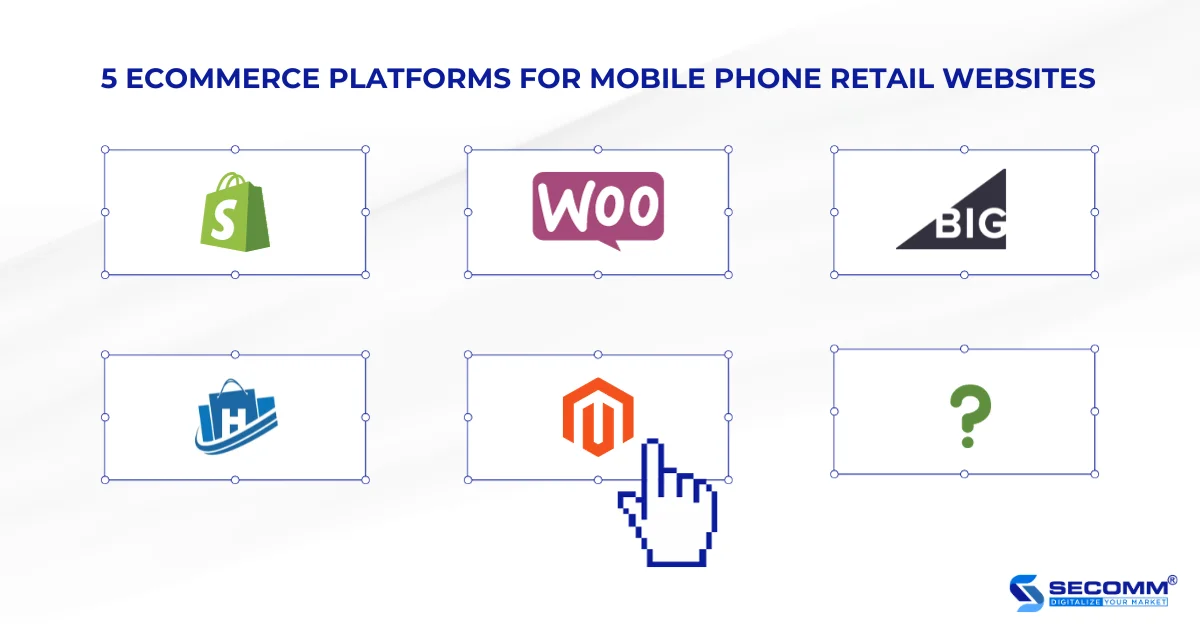
5 ECOMMERCE PLATFORMS FOR MOBILE PHONE RETAIL WEBSITES
In recent times, eCommerce has been increasingly popular in the Vietnamese market and is becoming a potential business model pursued by many enterprises across various industries. Particularly in the mobile phone retail sector, the online market share of mobile phone retail systems is growing rapidly. For instance, The Gioi Di Dong – the largest mobile phone retail system in Vietnam, saw its online market share increase from 11.6% to 17.5% in just one month (from July to August 2021)
Nowadays, many mobile phone retail businesses in Vietnam often choose to implement eCommerce websites as their main channel in online commerce. Thanks to the effective development of website systems, many mobile phone retail businesses have not only seized the opportunity to boost revenue but also achieved sustainable business growth. The common factor contributing to this success lies in the eCommerce platform.
Each type of eCommerce platform has its unique features that can support businesses in developing their online presence. Software as a Service (SaaS) platforms are designed by providers with the entire system pre-built, including hosting, interface, features, and infrastructure maintenance. Therefore, businesses can easily build and operate a website system without much concern for technical issues and without investing too much time and money from the outset.
However, businesses using SaaS platforms will not own the source code and data, and the system’s scalability and integration capabilities are limited. Usage costs may increase over time. On the other hand, open-source platforms give businesses full ownership and control over the source code and data, allowing freedom in designing interfaces and offering high scalability and flexibility. Nevertheless, using open-source platforms often requires a specialized development team and more investment in terms of cost and time.
So, which eCommerce platform will be suitable for mobile phone retail businesses?
The criteria for choosing a platform
User interface and administrative interface
The user interface of an eCommerce system is considered the face and highest scoring aspect in online business. Therefore, besides meeting UI/UX standards and expressing the brand’s characteristics, products, businesses also need to focus on the presentation of product images on the website, ensuring synchronization and clarity.
This ensures a complete and satisfying experience for customers. The admin interface must be user-friendly, allowing easy navigation, control, and management of all data within the system.
A diverse range of eCommerce system features
With online retail of mobile phones, the eCommerce system’s feature set needs to be diverse, ranging from basic to advanced and specialized, aiming to provide an optimal experience for buyers and facilitate the efficient and sustainable development of the eCommerce system.
Some essential functions in the eCommerce website system for mobile phone retail businesses include:
- Basic Functions: Meeting the most basic operational needs of the eCommerce system, such as order management, categories, content, marketing management, customer management, inventory, system management, reporting, checkout, payment, shipping, etc.
- Advanced Functions: Enhancing the consumer experience and expediting the shopping process with features like order tracking, abandoned cart recovery, product suggestions, quick product search, layered product categories, etc.
- Specialized Functions: Addressing specific challenges in implementing eCommerce for mobile phone retail, catering to the unique needs of customer segments and businesses. Examples include Flash sale programs, instalment plans, buy now pay later options, etc.
High integration capability
To have a seamless online business system, businesses often need to integrate eCommerce platforms with other software and technology platforms they are currently using, such as:
- Payment Integration: Integrating various payment methods from domestic to international cards, payment gateways (Paypal, Stripe, OnePay), e-wallets (Momo, ZaloPay), etc.
- Shipping Integration: Integrating international shipping providers (DHL Express, FedEx, UPS, USPS, etc.) and local ones in Vietnam (Giao Hang Nhanh, Giao Hang Tiet Kiem, Ninja Van, etc.). Additionally, order-tracking applications help streamline and operate shipping processes.
- Management Software: Easily integrating CRM, ERP, and POS software for seamless connectivity across all supply channels from offline to online.
- Marketing Management: Integrating additional marketing tools such as email marketing software (MailChimp, Drip…), marketing analytics software (Google Analytics, Google Adwords Keywords…), and social media management software (Buffer, Hootsuite…). Integrating these marketing management tools can help businesses implement marketing campaigns, attract customers, and increase conversion rates to maximize both eCommerce and overall business revenue.
The chosen eCommerce platform must have flexible, seamless, and effective integration capabilities with this software without affecting the execution level of each system. This integration helps businesses overcome the limitations of manual operation and increases automation for both back-office management and sales, ensuring high accuracy and operational efficiency for business development.
High scalability capability
eCommerce platforms need to have high scalability to adapt and grow alongside businesses of all models. Choosing the right platform can accompany businesses from startup and SME stages to becoming large enterprises, and from B2B, B2C, and D2C models to B2B2C, helping save long-term budget while still building a sustainable, efficient system suitable for the business.
High scalability meets all future development needs of the business, such as expanding multiple websites, across countries, currencies, channels, etc. Moreover, platforms with high scalability ensure stable system operation regardless of increasing traffic and transactions over time.
Review 5 eCommerce platforms for mobile phone retail websites
Shopify
Shopify is a well-known giant in the field of building eCommerce systems as a Software as a Service (SaaS). This platform is favoured for its user-friendly nature, quick build time, and low initial costs, making it suitable for many SMEs.
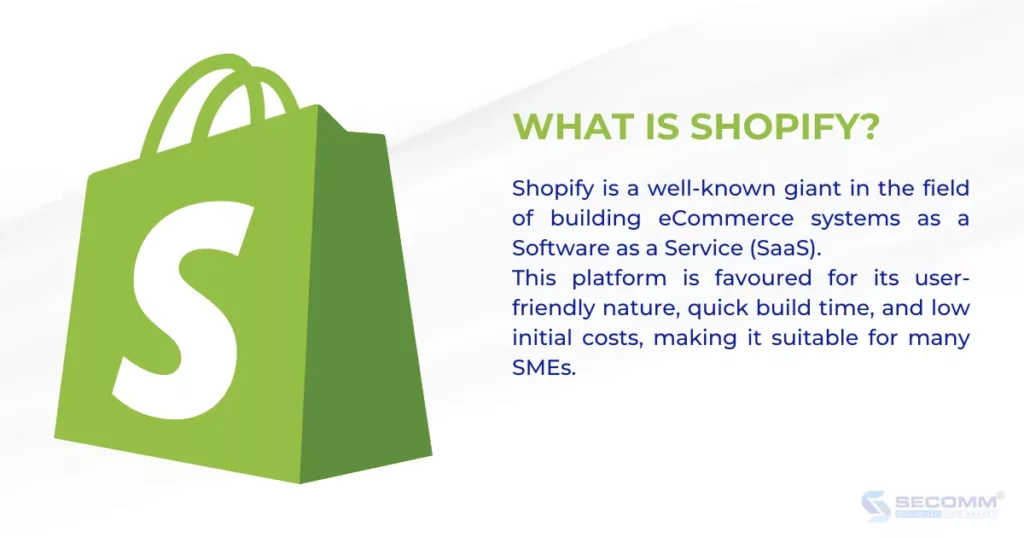
User Interface Criteria
Shopify provides attractive, responsive themes suitable for various industries, including mobile phone retail. While adhering to UI/UX standards, it lacks customization options for businesses to showcase their unique branding.
Admin Interface Criteria
The admin interface is user-friendly on desktops, allowing easy management of the website’s aspects. However, mobile functionality is limited, restricting businesses to perform specific functions on the mobile version.
Functionality System Criteria
Shopify’s functionality system is comprehensive, meeting both the basic and advanced needs of small and medium-sized enterprises. However, accessing advanced features requires additional monthly payments, leading to increasing usage costs. Shopify, however, lacks certain features crucial for mobile phone retail, aside from instalment payment options.
Integration Capability Criteria
Shopify restricts access to the source code, making integration with third-party software challenging. Businesses can only integrate with partner software available on the platform or those directly developed by Shopify.
Scalability Criteria
Scalability on the Shopify platform is limited because businesses cannot modify or upgrade the website source code. Therefore, it’s often used by mobile phone retail businesses in their early stages.
Usage Cost Criteria
Shopify offers various service packages to cater to different business needs, ranging from $29/month for Basic Shopify to $2000/month for Shopify Plus. However, businesses may face limitations in advanced features, necessitating a platform switch for a specialized and sustainable system.
→ Overall Rating based on 5 criteria: 2/5
Shopify is suitable for SMEs that want a cost-effective and quick eCommerce system. However, it falls short in advanced features, specific functionalities, and customization options. Businesses must accept the limitations and be prepared to switch platforms for a tailored and sustainable solution in the future.
WooCommerce
WooCommerce is an open-source CMS plugin for WordPress introduced in 2011, completely free, enabling businesses to turn their WordPress websites into online stores.
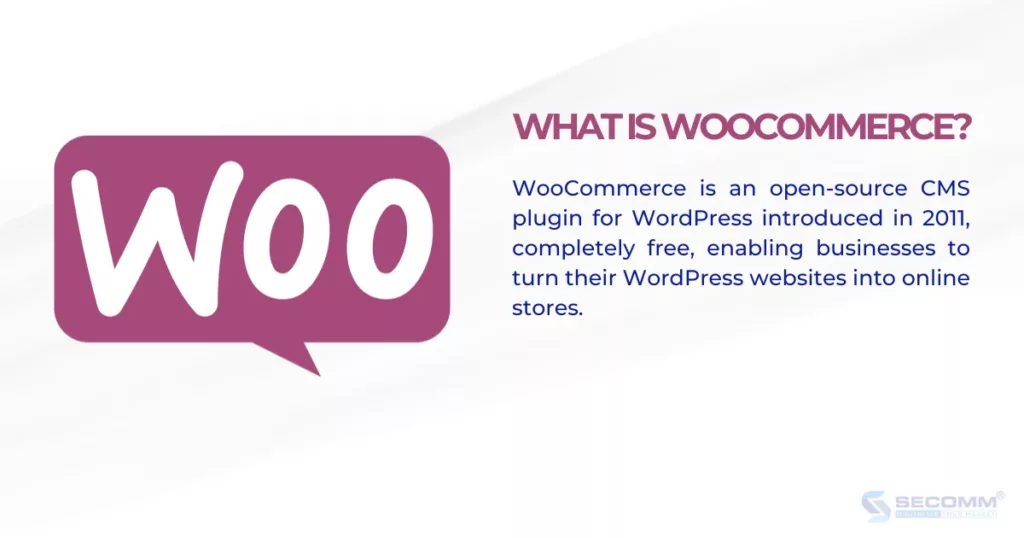
User Interface Criteria
WooCommerce offers a diverse library of templates for mobile phone retail and electronic goods, designed meticulously and user-friendly. This allows businesses to conveniently design and build an eCommerce system from the start without requiring in-depth technical knowledge.
Because WooCommerce is a WordPress plugin, administrators continue to manage the website through the WordPress interface, making it easy for businesses already using WordPress to adapt, use, and navigate the system.
Functionality System Criteria
WooCommerce has many features, both basic and advanced, to support businesses in operating an eCommerce website. However, the platform has some limitations regarding specific features for mobile phone retail. Although it’s open-source, developing unique features on WooCommerce can be challenging and may lead to system instability.
Integration Capability Criteria
Third-party software integrates well with WooCommerce, helping businesses save time, and costs, improve operational efficiency, and automate management processes.
- Payment: Stripe, PayPal, Apple Pay, and Square…
- Shipping: USPS, UPS, and FedEx…
- Management Software: Odoo, Square POS, and WP ERP.
- Marketing Management: Google Listings, Google Ads, Facebook Pixel…
Scalability Criteria
WooCommerce’s most significant drawback is its limited scalability. The platform tends to become unstable and easily overloaded when there are more than 2,000 SKUs or too many themes and plugins on the system.
Usage Cost Criteria
WooCommerce is an open-source platform, so it’s entirely free to use. However, businesses need to pay for additional services such as domain registration ($15), hosting fees ($120/year), and system development costs (ranging from $3,000 to $10,000, depending on system complexity).
→ Overall Rating based on 5 criteria: 3/5
WooCommerce is a good platform for businesses currently using WordPress and looking to develop an eCommerce system. However, the platform has limitations in customization and adjusting unique features. Intervening in the system is likely to cause instability, and there is a high probability that the built-in features are not compatible with the platform. Additionally, to customize the system based on the existing feature set, businesses will need to invest a significant budget and time.
BigCommerce
BigCommerce is a SaaS platform based in the USA with over 600,000 online stores used by consumers worldwide.
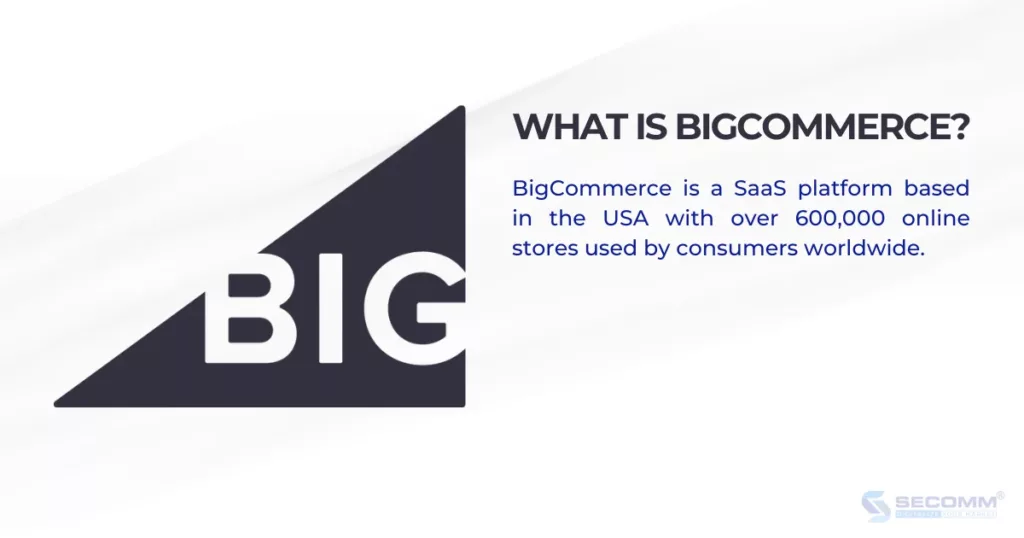
User Interface Criteria
BigCommerce possesses a diverse theme repository with over 160 templates, catering to various industries, including mobile phone retail and electronics. All these templates are designed following UI/UX standards, allowing for easy adjustments to fit the brand.
For the administrator interface, businesses can manage their stores on a real-time and easily trackable screen.
Functionality System Criteria
BigCommerce’s functionality is relatively comprehensive, meeting basic and advanced needs, as well as specific features for mobile phone retail businesses. However, since BigCommerce is a SaaS platform, businesses cannot modify the source code or develop additional features not already available on the platform. Businesses can only use the features provided by BigCommerce or those offered by the platform’s partners.
Some notable advanced and specific features available on BigCommerce suitable for mobile phone retail businesses include multi-currency support, advanced SEO, rating and review features, advanced reporting, and instalment payment capabilities.
Integration Capability Criteria
BigCommerce has a relatively high integration capability, allowing integration with many popular third-party software to support business operations.
Some software that can be integrated with BigCommerce includes various payment gateways (Stripe, PayPal, ApplePay, Checkout), shipping solutions (ShipStation, Amazon Shipping, Easyship, Route), ERP systems (NetSuite ERP, Acumatica Cloud ERP), CRM (HubSpot, Revamp), and marketing tools (email marketing, social media integration).
Scalability Criteria
The system’s scalability depends on the BigCommerce service package that the business is using. The platform can support business expansion into new markets, multiple currencies, and languages. Additionally, BigCommerce can support stable system operations for businesses handling thousands of SKUs.
Usage Cost Criteria
BigCommerce currently supports three bundled solutions and one on-demand solution:
- Standard Plan: $29.95/month, suitable for businesses with sales over $50,000
- Plus Plan: $79.95/month, suitable for businesses with sales over $180,000
- Pro Plan: $299.95/month, suitable for businesses with sales over $400,000
- Enterprise Plan: for large enterprises, and the cost will be based on the online sales volume of the brand.
→ Overall Rating based on 5 criteria: 3/5
BigCommerce is almost a comprehensive SaaS platform for businesses entering the mobile phone retail eCommerce journey. The platform can be suitable for various business models, including B2B, B2C, and B2B2C, depending on the chosen subscription package. However, the limitation of using this platform is that businesses are restricted in their ability to customize functions on the system, limited in annual revenue with each subscription tier, and unable to own the source code.
Haravan
Haravan, founded in 2014, stands as one of the renowned platforms in the Vietnamese market, boasting over 50,000 businesses and consumer brands. It operates as a service platform modelled on Shopify.
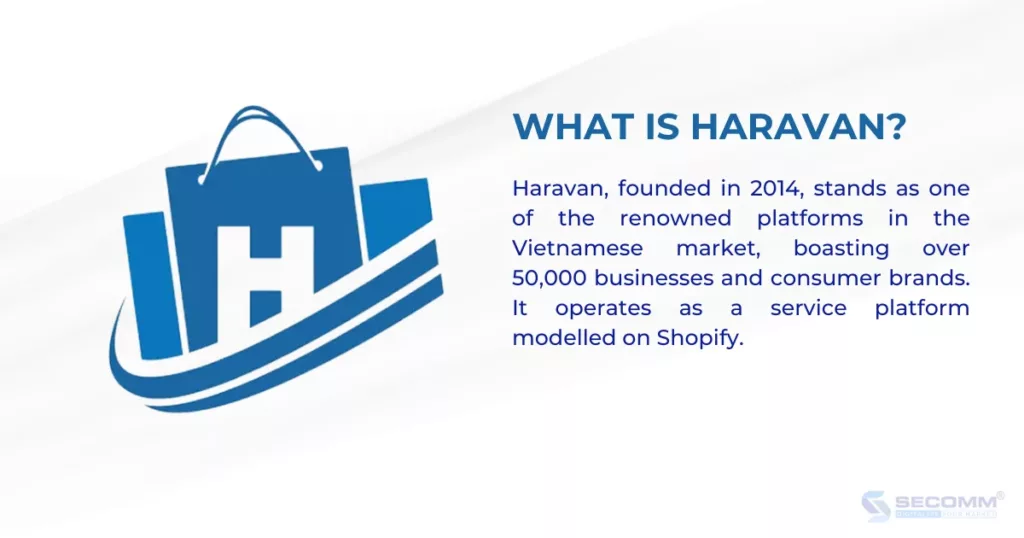
User Interface Criteria
Similar to other SaaS platforms, Haravan boasts a diverse theme repository with over 400 templates, all designed following UX/UI standards. Beyond that, businesses can customize the interface to align with their distinctive brand identity. The admin interface, supporting the Vietnamese language, ensures a user-friendly experience for businesses.
Functionality System Criteria
Haravan offers a comprehensive set of both basic and advanced features, enabling businesses to swiftly establish an eCommerce website. The platform includes specific functionalities tailored for mobile phone retail, such as installment payment options. However, akin to Shopify and BigCommerce, businesses cannot develop additional features beyond what Haravan offers in its repository.
Integration Capability Criteria
Integration with third-party utilities outside Haravan’s ecosystem can be challenging, representing a significant limitation of service-type platforms. However, it does support integration with widely used services in Vietnam, including various payment methods (Momo, VNPay, ZaloPay, etc.), shipping services (Giao Hàng Nhanh, Viettel Post, DHL), and management tools (CRMViet, Teamcrop).
Scalability Criteria
Haravan’s scalability is limited; it supports multilingual and multi-currency features but lacks the capability to expand to multiple websites or efficiently manage extensive data on the platform.
Usage Cost Criteria
To use Haravan, businesses need to pay a reasonable monthly fee ranging from 200,000 VND to 3,000,000 VND, depending on business needs:
- Standard: 200,000 VND/month for individual sellers
- Pro: 600,000 VND/month for businesses wanting to implement Omnichannel
- Grow: 1,500,000 VND/month with the advantage of automating customer care and re-engagement programs
- Scale: 3,000,000 VND/month to build a loyal customer base.
→ Overall Rating based on 5 criteria: 3/5
Haravan is a suitable platform for businesses in Vietnam with limited technology experience and budget constraints. However, as businesses grow, Haravan may not provide sufficient functionality to sustain operations. Eventually, transitioning to more specialized platforms like Magento, WooCommerce, or OpenCart becomes necessary, albeit with challenges such as costs, time, and human resources.
Magento
Magento is an open-source eCommerce platform with deep expertise in online commerce. It currently offers two versions: Open Source (free) and Commerce (paid). Recognized as one of the most comprehensive eCommerce platforms, Magento boasts diverse features, high flexibility, scalability, a diverse ecosystem, and optimal security.
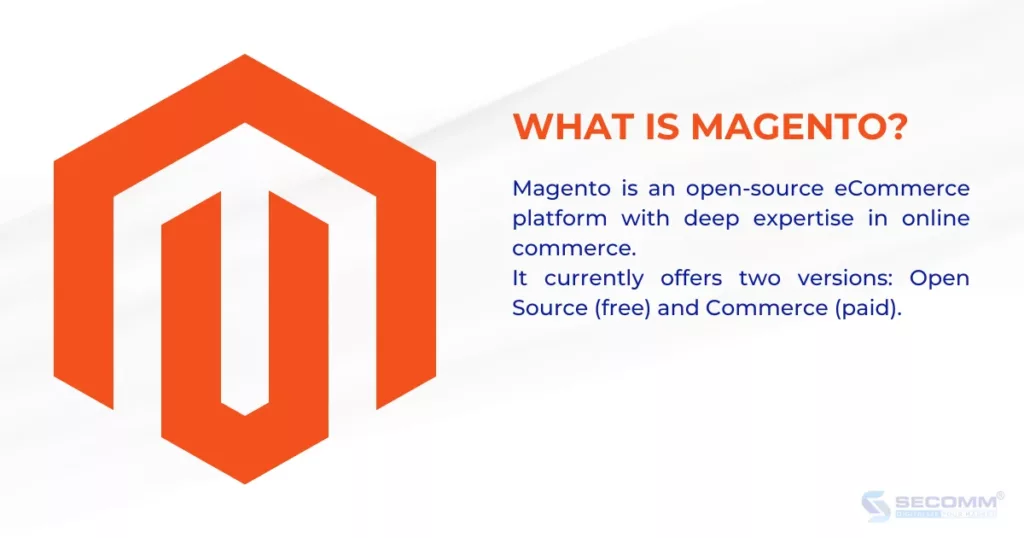
User Interface Criteria
Unlike other platforms, Magento doesn’t have an extensive theme repository. However, each theme is meticulously designed, unique, adheres to UX/UI standards, and emphasizes high aesthetics to convey brand and product values, attracting customers to the system.
Businesses can save costs and time by using available themes, while also having the option to customize for brand identity. Additionally, businesses can fully design their interface, enhancing brand recognition, though this requires careful investment in design time and costs.
For the admin interface, Magento 1 was criticized for being challenging to use. However, Magento 2 introduced a more intuitive dashboard, making navigation easier, user-friendly, and adaptable.
Functionality System Criteria
Magento’s eCommerce platform has a diverse and deep feature system, catering from basic to advanced and specific functions. This allows mobile phone retail businesses to easily and rapidly build and develop their system in the short and long term. Basic functions include Category Management, Content Management, Customer Management, Marketing Management, Order Management, Store Management, System Management, Cart and Checkout, and Reporting & Analysis.
Specialized features include support for multiple languages, currencies, stores, Progressive Web Applications (PWA), Multi-Source Inventory (MSI), ElasticSearch, etc., enhancing the customer experience and accelerating the shopping process.
Integration Capability Criteria
Magento excels in easy integration with third-party software for payments (credit cards, e-wallets, payment gateways, cash on delivery), shipping (Fedex, DHL, local carriers), management software (POS, CRM, ERP), and marketing tools (email marketing, advertising).
Scalability Criteria
Magento ensures stable system operation even with increasing traffic over time or sudden spikes in business campaigns. It can handle up to 500,000 products and thousands of transactions within an hour. Magento supports the expansion of multiple websites for various countries, all manageable on one screen, allowing businesses to access and manage data for multiple websites/stores simultaneously.
Usage Cost Criteria
One significant limitation for mobile phone retailers opting for Magento is the high initial development cost. A fully functional Magento system development is estimated to range from $10,000 to $100,000. Beyond complex and advanced features, the need for an experienced professional team contributes to the higher implementation costs compared to other platforms.
→ Overall Rating based on 5 criteria: 4/5
Magento is a comprehensive platform suitable for mobile phone retail businesses, whether B2B, B2C, or D2C, especially those with an existing customer base and a desire to develop a long-term eCommerce system. With Magento, businesses can continuously develop components of the eCommerce system, ensuring optimal performance and sustainable growth.
Choosing the right platform for eCommerce is crucial for mobile phone retailers. An accurate choice helps businesses shorten development time, save costs, and maximize resources to achieve the highest revenue levels. SECOMM understands the challenges facing mobile phone retail businesses and provides expert advice.
Contact SECOMM now for a free consultation!
 2
2

 8,285
8,285

 0
0

 1
1
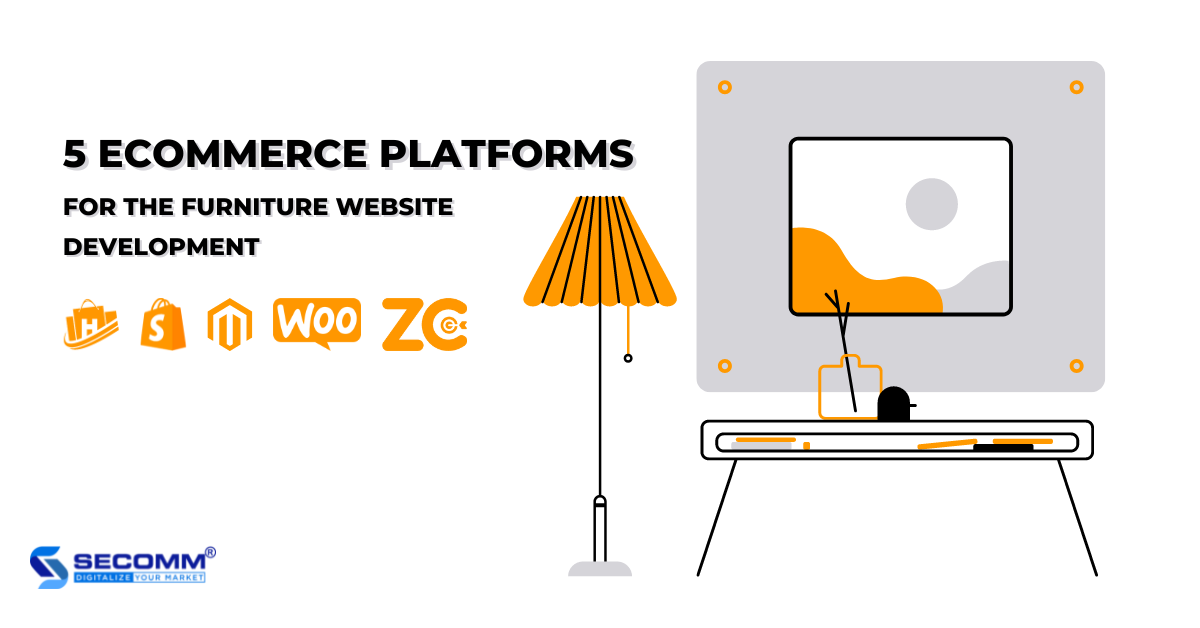
5 ECOMMERCE PLATFORMS FOR THE FURNITURE WEBSITE DEVELOPMENT
eCommerce is currently developing into a fresh and promising sales channel for furniture companies in addition to the traditional sales channel. Businesses must work hard to sustain and achieve breakthrough growth through eCommerce platforms, though.
As a result, numerous furniture companies started developing online furniture business websites and found surprising success, such Sieu Thi Noi That va Trang Tri Baya, Nha Xinh, Cozy, or Noi Phat Hoa Phat.
These websites’ success can be attributed to their early selection of an adequate and suitable eCommerce platform. Which platforms are appropriate for the furniture industry, then?
Main aspects of the eCommerce furniture industry
UI/UX standard furniture eCommerce website interface
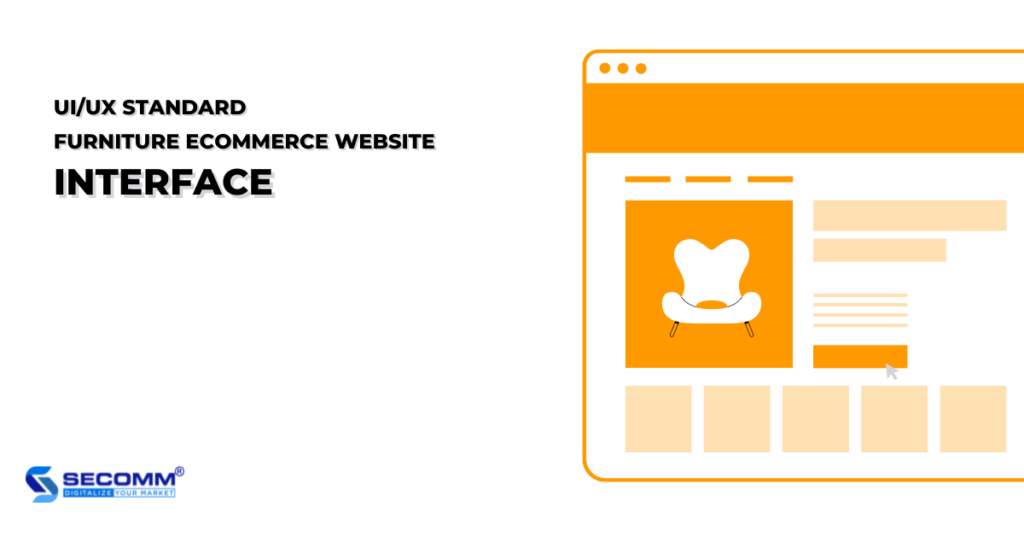
The first criterion businesses set when developing an eCommerce website is a standard UI / UX interface, friendly to users who enjoy shopping for furniture online and other home goods to increase customer interaction.
Similar to eCommerce websites in other sectors like fashion, electronics, etc., websites in the furniture sector must feature stunning and high-quality photographs and videos.
This makes it simpler for companies to communicate product information to customers, especially with banner advertisements that have an easy-to-use interface and a pleasing style that will pique shoppers’ interests.
Businesses also need to consider other concerns including call-to-action button placement, cross-device compatibility, and layout designs that display a range of product designs from the navigation bar to page-by-page details.
Comprehensive functional system
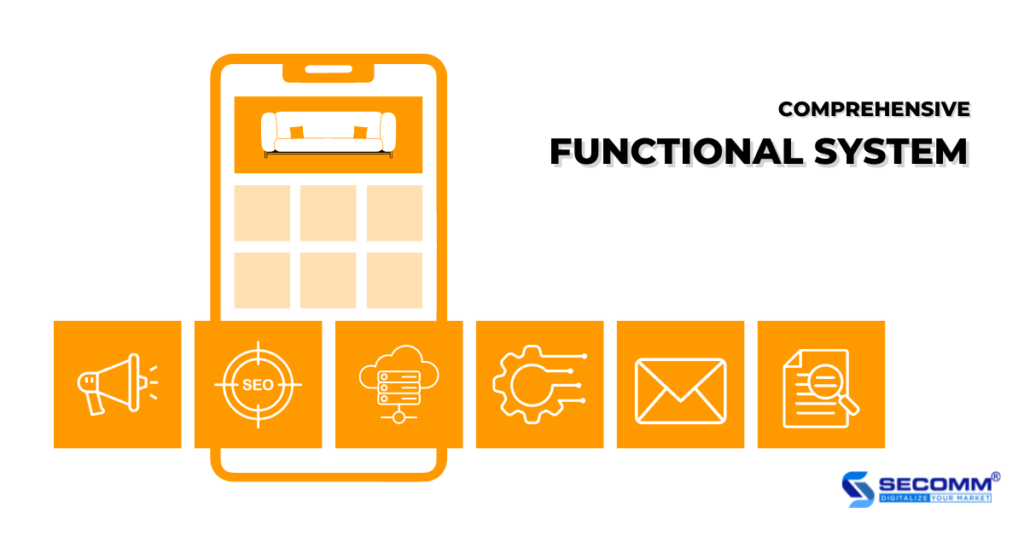
Furniture firms need a functional system from basic to advanced to fully meet consumers’ buying expectations and maximize the user experience. This system should include:
- Catalog Management: Manage properties, pricing systems, inventory, photos, and videos to keep them running
- Content Management: Content development for CMS pages, image hosting, theme customization, and website design
- Customer Management: Control information, behavior, and consumption habits to build strategies for each specific customer group
- Sales Management: Set up and operate sales, order, payment, and shipping processes
- Marketing Management: Implement and optimize programs to attract potential customers with built-in support tools
- System Management: Seamless supply chain response with shipping navigation and automation management tools
- Store Management: Navigate and maintain your eCommerce business from online to offline
- Cart & Checkout: Manage shopping carts and process the next payment steps for customers
- Analytics and Reports: Monitor and measure eCommerce performance to give detailed reports to improve business efficiency
Businesses also need to develop some additional specialized features to address the furniture industry’s “own challenge,” such as:
- Omnichannel to track customer footprints across all channels from eCommerce platforms, and social networks, to eCommerce websites and mobile apps to deliver a seamless shopping experience.
- VR/AR or 360-degree view brings a visual experience and realistic visualization of the product, thereby enhancing the online furniture shopping experience.
- Customers who request customized products can specify the colors, materials, and sizes they want and pay a deposit. The supplier will then continue to produce the furniture items in accordance with the requirements and deliver them to the customer once they are finished. The consumer will then pay the supplier the balance at that time.
Integration with a variety of third-party services
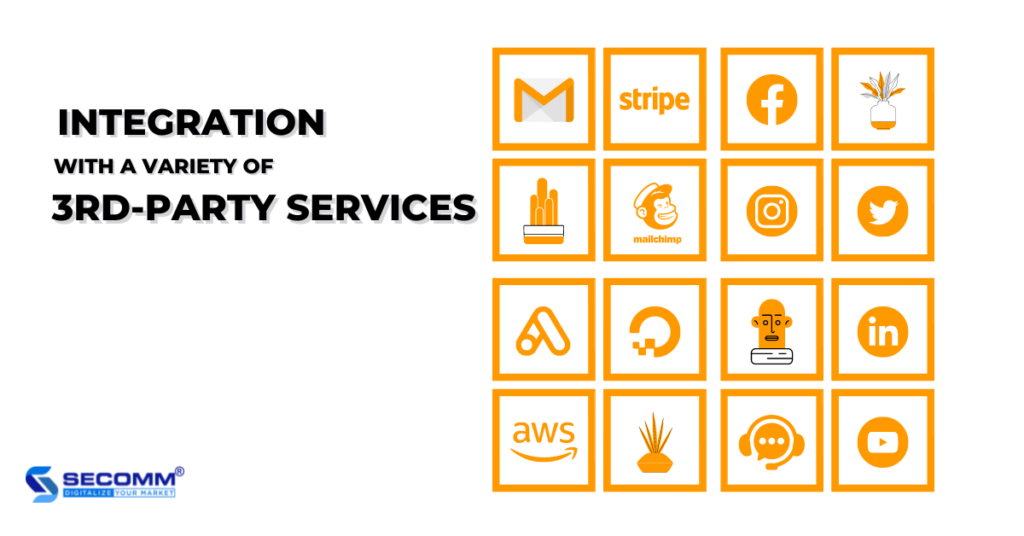
Furniture businesses frequently integrate a range of payment options, shipping services, management software, and business analysis tools to optimize eCommerce business systems in order to provide customers with a comprehensive shopping experience.
Some popular payment methods businesses can integrate on the website to diversify payment methods to help customers have many choices such as card payment; eWallet; payment gateways.
Businesses might take into consideration software like ERP (SAP, Salesforce, Oracle), among others, when integrating back-office administration and operation software.
Finally, incorporating BI tools like Tableau, Looker, etc. will aid in the long-term analysis of business plans.
Scalability of the website
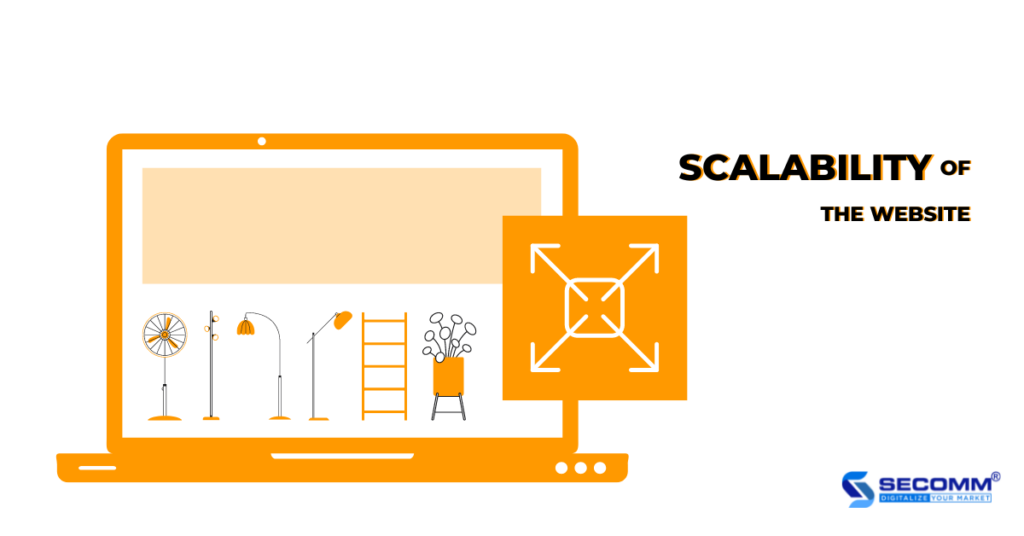
Businesses that are just starting to use eCommerce won’t concentrate on the website’s scalability in the future because platforms that provide this feature are sometimes hard to find. But tactically, spending money on a platform that facilitates this function will provide organizations an advantage over rivals in the market.
These aid furniture companies in making necessary adjustments, creating new features, and expanding their online systems to support several stores, languages, and currencies in the future.
Top 5 eCommerce platforms for furniture website development
Haravan
Haravan was founded in 2014 and is a very popular and popular eCommerce deployment platform in the Vietnam market with a variety of solutions for businesses and individual sellers.
Pros:
- Available and diverse themes for the furniture industry
- Wide range of applications, from basic to advanced to start an eCommerce business
- Reasonable eCommerce deployment cost, various packages from 200,000 VND/month to 3,000,000 VND/month, making it easy for customers to choose.
- Time to build an eCommerce website is fast, only about 30 minutes for businesses to own a website with all the necessary features to get started. However, for the website to work effectively, businesses need to spend more time researching and developing the system.
Cons:
- The layout of existing templates causes duplicating, and it’s challenging to alter themes or create your own interface because doing so will have an adverse effect on the entire system.
- The system of specific functions for the furniture sector is still limited.
- Only integrated with services/utilities located in Haravan’s ecosystem.
- Because it is a SaaS platform, it will be difficult for Haravan to expand the website in the future.
=> Rating: 2/4
Haravan is suitable for start-up furniture businesses or SMEs (small and medium-sized enterprises) with operations mainly in Vietnam.
Shopify
Shopify is a popular SaaS platform in the world that provides a variety of solutions for businesses of all sizes to successfully build eCommerce websites.
Pros:
- Available and diverse themes for the furniture industry.
- Wide range of applications, from basic to advanced to start an eCommerce business.
- The initial cost is quite reasonable with a variety of options for businesses from $29/month to about $2,000/month.
- The time to build an eCommerce website is quite fast from 1-7 days, or more depending on the complexity of the system.
- Shopify has a large developer community to serve businesses.
Cons:
- The layout of existing templates causes duplicating, and it’s challenging to alter themes or create your own interface because doing so will have an adverse effect on the entire system.
- The system of specific functions for the furniture sector is still limited.
- A wider range of 3rd party services than Haravan but still only integrated with services available in Shopify’s app store.
- Deployment costs are both advantages and disadvantages of Shopify when the initial cost is quite reasonable, but in the long run, businesses have to pay the cost of using the platform, interface, application, etc., regularly every month. This makes it difficult to manage cash flow
- Because it is a SaaS platform, it will be difficult for Shopify to expand its website in the future.
=> Rating: 2/4
Shopify is considered suitable for start-ups or SMEs with global operations.
ZielCommerce
ZielCommerce is an eCommerce platform with ready-made solutions specialized for the furniture industry.
Pros:
- Many themes are specific to the furniture industry, allowing businesses to customize according to their needs, helping to reflect the characteristics of the industry and position the brand image.
- Detailed internal eCommerce website construction challenges can be solved with the help of a comprehensive system of functions that combines the fundamental, sophisticated, and niche aspects of both customer and business needs, such as the best order processing system.
Cons:
- The ability to integrate with 3rd party services is still limited. This platform only supports add-ons available in its ecosystem, so businesses will not be able to link with the ERP, POS, CRM, BI, etc. Therefore, when using Ziel Commerce, businesses need to transfer all existing data to the platform’s servers.
- Although highly appreciated for the ability to expand the website system, this is still the disadvantage of Ziel Commerce in the long run. Accordingly, this platform will not support businesses to expand or develop new features because businesses cannot own the source code, so when affected, it will destabilize the entire website system.
- Ziel Commerce is not yet popular in the Vietnam market, so there is no Vietnamese version yet.
- Deployment time will depend on the complexity of the system, the average time is from 3-6 months.
- High implementation cost of about $50,000 per project.
=> Rating: 3/4
ZielCommerce will be the optimal choice for B2B, and B2C furniture businesses to deploy eCommerce websites or build mobile apps. However, this platform is not really popular in the Vietnamese market but is especially favored by foreign furniture retailers such as Frampo, Zeyka, etc.
WooCommerce
WooCommerce is a free WordPress plugin that allows businesses to transform a regular WordPress website into a professional eCommerce website with full features and easy customization with just a few simple steps.
Pros:
- There are many free and premium themes from the WordPress and WooCommerce communities for the furniture sector which are easy to customize or businesses can use self-designed themes.
- Functional system from basic to advanced for eCommerce business.
- Easy integration with a variety of 3rd party services.
- Because it is an open-source code platform, businesses can plan to expand their website in the future.
- The cost of building an eCommerce website is not too high compared to other open-source platforms like Magento, with total annual costs ranging from $110 to $1,500+ for domains, hosting, themes, extensions, plugins, etc.
- eCommerce website implementation time with WooCommerce takes about 1 to 3 months to complete.
Cons:
- The functional system is still limited in terms of features specific to the furniture industry.
- The scalability is not as high compared to other open-source platforms such as Open Cart, Magento because it depends on the WordPress system.
=> Rating: 3/4
WooCommerce will be suitable for furniture businesses who are familiar with the WordPress platform and want to develop an eCommerce system.
Magento
Magento is a popular open-source commerce platform in the field of eCommerce, with nearly 200,000 websites in use. Currently, Magento has 2 versions: Magento Open Source (free), and Magento Commerce (paid).
Pros:
- Many furniture themes from the global developer community and Magento website developers so businesses can use existing themes which easy to customize or use self-designed themes.
- Easy integration with a variety of 3rd party services.
- High scalability: multi-language, currency, easy future feature development.
Cons:
- There is no repository of themes from Magento to support businesses.
- Implementation typically takes three to six months, but it might take up to a year due to a sophisticated functioning system.
- Although the platform is free to use, the cost of implementing eCommerce with Magento is quite high, about $50,000-$100,000 depending on the complexity of the project.
=> Rating: 4/4
Magento is appropriate for a range of furniture business types, including B2B, B2C, and B2B2C, as well as for various business sizes, including start-ups, SMEs, and major companies. However, large organizations use Magento because it is frequently relatively expensive to deploy.
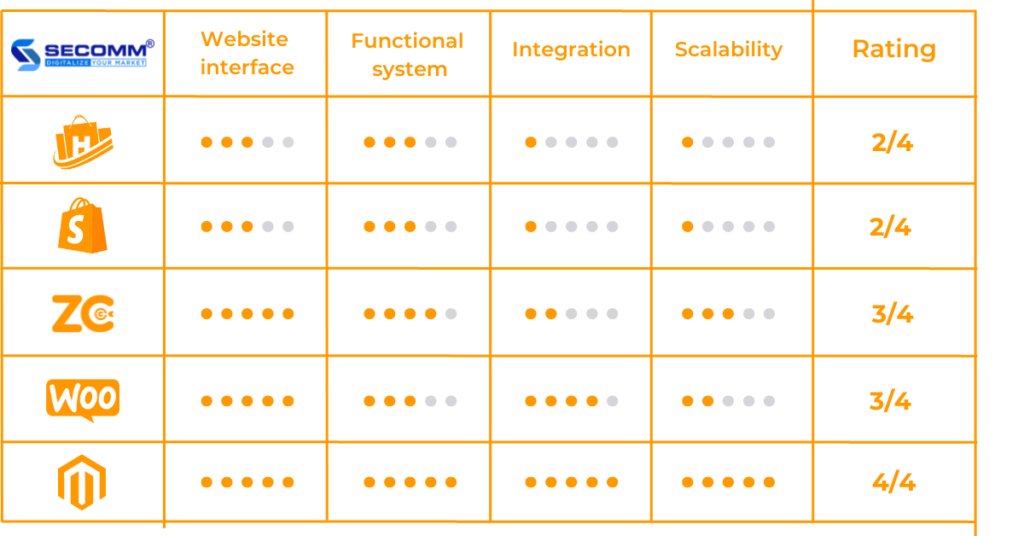
Choosing the right platform is an extremely important first step when building an interior eCommerce website. Choosing the right eCommerce platform will help businesses save budget and time to build a website while increasing competitive advantage and sustainable growth. On the contrary, when choosing the wrong platform, it will cost businesses a lot of time and budget to deploy and switch platforms many times. Therefore, businesses need to consider the goals and problems in the current model to be able to choose the most suitable platform.
With many years of experience in successfully implementing eCommerce for many customers in many countries, SECOMM specializes in providing consulting services with comprehensive and professional eCommerce implementation solutions.
Contact SECOMM today for free support and advice.
 2
2

 2,467
2,467

 0
0

 1
1
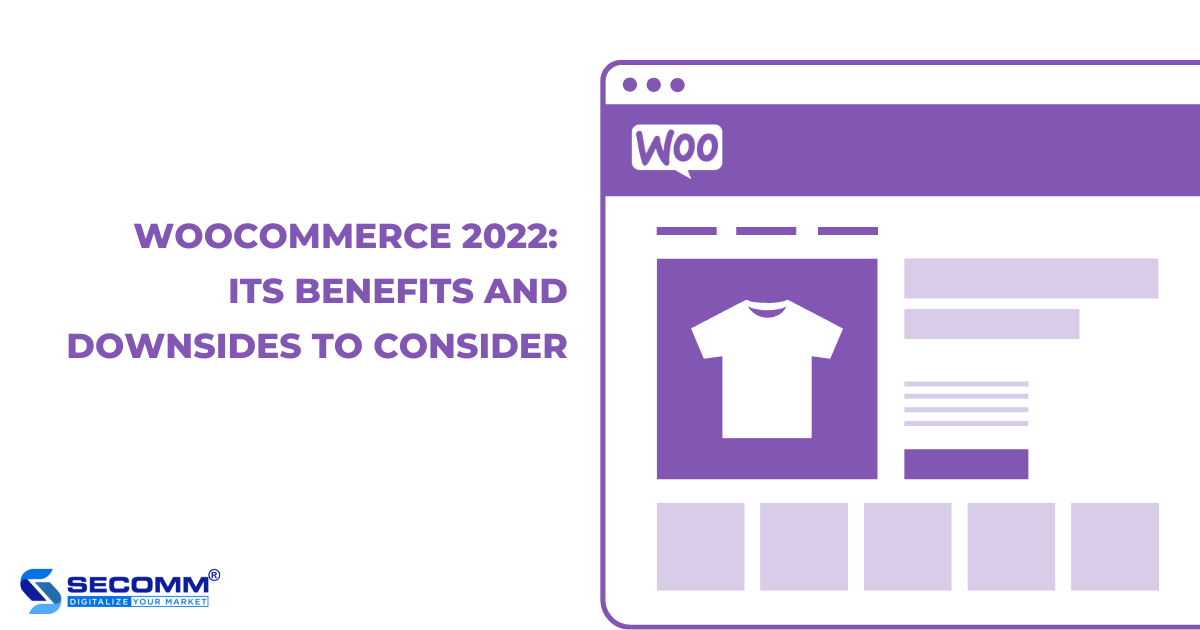
WHAT IS WOOCOMMERCE? 8 KEY PROS AND CONS OF WOOCOMMERCE
As eCommerce becomes a new trend that encourages a slew of brands to enter the market, selecting the right eCommerce platform to build a successful eCommerce website becomes critical. While Shopify is the most popular SaaS platform, Magento is the top choice in the open-source platform, and the WooCommerce plugin has won the trust of many brands due to its outstanding features and ease of use.
What is WooCommerce?
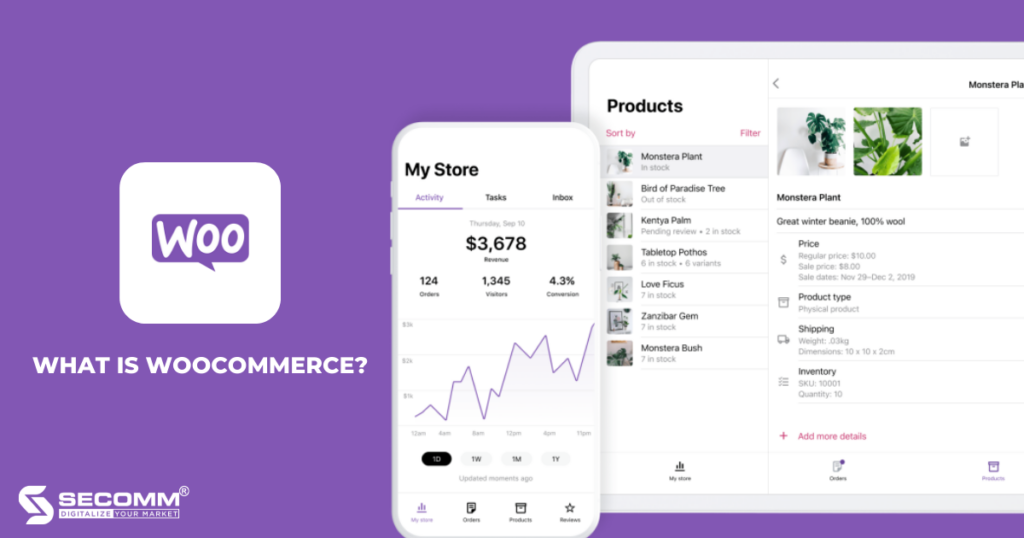
WooCommerce is a free WordPress plugin that allows brands to set up an eCommerce website by adding eCommerce functionality to an existing WordPress site. This plugin can transform a regular WordPress website into an eCommerce website with all the necessary features and easy customization with just a few clicks.
The benefits of using WooCommerce
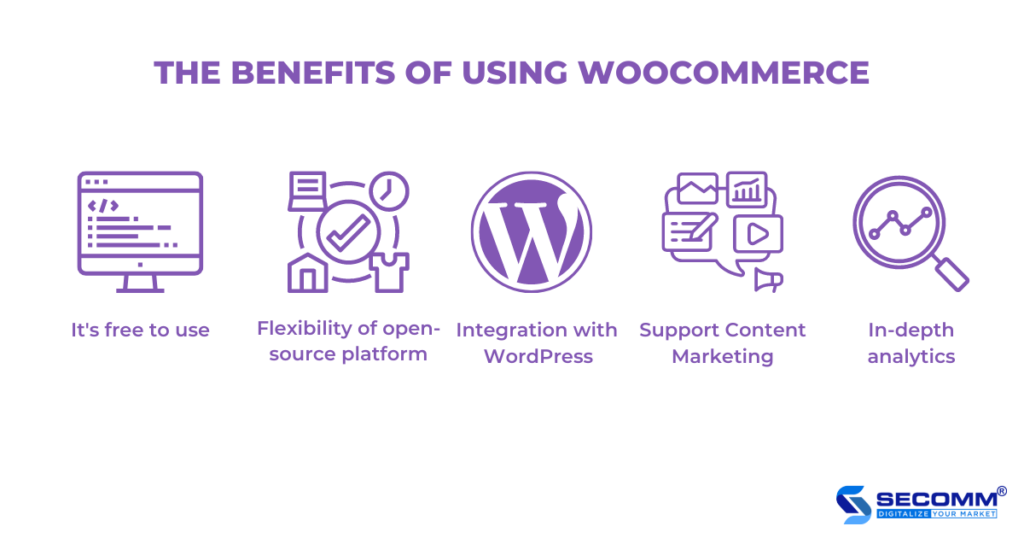
It’s free to get started
Price is an essential factor to think about when selecting a platform for implementing eCommerce. Popular platforms on the market today have prices ranging from free to several thousand dollars per year, making it even more prominent and preferred by businesses because this plugin is entirely free to download and install.
As a result, any business can benefit from its features without committing to costly support contracts or software licenses.
The flexibility of the open-source platform
It is an open-source plugin built on the WordPress CMS that gives users complete control and allows them to easily customize their eCommerce website to their specific needs. WooCommerce, in addition to being suitable for a variety of businesses serving different customer segments, also provides long-term scalability, giving businesses of all sizes more flexibility in deploying eCommerce.
Integration with WordPress
The seamless integration between WooCommerce and WordPress brings many benefits to this plugin because of the availability of the large WordPress community throughout the years. WooCommerce can take advantage of the platform’s massive ecosystem of plugins, themes, guides, and other unique features.
Yoast SEO, for example, has long been a well-liked plugin with numerous international translations, ease of use, and advanced SEO support. Since WooCommerce integrates with WordPress, Yoast SEO also integrates with WooCommerce.
Especially when a business has a website on the WordPress platform and needs to turn it into an eCommerce website, WooCommerce will make it easy and seamless, so users do not have to start over with a brand new platform.
Providing qualified-standard content management
Content Marketing is the key to an effective eCommerce website. If businesses are looking for an eCommerce platform built on the world’s most popular content management system (CMS), WooCommerce can fulfill that expectation.
When the WooCommerce plugin is integrated into WordPress, many content management options, including Blogs, Landing Pages, Product Descriptions, Email Marketing, and SEO plugins (Yoast WooCommerce SEO), will help sellers optimize content for search.
Providing in-depth analytics
Integrated analytics is another advantage of the plugin because the more you learn about customers and how they interact with your eCommerce website, the more you can adjust to meet customer expectations. For example, businesses can use sales data to learn about customers, thereby establishing a customer persona to increase sales in the future.
Furthermore, it provides a comprehensive WooCommerce analyzer displayed in a clean and user-friendly interface. Businesses can then easily integrate WooCommerce with third-party analytics services such as Google Analytics, Google Tag Manager, and others.
The downsides of using WooCommerce
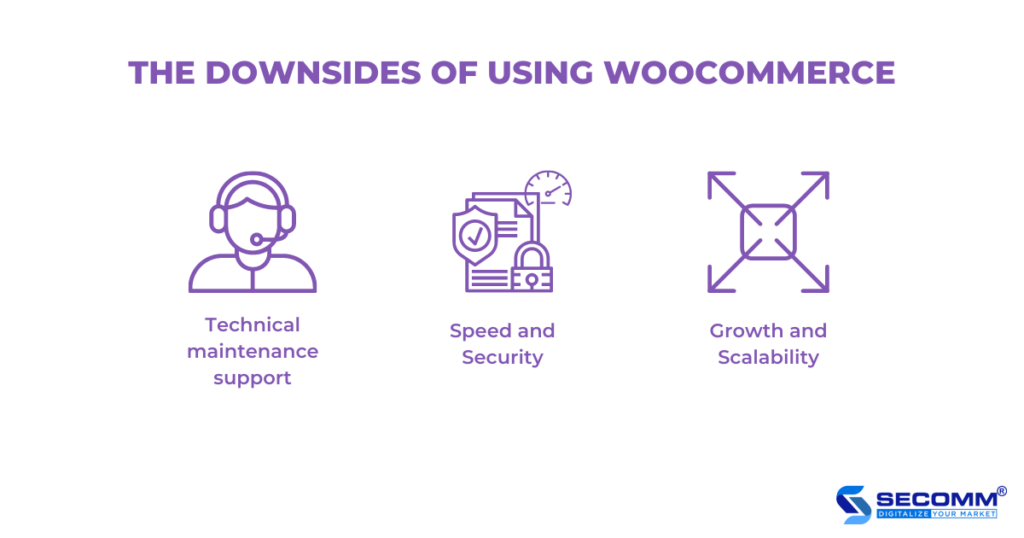
Technical maintenance support
When using this plugin, the user is responsible for keeping the eCommerce website up-to-date, accessible, and functional. In fact, there is some support from the hosting company and the WooCommerce community, but it does not allow users to simply call for technical assistance.
Plugins will notify users of security updates, but users must install and handle problems themselves. In fact, hosting companies will support this. Still, users need to have a bit of technical knowledge to facilitate the process of supporting related issues to avoid affecting the performance of the eCommerce website.
This disadvantage stems directly from the fact that businesses have complete control over the eCommerce website system’s source code and data. Maximum authority entails maximum accountability. Although businesses continue to receive support for WooCommerce issues, compared to other eCommerce platforms such as Shopify, BigCommerce, Magento, etc., WooCommerce still has many shortcomings in the technical maintenance support process.
Speed and Security
With the constant increase in unauthorized access (Website Hacking), website speed and security are more critical than ever. Speed and security are significant advantages for SaaS platforms such as Shopify and BigCommerce. At that point, your eCommerce website is housed in the infrastructure of these platforms, and a team of technical experts will continuously monitor and resolve any issues that arise to keep the website running smoothly.
Similar to a technical maintenance situation, WooCommerce essentially leaves the user responsible for the speed and security of the website despite the wide range of 3rd party support options.
Although speed and security are not an issue for some new businesses deploying eCommerce websites, this is still a significant drawback of this plugin when businesses are responsible for many issues ranging from technical maintenance to website speed and security, especially if the eCommerce site is on the verge of rapidly growing from hundreds to thousands of hits.
Growth and Scalability
Because it is a WordPress plugin, it will operate in accordance with WordPress functions. Meanwhile, WordPress functionality is not explicitly designed for eCommerce but rather is based on the flexibility of open-source code. This means that when a user exceeds a certain query threshold, the way WooCommerce works is broken.
For example, when a large number of shopping carts are added, or checkout occurs at the same time, or when too many users visit the website simultaneously, overload occurs, making the operation of the eCommerce website difficult. This is difficult because the WordPress system and the WooCommerce plugin are no longer compatible.
If your eCommerce website is still small and growing, this is not a problem; problems can still be quickly resolved. However, as the size of your website expands and grows rapidly, this is a disadvantage in terms of both performance and cost that businesses must consider before proceeding.
In a nutshell, WooCommerce is a fantastic plugin that many businesses would love to choose when deploying an eCommerce website. However, besides the outstanding advantages, there are still certain downsides, so businesses must carefully consider and compare with other platforms before starting out.
With many years of experience implementing eCommerce in many countries, SECOMM provides free consulting services with professional eCommerce solutions.
Contact us today for free support and advice!
 2
2

 2,308
2,308

 1
1

 1
1
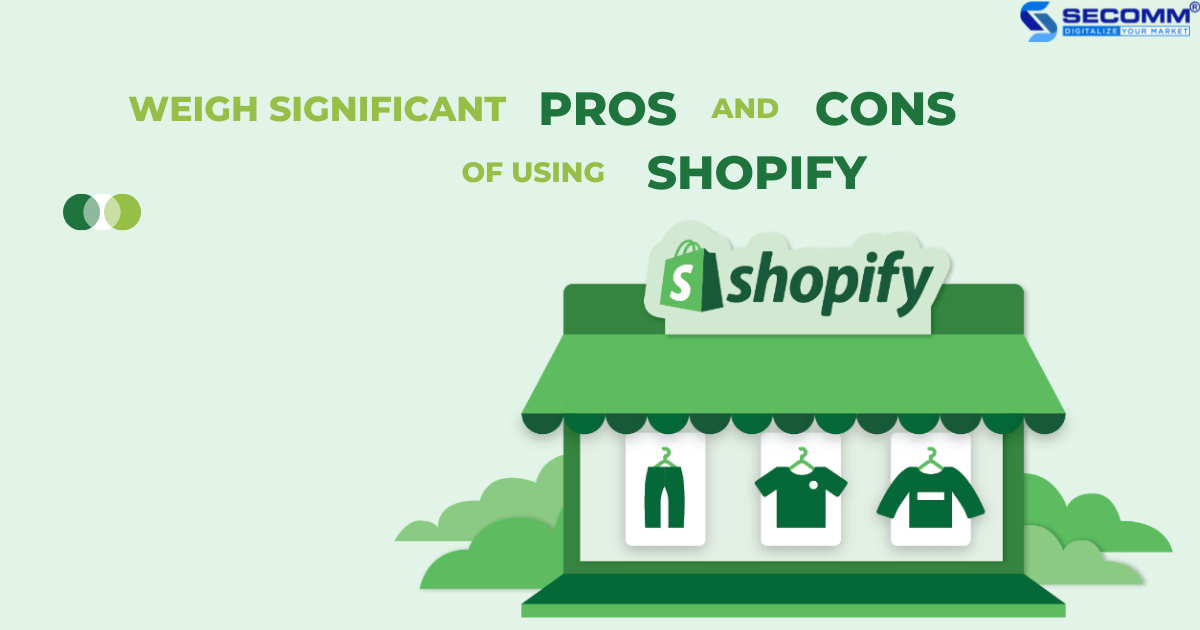
9+ PROS AND CONS OF USING SHOPIFY
Today, for businesses of all sizes, eCommerce websites play an essential role in reaching and buying products for a wide pool of potential customers on the Internet.
Thus, choosing the right platform to build an eCommerce website is incredibly important. A good eCommerce platform will make it easy for businesses to provide Omnichannel experiences, personalize customer experiences, offer a variety of services, products, and more to increase conversions and drive online sales.
Some commonly mentioned platforms for building eCommerce websites are Magento, Woocommerce, Bigcommerce, etc. Definitely, each business will have its considerations, but one platform that always appears as a top choice is Shopify. In spite of the fact that the platform is highly rated, businesses should still weigh the pros and cons of this platform before making a final decision.
As a result, SECOMM has prepared this review, helping businesses understand what Shopify is, how it works, implementation costs, and especially the pros and cons of using this platform to build a comprehensive eCommerce website.
What is Shopify?
Before becoming one of the most popular eCommerce platforms globally, Shopify started as an online ski store called Snowdevil in 2004. Later, the company transformed into an eCommerce platform named Jaded Pixel.
In 2006, It was officially founded in Ottawa by young programmers Tobias Lutke, Daniel Weinand, and Scott Lake. Since then, the platform has gradually affirmed its position as a reliable and fastest-growing eCommerce platform in the last two years when most companies faced many difficulties because of the Covid-19 pandemic.
Up to now, the number of Shopify users has increased significantly. As reported by StoreLeads, there are currently about 2 million websites using the platform to build and develop online businesses. In the second quarter of 2022, the number of newly opened stores reached 150,928, an increase of 10.8% compared to the same period in 2021. In Vietnam alone, there are about 2,000 websites using the platform in operation, up 9.8% in the second quarter of 2022 over the same period in 2021.
Total revenue in the second quarter of 2022 reached $1.3 billion, up 16% over the same period in 2021, corresponding to a compound annual growth rate for three consecutive years of 53%. Gross profit in the second quarter of 2022 increased by 6% to $655.6 million compared to $620.9 million in the second quarter of 2021 (According to Shopify’s report).
While it is one of the most popular and user-friendly eCommerce platforms available today, businesses still need to determine if this is what they need to expand their business, all the advantages and disadvantages of the platform, mostly the cost issue.
Pros of using Shopify for an eCommerce website
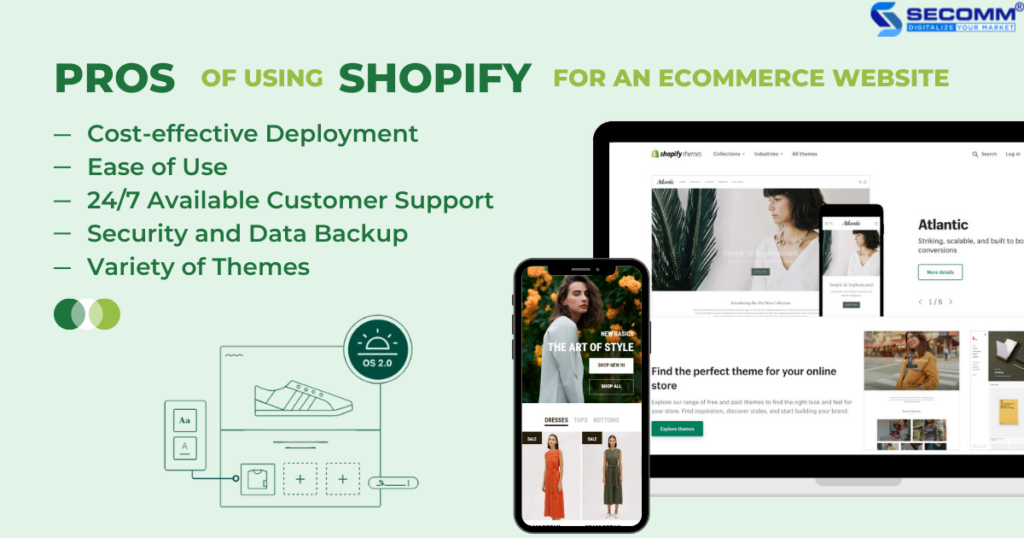
Cost-effective Deployment
For a start, businesses can enjoy a 14-day free trial without a credit card requirement. When the free trial ends, businesses are encouraged to opt for one of the solution packages with suitable features and appealing promotions.
|
Packages |
Price |
Main Features |
Unique Features |
Ideally suited for |
|
Starter |
|
Create product pages and get shareable links with product information, then send those links to customers via social platforms or message apps. | Merchants that sell on social platforms or message apps with no website in demand | |
|
Lite |
|
– Shopify Buy Button.
– Invoicing. |
Merchants that sell on an existing website or social platforms. | |
|
Basic |
|
– Customizable website editor.
– Website hosting and free TSL certificate. – Unlimited number of products. – Analytical reports – Localization: currency conversion, website translation, regional domains. – Inventory Management. – Shopify POS. – Shopify Email. -Shopify Payment. – 24/7 Customer service. |
– 2 staff accounts.
– 4 inventory locations. – Basic reports. |
Businesses who have just entered or intend to enter the eCommerce world and look for comprehensive eCommerce solutions. |
|
Shopify |
|
– 5 staff accounts.
– 5 inventory locations. – Standard reports. |
Steadily growing eCommerce businesses. | |
|
Advanced |
|
-15 staff accounts.
-8 inventory locations. – Advanced reports. – Automation tools. |
Large-scale businesses that sell internationally | |
|
Plus |
Từ $2000/month. However, businesses can contact Shopify for a custom estimate. | – 9 expansion websites.
– Up to 100 themes. – Exclusive Merchant Success Program, Shopify Plus Academy, Shopify Plus Partner , Shopify Plus Community on Facebook |
Enterprise-level businesses that manage and operate multiple eCommerce websites. |
Table list of price, and features of Shopify solution packages.
First and foremost, because it is a SaaS platform, the cost to get started is usually quite low. Despite the fact that businesses must pay monthly fees, transaction fees, theme fees, and extension fees, Shopify is still significantly less expensive than open-source platforms such as Magento, WooCommerce, and others.
The development of an open-source platform necessitates the assistance of experienced programmers and takes a long time to deploy, whereas the SaaS platform is the inverse. That is the reason why starting with a SaaS platform, specifically, Shopify, will save businesses both time and expense.
Another cost highlight is that SaaS platforms, in general, and Shopify in particular, require an ongoing monthly fee rather than a one-time purchase fee to use the platform. This reduces the risk of businesses investing too much money in the platform but not meeting their expectations during the implementation process.
Furthermore, the Shopify platform is appropriate for different-sized businesses in the market. The Starter, Lite, and Basic packages are appropriate for SME businesses engaged in eCommerce. Shopify, Advanced, and Plus packages are ideal for large-scale businesses that require advanced features to run an effective eCommerce website.
Ease of Use
The only way to adapt to the ever-changing market and quickly reach a wide pool of potential customers is for businesses to deploy eCommerce websites as soon as possible to avoid being left behind in the competition of the digital transformation race. One of the important factors when building an eCommerce website is choosing the right platform.
In particular, the top goal to consider when choosing an eCommerce platform is the ease of use. If a platform takes users too long to learn and implement or makes users dependent on external support, then the platform is not easy to use
Shopify has an easy-to-use interface for users with little programming knowledge. Moreover, Shopify is a SaaS eCommerce platform with a pre-designed system that offers hosting, interface, features, and technology infrastructure maintenance, allowing businesses to easily build and operate the website system with just drag and drop without worrying about technical issues.
Simple steps to get started with the eCommerce website implementation with Shopify:
- Choose from one of the solution packages depending on the business needs
- Choose a business domain
- Choose an appropriate theme and template
- Choose essential features
- Optimize the eCommerce website and add products
- Go-live
24/7 Available Customer Support
This is one of the most crucial factors influencing users’ decision to use Shopify. Difficulties and obstacles are inevitable when building an eCommerce website, so Shopify has assembled a reliable and trusted team to assist users.
As a result, if your business requires assistance, assistance is available 24/7. Businesses can reach Shopify via email, chat, and a hotline worldwide. What’s more, users can access community forums and useful documents for developing eCommerce websites on this platform, mostly through the Shopify Support Center.
Security and Data Backup
The Shopify platform runs on PCI (Peripheral Component Interconnect) compliant servers, allowing merchants to accept credit card payments. Secure Sockets Layer (SSL) encryption is enabled on all Shopify websites to secure visitor data, while a backup system allows businesses to store and save data regularly by exporting data to a CSV file.
As an outcome, the platform encourages the addition of an advanced backup solution from the Shopify Store, such as the Rewind app, as it is seen as a lifesaver if users accidentally delete content such as products or images or a video demonstration. To keep your eCommerce website secure, simply back up your data on a regular basis and use a strong enough admin password.
Variety of Themes
The interface is the appearance of a business’s eCommerce website. The more appealing the website interface, the more likely it is to retain customers, attract more visitors, as well as generate more conversions.
Shopify understands the importance of a website interface, so it has made a host of available themes, both free and paid, suitable for a wide range of businesses and fields, making it simple for businesses to choose from.
The free Shopify themes are ideal for startups, small and medium-sized businesses, and individuals. Businesses can customize their eCommerce website according to their needs and brand features by using features such as responsive web design, product filters, and product color display templates.
However, free themes have some downsides, including a limited number of themes, limited design, and a lack of advanced and specific features, which makes website customization difficult.
In fact, free themes are great for launching an eCommerce website. Premium interfaces, also known as paid themes, will be more suitable for large-scale businesses or businesses on the rise, with an average cost of around $140-$180/theme.
Shopify’s paid themes include advanced integration features such as live chat support, newsletter popups, upsell features, faster page loading, and much more. Thereby, businesses can run an eCommerce website automatedly and smoothly.
The Cons of using Shopify for an eCommerce website
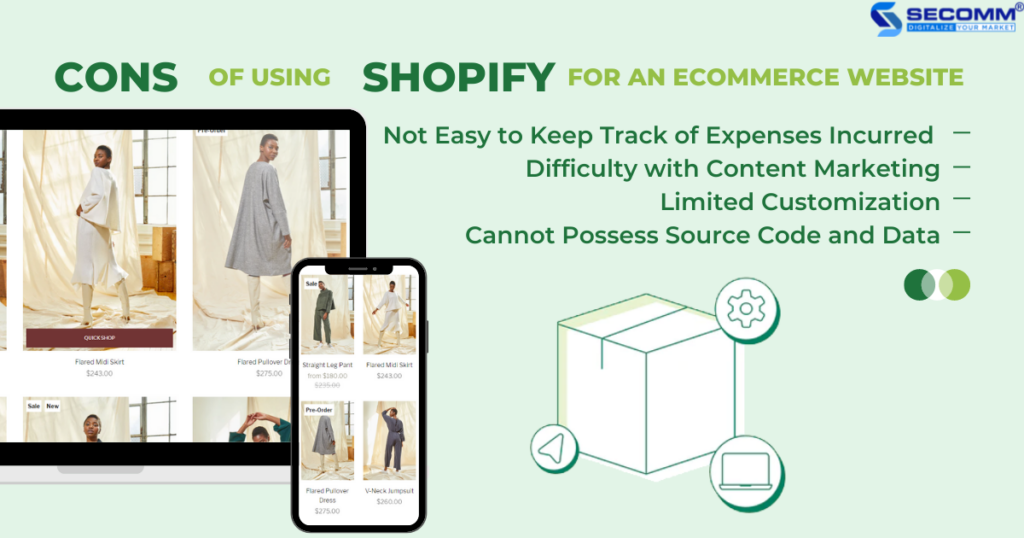
Not Easy to Keep Track of Expenses Incurred
The cost of using Shopify, besides the notable pluses, the platform has a small but enough minus to make some businesses hesitate to start.
In addition to the monthly fee for using the enterprise platform, businesses must pay for other costs such as themes, applications, extensions, marketing features, sales, and SEO on a monthly basis with no long-term possession.
For example, to use the Free Shipping & Hello Bar application that offers free gifts, free shipping, or other types of promotions, users will buy for $8.95/month, which means ongoing monthly in regards to other expenses, businesses will pay an additional $8.95 for this app until it is no longer used.
When there are small expenses incurred each month, it is difficult to control cash flow for large-scale businesses that have to manage and operate many websites at the same time.
Meanwhile, open-source platforms require a one-time purchase fee rather than an ongoing monthly fee. Although the features are not yet available and take a long time to program, businesses can possess those features for eCommerce websites in the long run. Thereby, it makes cash flow management more convenient and effective.
Difficulty with Content Marketing
It is a great way to promote your eCommerce website. Users can use Shopify to blog and optimize SEO, drive free traffic, and improve brand positioning.
However, this blogging feature on Shopify is not as user-friendly as WordPress. Some of the criteria Shopify can improve regarding blogging and content writing include:
- The outdated editor.
- The blog layouts are inflexible
- No categories force users to use tags
- Cannot add related blogs
- Cannot embed products in blogs
- Not easy to integrate third-party add-ons
This will be a barrier for businesses when using Shopify to promote eCommerce websites by optimizing SEO if the content is a core element of the business’s marketing strategy.
Limited Customization
Another limitation of Shopify is that the platform’s interface is customized using the Shopify Liquid setup. Meanwhile, many website developers are already familiar with the PHP programming language to customize the themes and templates of the website, it is a common technique used by WordPress.
Therefore, users who do not have much experience in programming will face many obstacles when using Shopify’s tools to customize the interface of the eCommerce website.
However, businesses of all sizes can still use other useful Shopify features like Shopify Themes, Shopify App Store, Shopify Blog, 24/7 support team, and more to set up an eCommerce website quickly and effortlessly.
Cannot Possess Source Code and Data
Because the entire business’s website system is hosted on Shopify’s server, the ownership and control of the website source code will belong to Shopify, not the business. Similar to other SaaS platforms such as BigCommerce, Squarespace, Wix… Shopify has a Lock-in feature, which means that when converting a website from one platform to another, businesses will no longer be able to use the old website source code and have to rebuild from scratch on a new platform.
Similar to the source code, business data is also stored on Shopify’s servers, so data ownership and control are quite limited. This makes it difficult for businesses to connect data among internal departments or users’ personalization, etc. Especially when switching platforms, data loss or misalignment is often unavoidable.
Shopify will not assist in the event that businesses stop using the platform for any reason. The only asset businesses can keep and take away is a CSV report containing website information.
Hence, before starting an eCommerce website on the Shopify platform, businesses need to carefully consider the benefits and disadvantages of stopping using it to conclude whether Shopify is the best fit for business in the long run.
Going by this article, Shopify is one of the eCommerce platforms that many businesses would love to choose when deploying an eCommerce website. However, besides the outstanding advantages, there are still certain downsides, so businesses need to carefully consider and compare with other platforms before starting out.
With many years of experience in implementing eCommerce in many countries, SECOMM provides free consulting services with professional eCommerce solutions.
Contact us today for free support and advice!
 2
2

 1,838
1,838

 0
0

 1
1
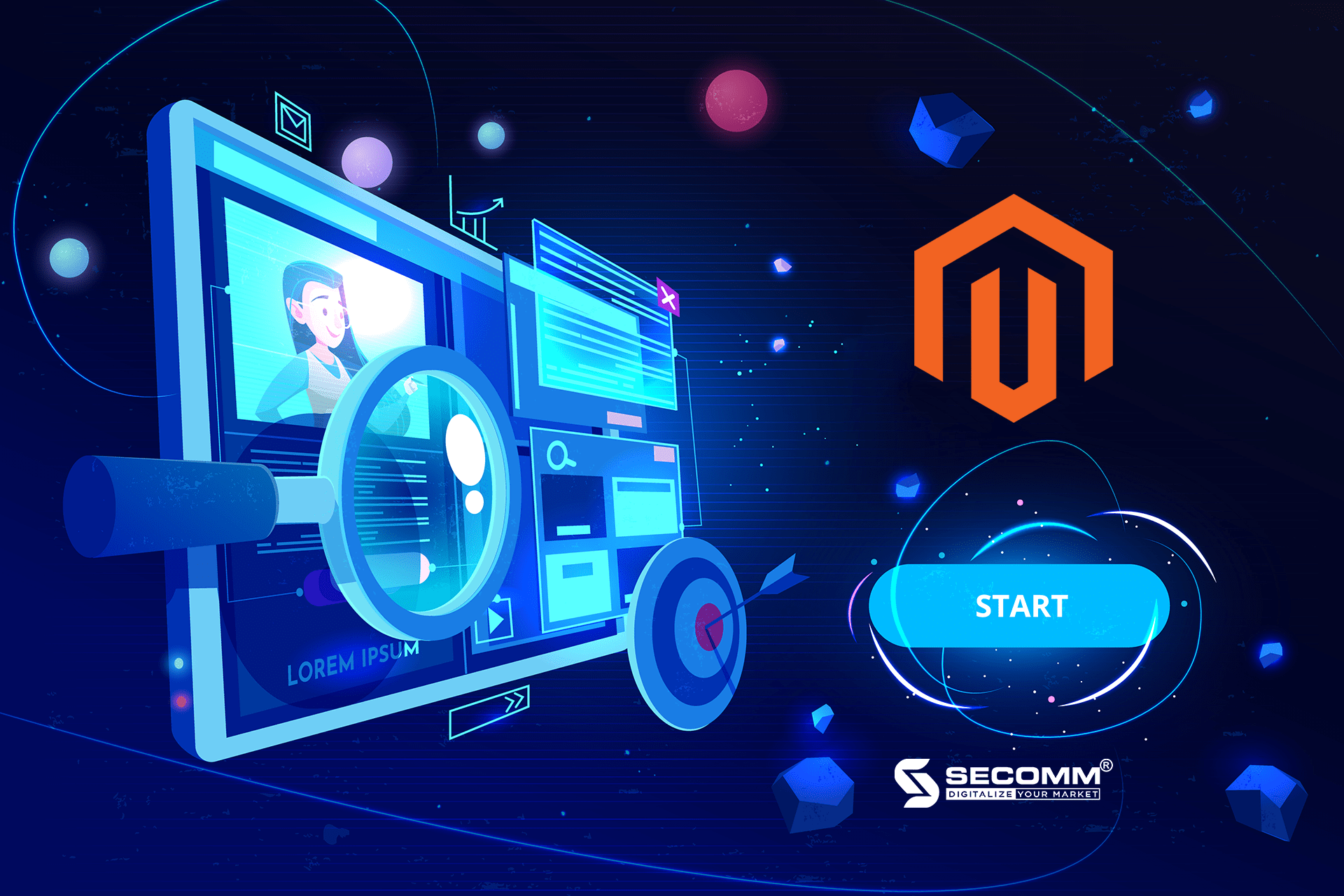
IS THE MAGENTO ECOMMERCE PLATFORM APPROPRIATE FOR SMEs?
Platforms play a significant role in developing and operating an optimal eCommerce system. As a result, selecting an eCommerce platform should be done thoroughly and carefully to maximize the platform’s benefits and promote long-term business growth. Each business’s eCommerce model will have appropriate platform options depending on the development goals. However, most SMEs today face significant challenges in selecting a suitable eCommerce platform due to a variety of budget, time, and business characteristics.
The Magento eCommerce platform is the most fantastic platform for eCommerce systems among popular names such as Shopify, BigCommerce, WooCommerce, and so on. Magento has many distinct advantages, including high flexibility, a diverse ecosystem, and optimal security. However, are Magento’s outstanding features the best option for SMEs? So, what are the standout characteristics of the Magento eCommerce platform? Will they be appropriate for SMEs in the Vietnamese market?
These prominent advantages make the Magento eCommerce platform appropriate for SMEs.
A diverse ecosystem
Possessing all of the basic eCommerce system’s functions
The Magento eCommerce platform is designed to grow into a comprehensive eCommerce system.
- Catalog Management: Develop and maintain all data, functions, and information about products, categories, attributes, pricing systems, inventory, images, and videos to keep operations running smoothly and maximize business performance.
- Content Management: Create and optimize all CMS page content elements, host images, theme customization, and website design.
- Sales Management: Establish and oversee the sales, order, payment, and shipping processes. Simultaneously, diversify customer information to provide the best possible customer experience.
- Marketing Management: Optimize and implement SEO the promotion programs (promotions, up-selling, cross-selling, etc.) with support tools, are used to increase business sales.
- Customer Management: Manage customer information entirely to improve marketing efficiency, the purchasing experience, and customer experience.
- Inventory Management: Fill the supply chain quickly and effortlessly with inventory management tools that direct shipments to the appropriate warehouses.
- Report: Make use of data effectively by delivering comprehensive and detailed reporting to improve and enhance business performance, including Sales & Marketing, Customer Reports, Product Reports, and Evaluation and Operational Performance Report
- Analysis: Monitor and measure the eCommerce system performance with built-in tools like:
+ Integrate Google Analytics to track and report on traffic, audience, purchasing process, and purchasing behavior.
+ Integrate Facebook Pixels makes tracking ads performance and capturing website actions simple.
+ Integrate Google Tag Manager to quickly update website metrics and related tags to increase personalization and accomplish the proper goals for the subsequent Marketing campaigns.
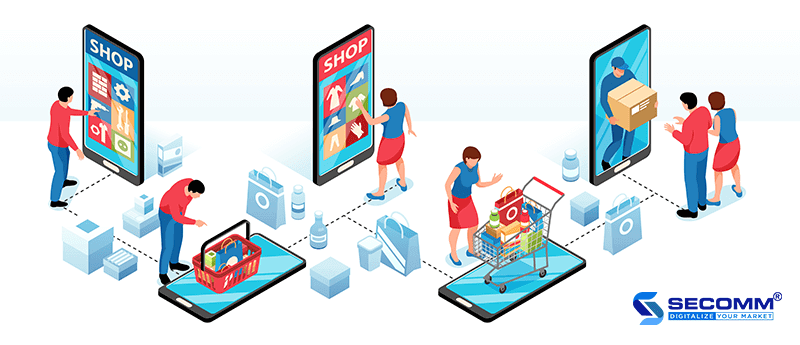
Diverse extension systems with numerous advanced eCommerce functions
The Magento extension system has also been significantly developed to meet the eCommerce market’s rapid development and the specific requirements of each business.
Thousands of advanced functions on themes, add-ons, products, Marketing, payment optimization solutions, shipping, and so on have been built with flexibility and high usability to deliver exceptional results when integrated into the system that meets all operational needs and ensures the long-term growth of businesses’ eCommerce.
Ability to integrate with other systems and services
Businesses can fully integrate third-party services, analytics tools, management software, and Omni-channel with the Magento eCommerce platform to support efficient and seamless eCommerce operations.
- Payment: Simply connect to the Magento system to today’s most popular payment methods, such as card payment (ATM, VISA, Mastercard,…), eWallet (MOMO, ZaloPay,…), payment gateway (OnePay, VNPay, PayPal,…), or COD… helps to diversify the payment and purchasing experience
- Shipping: Easily integrate couriers (Giao Hang Nhanh, Giao Hang Tiet Kiem, Viettel Post) and popular shipping tracking applications in the market to support handling and optimize delivery processes
- Management and operation software: Integrating the Magento system with back-office management and operation software (ERP, CRM, POS, …) such as SAP, Salesforce, and Oracle.. to operate all resources and processes seamlessly in the enterprise.
- Business Analytics Tool: Magento can also integrate with business intelligence (BI) tools such as Power BI, Tableau, Looker, and others to improve business efficiency and easily merge and exploit all data from the system. The Magento system, extensions, and third-party services enable quick, efficient, and data-driven analytics and reports to improve business strategy and drive growth.
- OmniChannel: Consolidate all sales channels on the same Magento system to handle and control data and create seamless offline and online business processes. Furthermore, businesses can quickly develop and manage omnichannel marketing strategies to personalize customer experiences and optimize eCommerce.
Global technical support community
In addition to a fully functional feature system, the Magento eCommerce platform is supported by a diverse system of extensions and technologies from a global developer community, allowing all eCommerce requirements of SME businesses to be met quickly anytime, and anywhere. The Magento eCommerce platform has a large developer community worldwide, including many experienced professionals and Magento developers.

Businesses will receive maximum support in solving problems arising from technical errors and consulting on building eCommerce solutions that fit the enterprise’s business model with a strong Magento eCommerce platform development community.
An extensive technical support community is another example of the reliability and capacity to quickly resolve system errors and updates that Magento constantly brings to our eCommerce system.
Magento eCommerce Platform Flexibility
The Magento eCommerce platform’s flexibility is an exceptional advantage that allows the Magento eCommerce platform to operate any complex system. Given this benefit, Magento is an excellent choice for Vietnamese SMEs today. Moreover, businesses can easily change system functions, develop new features, or open new stores to meet their needs and respond to rapid market change.
Customizability
The Magento eCommerce platform possesses the advantages of open-source software with extensive customizability to help the system run smoothly. Enterprises can easily own and control the entire system source code and customize it to change parts to suit the eCommerce system’s general operating model.
Owing to this benefit, Magento is highly customizable for any size business and can meet the eCommerce needs of both small and large corporations.
Besides that, the customizability of open-source code enables developers to create more innovative and comprehensive solutions tailored to each business, field, and business model, creating highly specialized eCommerce functions that result in effective system performance.
Scalability
Multi-websites, Multi-stores
Magento allows businesses to scale from one website/store to many different websites/stores on the same system to meet the needs of business scale development. Businesses can access and manage all data from multiple websites/stores using a single Magento system.
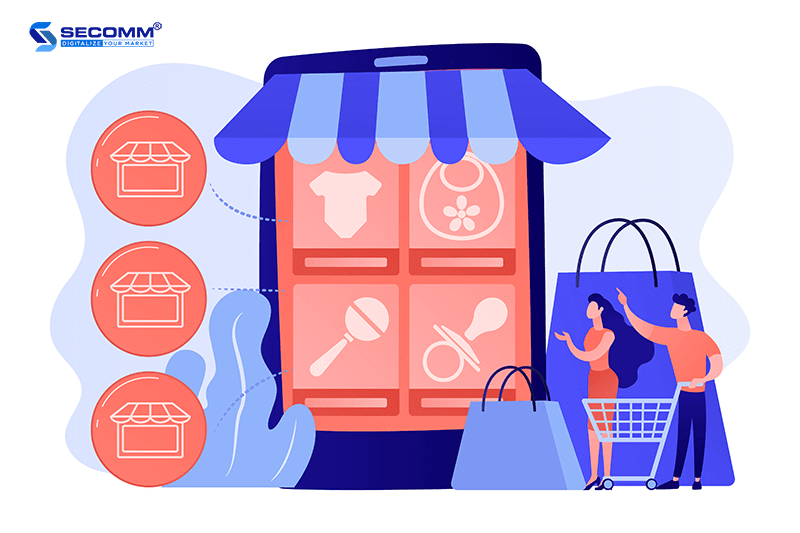
Multi-languages, Multi-currencies
With Magento’s language conversion support, businesses can create an eCommerce system with customer-friendly content and language. Besides that, the Magento system enables businesses to quickly convert currencies, expand their markets in many countries, and assist customers in transacting conveniently and having the best shopping experience.
Security Capabilities
High security is another significant benefit that makes the Magento eCommerce platform the preferred choice for SMEs. Magento is a complete eCommerce system with security functions that ensure seamless eCommerce operation while minimizing potential data system and ecommerce transaction processing risks. As a result, system security is improved, website credibility is increased, and user interests are protected to the greatest extent possible.
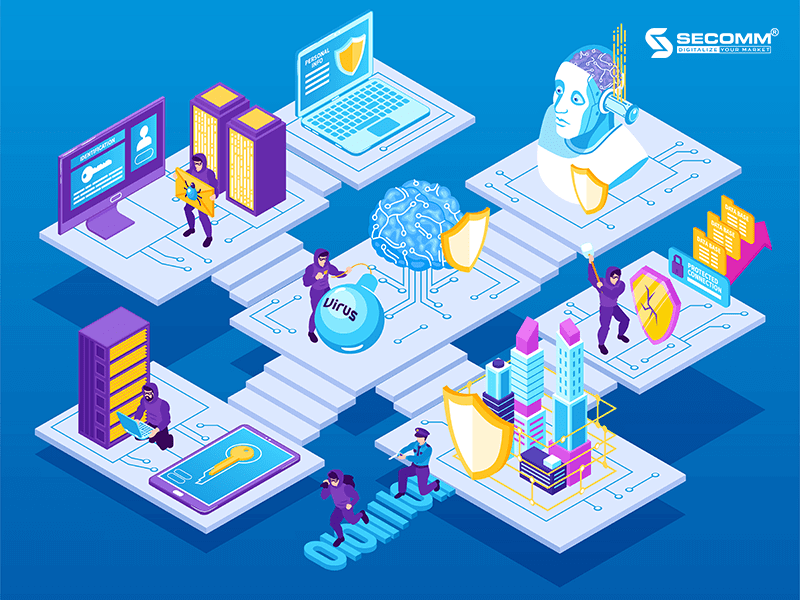
Security scanning tool
Magento includes a periodic security scan tool to identify security issues or malware affecting the system and update patches and notifications, then propose security solutions to handle arising errors, thereby effectively improving and optimizing the website’s security.
Advanced passwords for the administrator account
The requirement to use advanced passwords should also be fully implemented to increase the level of security for administrative accounts. The administrator password must be at least seven characters long and include letters, numbers, and special symbols. Relating to further adjustments, the password complexity may be increased with lower case/case sensitivity, or re-login may be required after a certain length of the login session.
CAPTCHA security
CAPTCHA can protect the system for both administrators and website visitors. In addition, using CAPTCHA aids the system in preventing bot spam and malicious code from entering the system illegally.
2FA function- Two factors of security authentication
This function provides additional security for system user accounts. Accordingly, customers will have to authenticate with an additional OTP security code sent to the phone number provided during account registration after logging in with a password. This two-layer security operation effectively limits the threats of unauthorized access and account attacks while enhancing protection and maximum safety for system users.
Problems encountered when implementing eCommerce on the Magento eCommerce platform.
With significant advantages such as a fully functional feature system, flexibility, a diverse ecosystem, and optimal security, the Magento eCommerce platform is the best choice for SMEs looking to build a stable and sustainable eCommerce system. However, due to deployment costs, implementation time, and complex industry-specific issues, most SMEs are still hesitant to use Magento to build an eCommerce system.
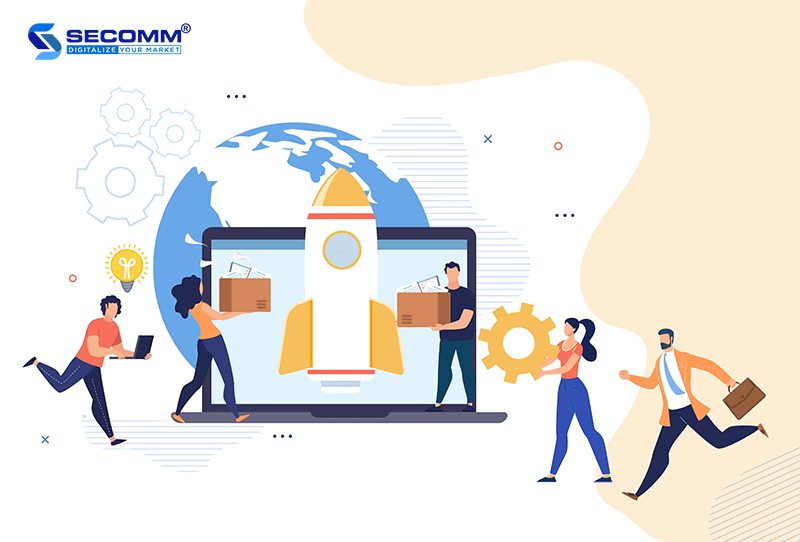
High implementation costs
Although Magento is highly regarded for its features and performance, the cost barrier prevents SMEs from selecting the Magento eCommerce platform to build their system. Furthermore, the expertise of the system developers is a significant factor that significantly increases the cost of Magento implementation. Therefore, a complete and efficient Magento eCommerce website is implemented by a professional team that is thoroughly knowledgeable about Magento to develop the proper comprehensive system from the beginning and provide appropriate solutions for the enterprise’s various needs in the long run.
A fully functional system built on the Magento eCommerce platform is estimated to cost between $10,000 and $100,000.
The long implementation timeline
A complete project on the Magento eCommerce platform typically takes 2-3 months to deploy, with some projects taking up to a year. Additionally, enterprises should constantly develop components of the eCommerce system. Furthermore, the functional system’s complexity necessitates time investment to build appropriate development solutions.
When selecting an eCommerce deployment platform, SMEs should consider the time issue carefully. With the requirements of the eCommerce and digital transformation markets, the extended system implementation time slows down the digital transformation process, making it difficult for businesses to keep up with competitors or constantly update trends in the market.
The complexity of dedicated functions
When converting to eCommerce, the specific characteristics of each industry and field remain a complex problem for every SME. Because most Vietnamese SMEs lack the technical knowledge and expertise required to build particular functions that can satisfy one or more specialized processes and the complexity of the eCommerce system, industry specificity has become a significant obstacle. These specific functions necessitate a corresponding technological solution to ensure that the eCommerce system can operate effectively and sustainably after the transformation.
Simultaneously, to build a specific feature with high complexity for a Magento store, businesses may need to spend more money and time than usual to develop a suitable solution to the particular requirements of an eCommerce business.
With extensive experience developing many complex e-commerce systems on Magento, SECOMM understands the challenges that businesses face when selecting a platform and implementing E-commerce.
Contact SECOMM for a free consultation on comprehensive e-commerce system development solutions!
 2
2

 2,878
2,878

 0
0

 1
1
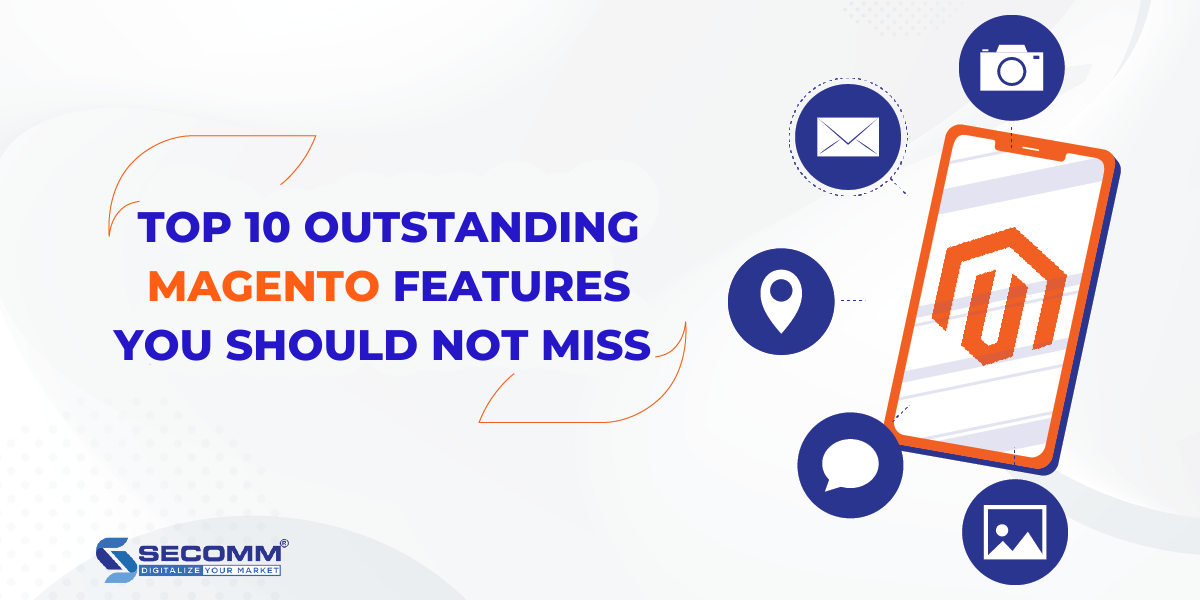
TOP 10 OUTSTANDING MAGENTO FEATURES YOU SHOULD NOT MISS
Since its inception, Magento has maintained its distinct position in the eCommerce development community. One of the primary reasons for this is that Magento has a diverse, highly applicable feature system compatible with all business models (B2B, B2C, B2B2C, D2C).
SECOMM will introduce some “cool” Magento features for businesses to consider
Multi-brand solution
The Multi-Brand Solution is a multi-language, multi-currency, and multi-store solution that helps businesses unify all content and products on a single “screen.” Businesses with various brands, stores, or business models can set up multiple pricing structures, display a wide range of product types, and customize payment methods for any audience ( B2B, B2C, B2B2C, D2C).
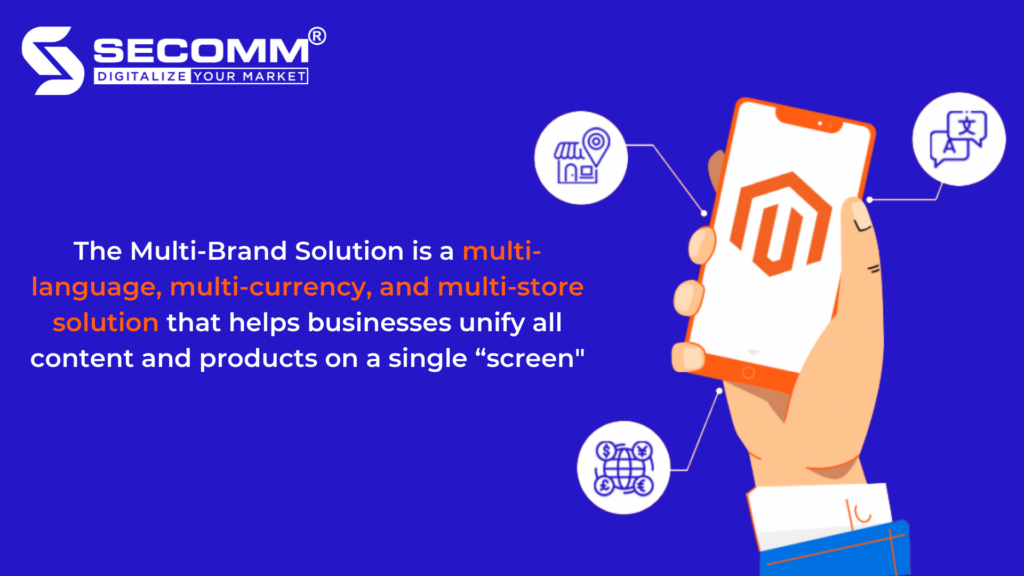
This function assists businesses in increasing sales by utilizing all content to create eye-catching websites to maximize customer information. As a result, targeting different customers with product recommendations and promotions is possible. Simultaneously, the adaptability enables businesses to personalize the purchasing experience through customized categories and pricing.
MSI (Multi-Source Inventory)
MSI is a prominent feature of Magento 2 (starting with version 2.3.0) that allows businesses to easily manage products from multiple stores, significantly improving inventory management regardless of customer location, warehouse, or sales channel.
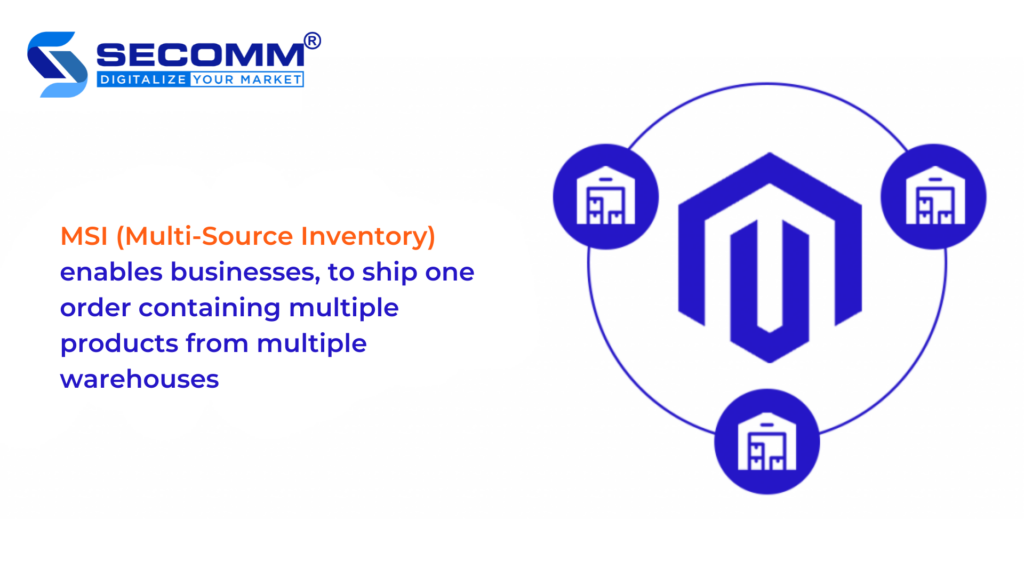
This feature enables businesses, particularly dropshipping businesses, to ship one order containing multiple products from multiple warehouses while ensuring on-time delivery to customers.
Headless Commerce
Magento’s headless Commerce is an eCommerce architecture that separates the frontend (which represents the user interface) from the backend (which means the eCommerce functionality). The front and backend are linked together by an API, allowing businesses to easily customize and update without interfering with the user interface or CMS pages.
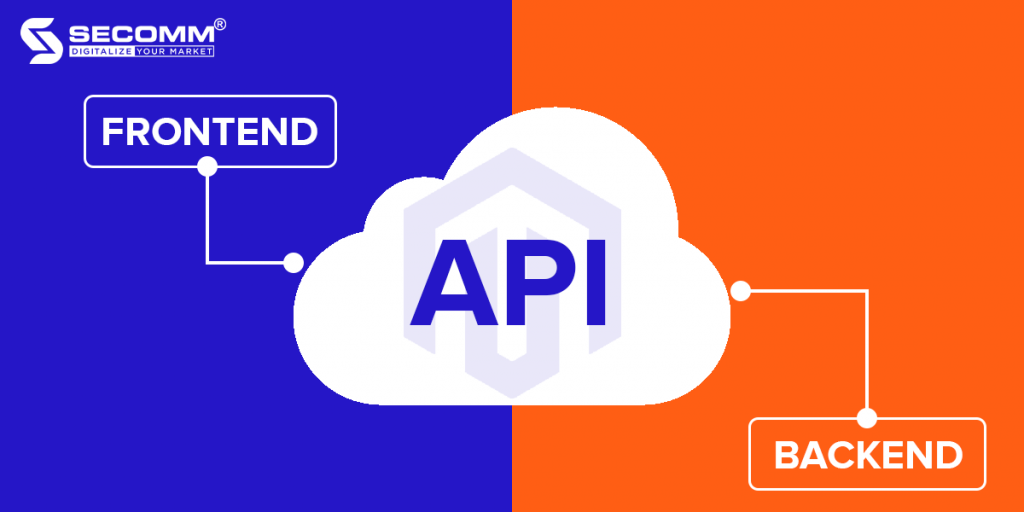
Thanks to the applicability of Headless Commerce, Magento websites benefit from faster page load times and personalized user experiences at a lower long-term cost.
Comprehensive Analysis
Magento allows you to track and measure eCommerce system performance using built-in tools like Google Analytics, which tracks and reports traffic, audience, purchasing process, and purchasing behavior.
Use Google Tag Manager to quickly update website metrics and related tags to increase personalization and reach the right goals for the following marketing campaigns.
Use Facebook Pixels to measure ad performance and capture actions taken on the website.
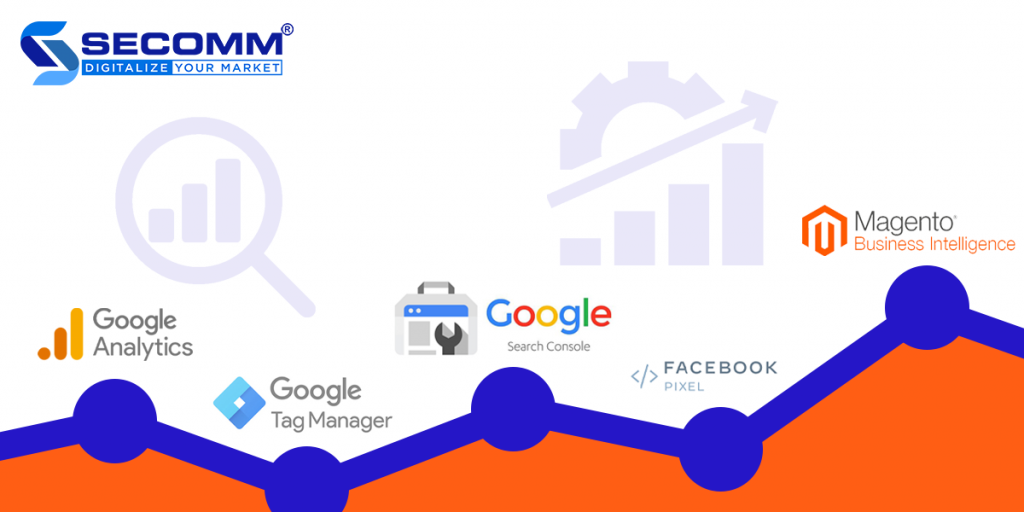
Furthermore, Magento supports Business Intelligence (BI) analysis. Magento BI is a cloud-based platform that allows you to consolidate and manage data sources, create data models, and create charts and reports from a single screen. Sending out periodic reports also helps to control information sharing.
Integrating various B2B functions
Specially designed for B2B customers, supporting various functions like:
- Shared Catalog: This allows companies to create “shared” catalogs with prices, products, and customization rights for multiple brands.
- Business Account: Assist admins in creating accounts, managing all data, and assigning sales representatives as accounts’ primary contacts.
- Quick Order: Order by SKU is similar in that it allows customers to add products to their cart by simply entering the SKU (Stock Keeping Unit) code and quantity information or loading a CSV file.
- Business Credit: Allows businesses to extend their B2B customer credit line, allowing them to make purchases up to the authorized credit limit on their account. This function assists businesses in tracking and controlling credit issues.
- Quoting: Allows businesses to manage quote requests in the admin interface, view contact history between buyers and sellers, and export data.
- Payment on Account: This feature is applicable globally or in business and occurs in the payment process with a message that will appear at the top of the order to indicate the status as an additional offline payment method that allows companies to make purchases up to the credit line specified on file.
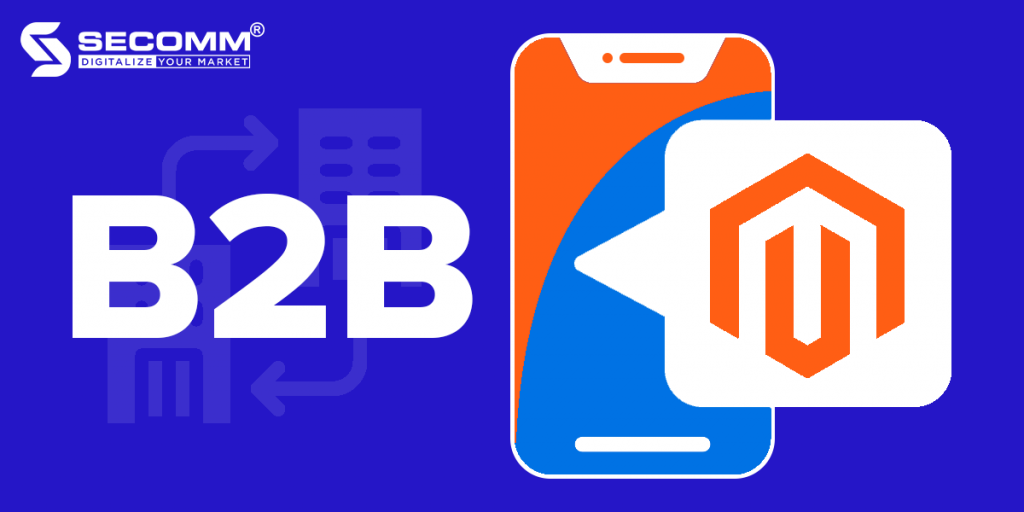
All of these features assist businesses in managing user accounts via the customer portal, allowing them to quickly set up multiple levels of buyers with specific roles and benefits.
In addition, companies can track quotes and orders, define purchasing rules, and manage credit online simultaneously. Since then, business and management in the B2B model have become more efficient and faster.
Advanced search function
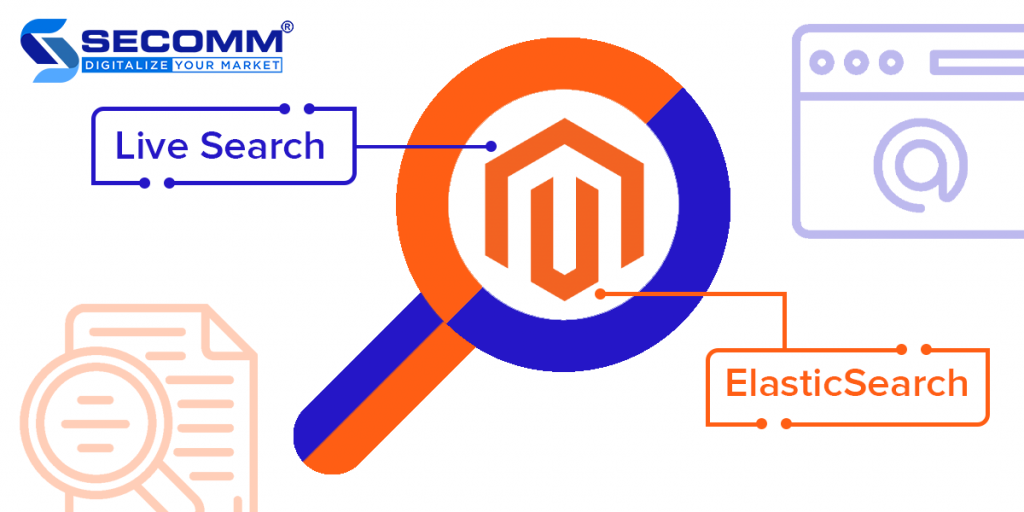
Live Search combines artificial intelligence (AI) and machine learning (Adobe Sensei) to provide fast search results and personalized product recommendations based on customer behavior, trends, characteristics, and other data.
ElasticSearch is an open-source distribution that supports enterprise-level search engines for searching data on the server. This function aims to perform real-time analysis and data source mining (MS SQL, MySQL, PostgreSQL, etc) to optimize highly for fast language-based searches.
Simultaneously, overcome the difficulties by hiding all other complex operations by providing API access.
Smart page builder
This function includes a variety of actions, such as the ability to drag and drop content on the website to provide the best user experience, preview how the content will appear on the user interface, and modify forms to enter and customize content.
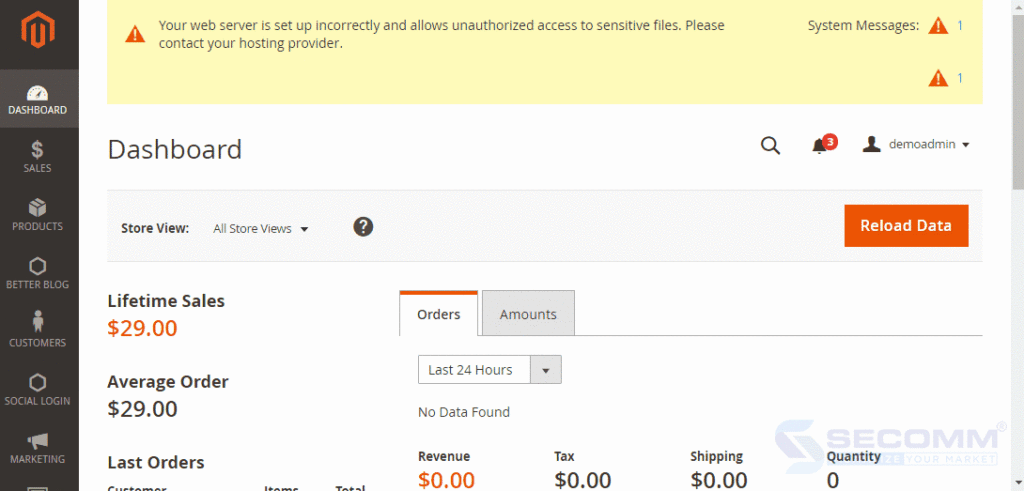
Initially, Magento’s functionality only supported the Magento Commerce version (Magento Enterprise Edition). Still, since Magento 2, the developer has supported the Magento Open Source version, allowing businesses to create unlimited CMS content pages.
High Security
Magento’s high security has long been a distinguishing feature that makes it the preferred platform for businesses.
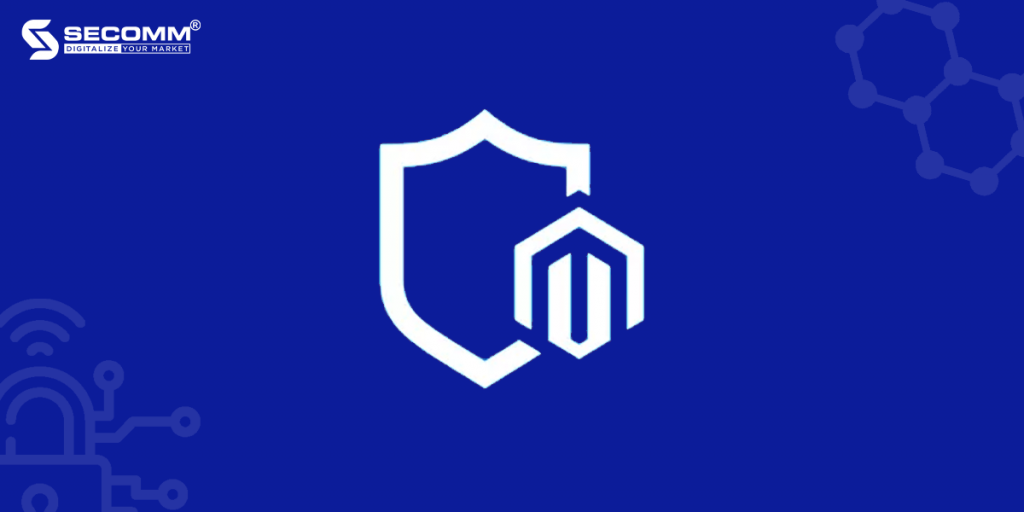
Using a periodic security scanning tool to quickly identify problems and update patches and notifications, propose security solutions to deal with arising errors, and effectively improve and optimize website security.
To increase the level of security for administrator accounts, use advanced passwords. The administrator password should be at least seven characters long and contain letters, numbers, and special symbols. Password complexity may be increased with lower case/case sensitivity, or re-login may be required after a certain length of a login session, depending on additional adjustments.
CAPTCHA security can protect both administrators and website visitors. In addition, using CAPTCHA aids the system in preventing bot spam and malicious code from entering the system illegally.
The 2FA (Two-Factor Authentication) function provides additional security for system user accounts. To effectively limit threats of unauthorized access and attack on user accounts, customers must authenticate with an OTP security code sent to their phone number after logging in.
PWA (Progressive Web Apps)
PWA combines a website and a native app (for Android and iOS) on tablets and smartphones. Therefore, PWA enables your website to function and interact with mobile users in the same way that a native app would.
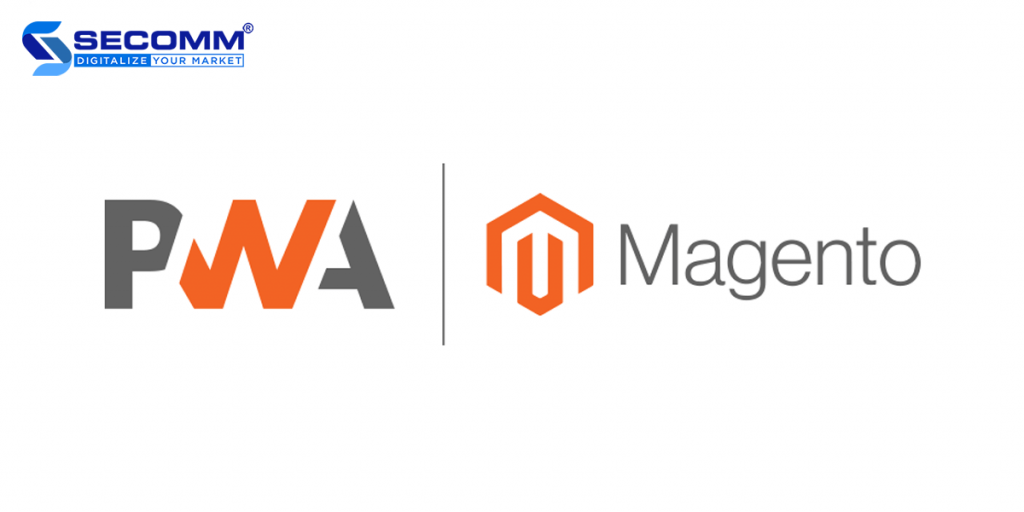
However, depending on the user’s needs, this website can be converted into a mobile application right on the device. Users can download the app to their phones when they visit the website. If the user agrees, they can open and browse the website in the same way they would an app on their phone.
Advanced SEO
SEO is another fantastic feature of Magento, in addition to optimizing website content, this feature also searches for indexed pages and assesses the SEO quality of each page. From there, the business website can use the robots.txt file to prevent the crawling of low-value parameters and consider only indexing pages with high search potential to improve rankings.
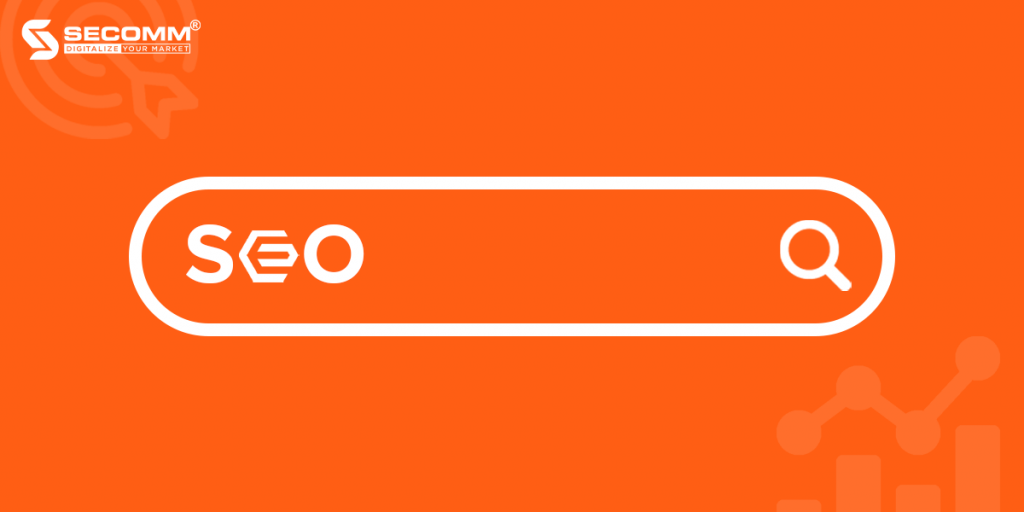
In addition, Magento has many other features such as cross-device compatibility, quick purchase and quick checkout, and so on. However, the development cost of an e-commerce website with such complex features is often very high, ranging from $5,000 to $100,000.Businesses should think about their e-commerce strategy when developing a unified sub-feature system.
With extensive experience developing many complex e-commerce systems on Magento, SECOMM understands the challenges that businesses face when selecting a platform and implementing E-commerce.
Contact SECOMM for a free consultation on comprehensive e-commerce system development solutions!
 2
2

 2,411
2,411

 1
1

 1
1
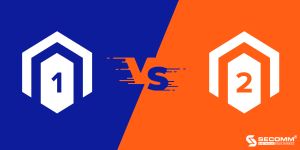
THE SIGNIFICANT DIFFERENCES BETWEEN MAGENTO 1 AND MAGENTO 2
Magento is a specialized open-source platform for creating the most popular eCommerce websites today.
Currently, it supports two versions: Magento 1 and Magento 2. Some websites use M1 platform, such as CellphoneS, and Bach Long Mobile (Magento Open Source 1.9). Websites using M2 such as Di Dong Viet, and Kidsplaza (Magento Open Source 2.3).
So what is the difference between the two versions, and why have businesses not upgraded their websites to M2?
What is the difference between Magento 1 and Magento 2?
Technology infrastructure
M2 uses newer technologies than M1, resulting in more diverse performance, user experience, and functionality.
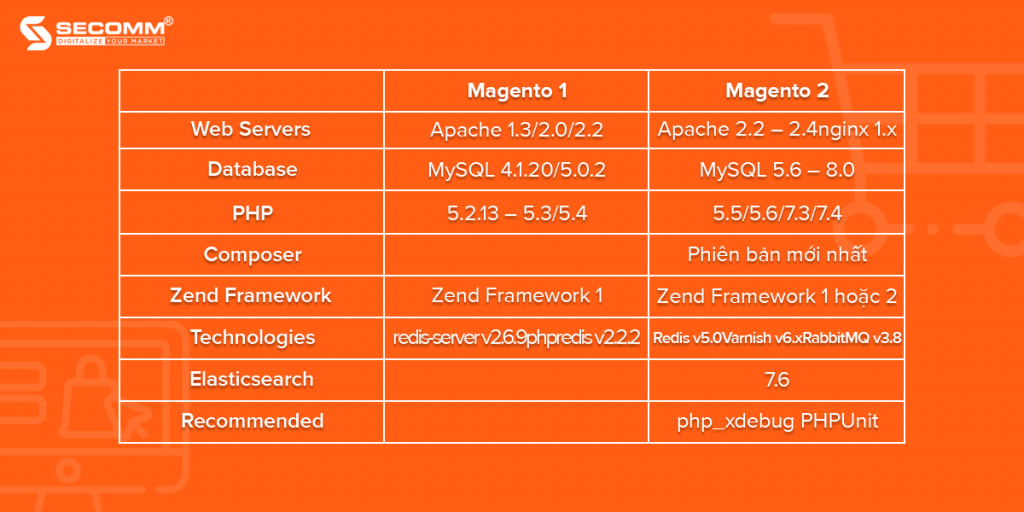
Extensions
Both platforms support a wide range of third-party extensions. However, many utilities on M1 will frequently repeat a piece of code, causing conflicts for the website’s functional system, and requiring a significant amount of time to manually fix it. Meanwhile, Magento 2 has supported a plugin that allows code to overlap, assisting in the issue’s faster and more effective resolution.
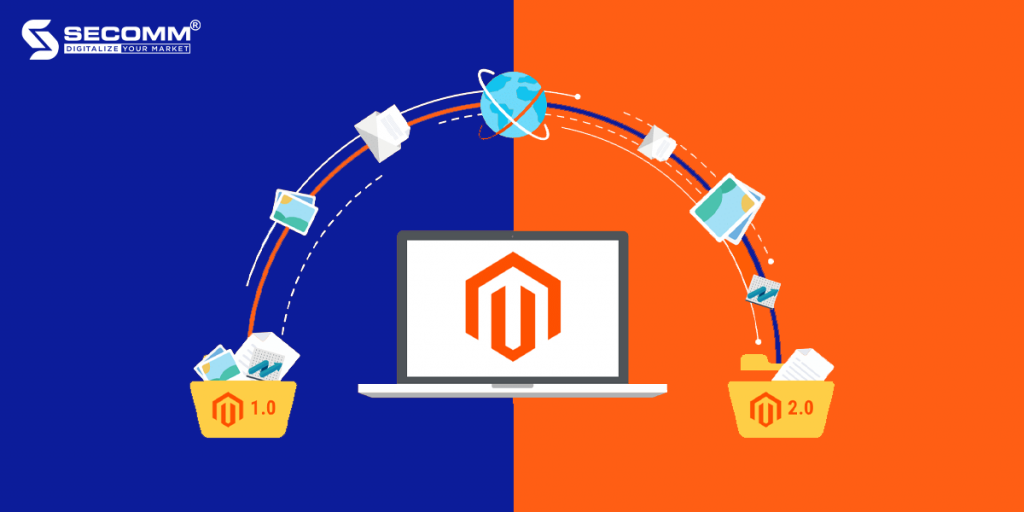
At the same time, M2 support utilities frequently use new technologies (HTML5, CSS3, Requirejs) at lower prices. Compared to M1, this makes it easier for developers to customize, upgrade, and build new functionality for the website.
Dashboard
Magento 1 is frequently criticized for having a messy admin interface that takes a long time to adapt. In contrast, Magento 2 is more user-friendly for admin accounts because:
- The dashboard makes it easier to read revenue, profit, tax, and reports effectively
- Allows quick information searches
- Allows for easy product creation and management
- Easy access to backend components
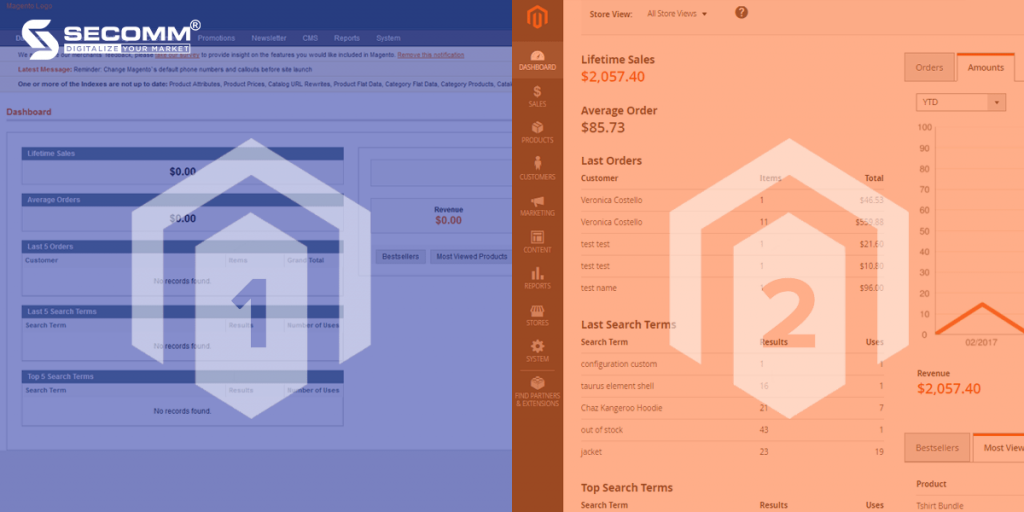
SEO
Magento has long been known for its SEO capabilities, but developers can improve SEO even better with Magento 2:
- Canonical tag support: Fix repetitive content to help increase the SEO content score for the website.
- Enable Meta tags (Meta Title, Meta Description, and Meta Keywords) for individual pages, which will aid SEO for each detailed product page.
- New technologies are responsive and provide a better user experience across devices.
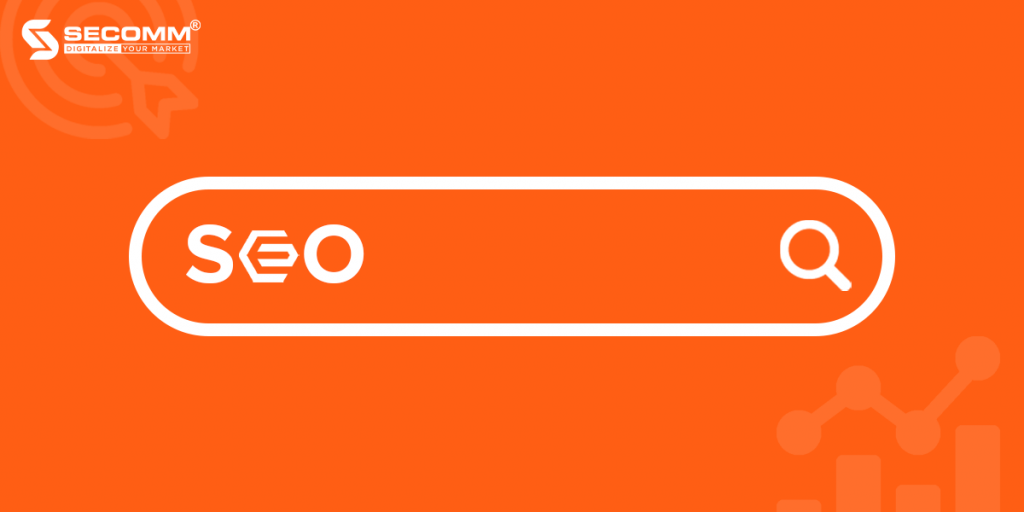
High Security
Since June 2020, Magento has stopped updating and releasing security patches and fixes for M1. Therefore, M1 websites easily become a target for cyber attacks.
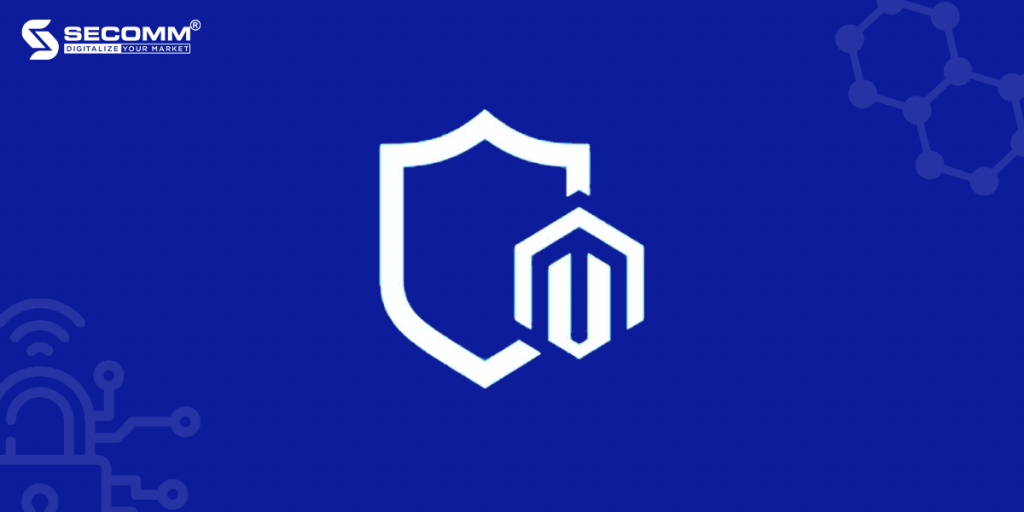
Meanwhile, the publisher continuously updates M2 to increase the system’s security. For example
- Improved password encryption (SHA-256) makes the system more difficult to compromise.
- Argon2UD13 support through PHP sodium extension (version 1.0.13) helps protect the system’s database
- 2-factor authentication for the administrator account to limit impersonation to steal website data.
Why do businesses hesitate to upgrade their website to Magento 2?
Magento 1 still meets current needs
M1 continues to meet enterprise eCommerce systems’ interface, functional systems, and management system requirements. As a result, businesses continue to use M1 rather than upgrading to M2. At the same time, the Magento technical community continues to support the utilities for M1 enthusiastically.
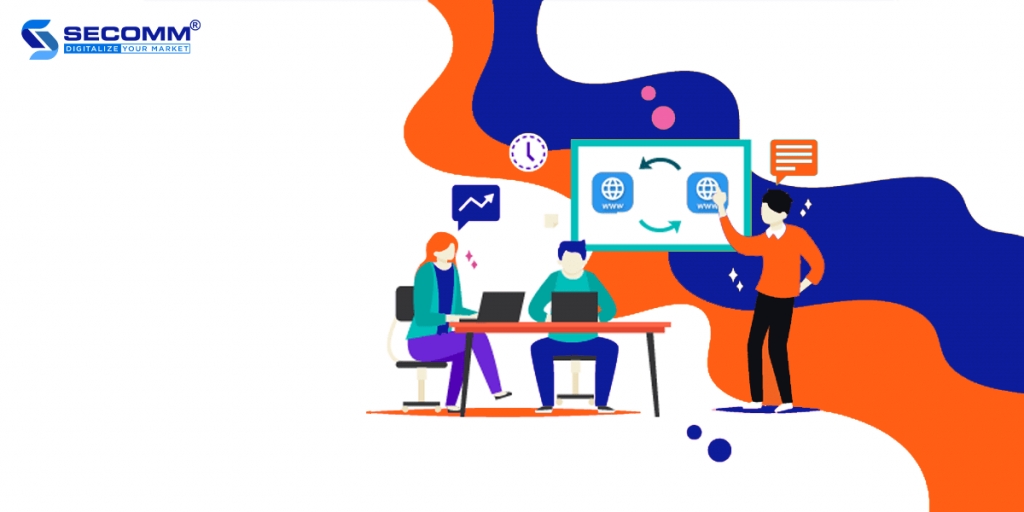
Magento 2 appears to be quite new to businesses.
Although Magento 2 provides many improved utilities, its technologies are still relatively new for many companies, particularly those in countries that have lagged behind eCommerce market growth.
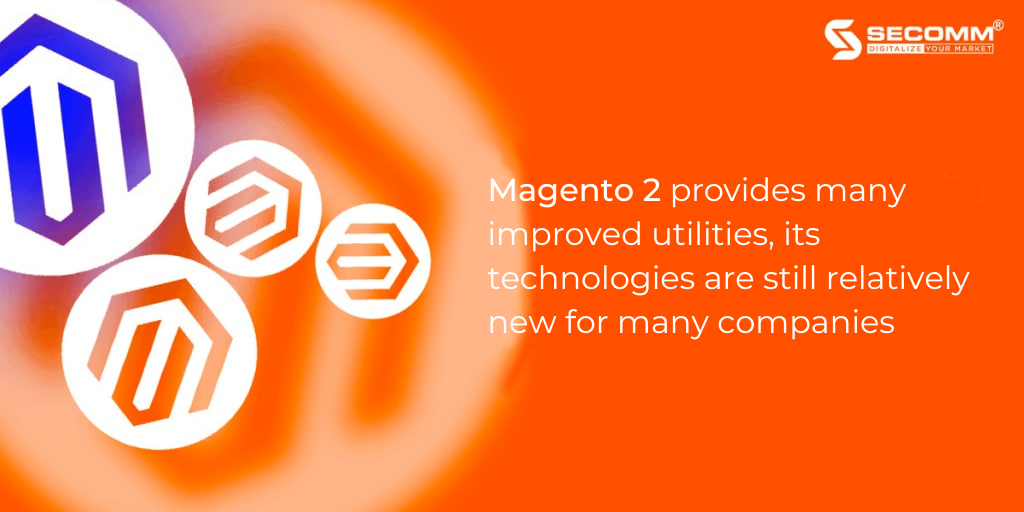
It takes time and money to upgrade.
Upgrading from M1 to M2 is difficult because the technology infrastructure is entirely different between the two versions. As a result, website developers will require a significant amount of time to migrate all functions and data from M1 to M2, ranging from 1 to 3 months on average.
In addition, businesses require a technical team with expertise in new technologies to manage the system and efficiently upgrade the website. As a result, the upgrade costs more, ranging from $5,000 to $10,000 or more, depending on the system’s complexity.
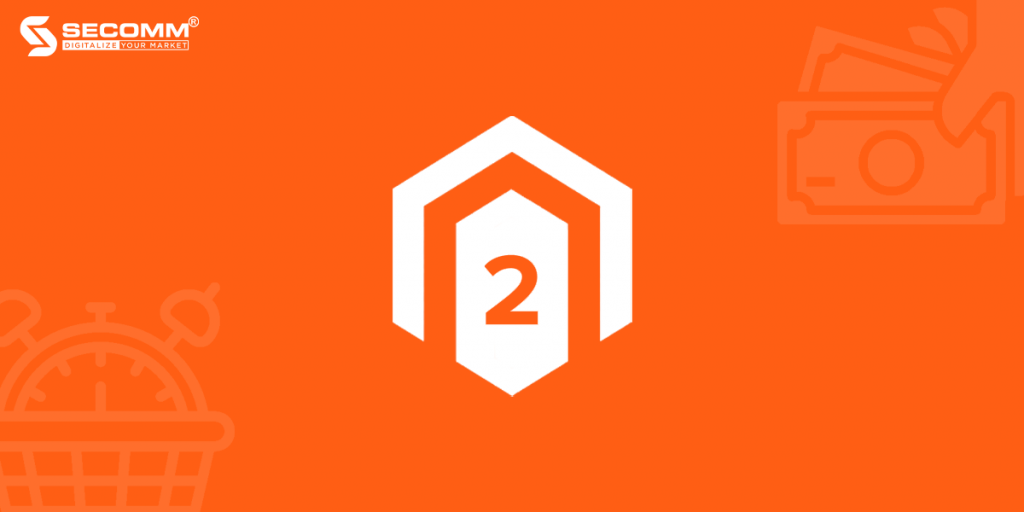
Although M2 outperforms M1 in every way, many businesses are hesitant to upgrade their websites to M2 due to various issues. However, upgrading the website to M2 is unavoidable in the long run due to the growing gap between the two versions.
Our company – SECOMM, has been partnering with many big enterprises such as An Nam Group (Vietnam), Jasnor (Australia), and Changi Airport Group (Singapore). As a result, we are aware of the challenges and worries firms face while developing an eCommerce website system as well as upgrading their websites from M1 to M2.
Get in touch with us now for FREE eCommerce development consultancy and solutions
 2
2

 2,590
2,590

 0
0

 1
1
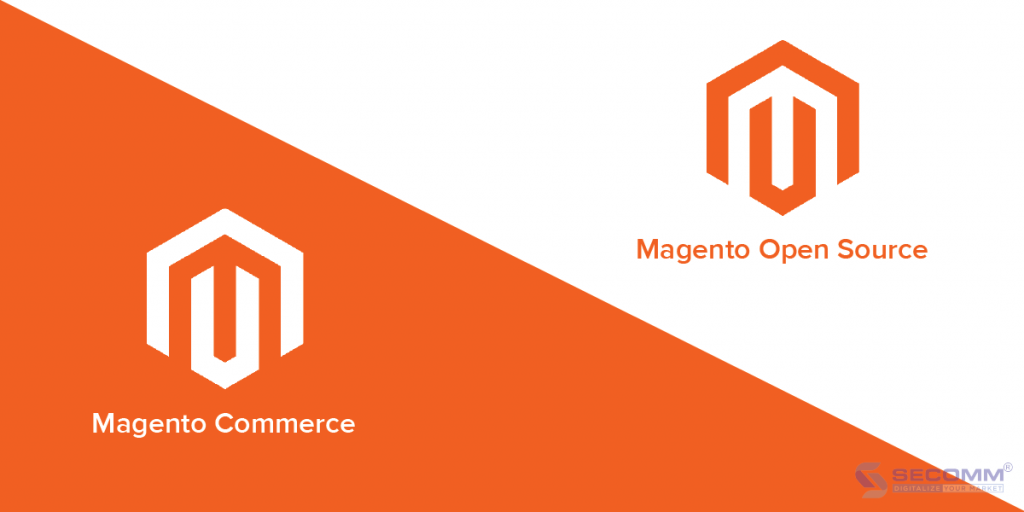
MAGENTO OPEN SOURCE VS MAGENTO COMMERCE REAL COMPARISON
With over 200,000 websites worldwide, Magento is today’s most widely used eCommerce platform. Magento is always the best choice for businesses to use because of the benefits of open source code and specialized features for the eCommerce market.
Businesses must carefully study the strategy and consider the needs of the website system when deciding between Magento Open Source and Magento Commerce to implement eCommerce on the Magento platform.
Magento Open Source là gì?
Magento Open Source was initially known as Magento Community Edition (CE), a free version of the Magento open source platform. This version provides a flexible framework for building eCommerce websites, which is popular among many businesses.
.

What is Magento Commerce?
Magento Commerce, formerly known as Magento Enterprise Edition (EE), is a website system used by large businesses with complex website system requirements.
This instance provides an on-premises solution as well as a hosted solution as a service (Magento Commerce Cloud), which aids in website performance and user experience. As a result, the annual fee for using this version is $24.000.

Comparison between Magento Open Source and Magento Commerce
Hosting
The platform will charge an additional $2.000/year for the included hosting service when using Magento Commerce to ensure that the business’s website system is constantly updated and upgraded, allowing it to handle high traffic and bills of lading more quickly.
Meanwhile, Magento Open Source is free to select a hosting provider that meets the business’s requirements and budget.
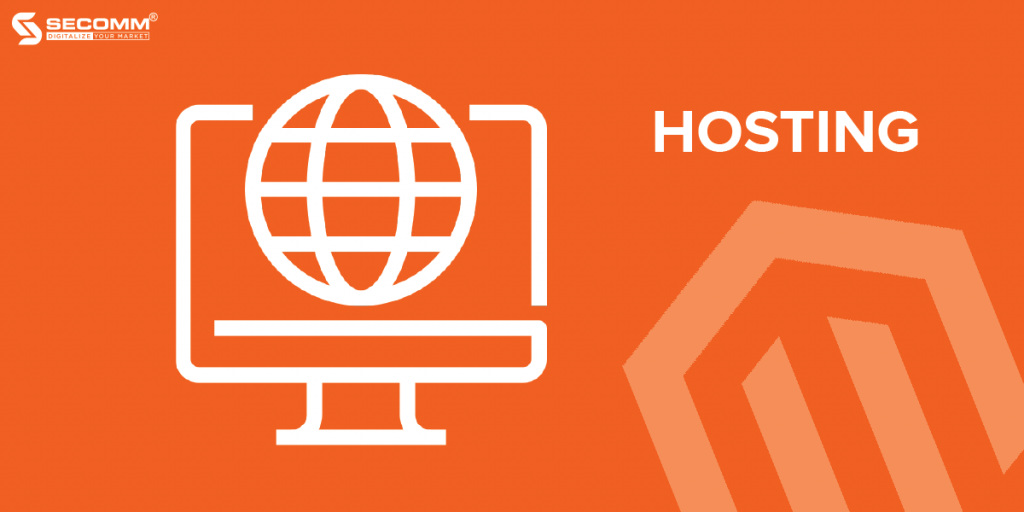
Feature
The following table compares the features that distinguish the two versions of Magento:
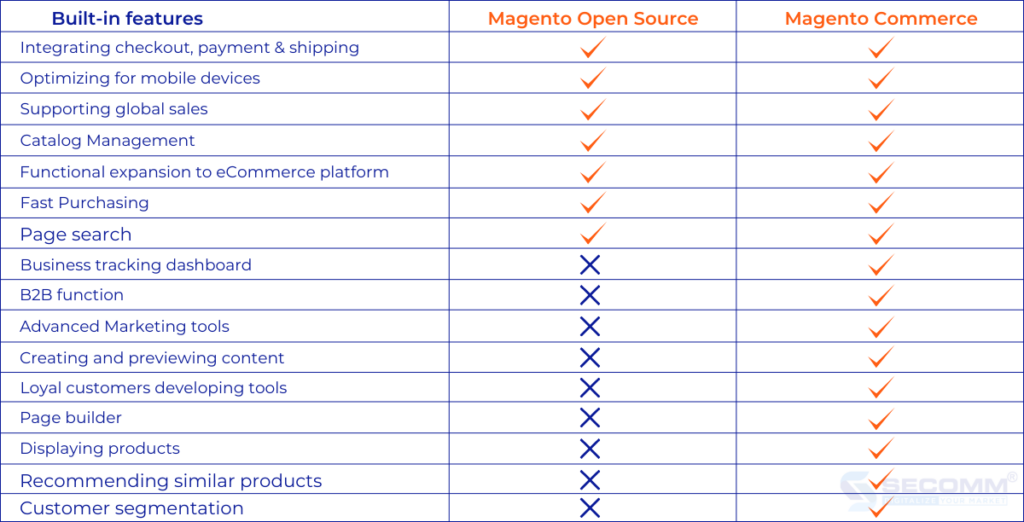
Magento Open Source has fewer features than Magento Commerce because it is a free version. Businesses, on the other hand, businesses can build the necessary functions themselves using extensions from the Magento ecosystem, the community of extension developers, or the project developers with whom Magento collaborates.
Cost
Magento Open Source will require a lower investment than Magento Commerce, from hosting and domains to website development. Nevertheless, the technology infrastructure is the same, so the costs of interfaces and extensions are calculated similarly.
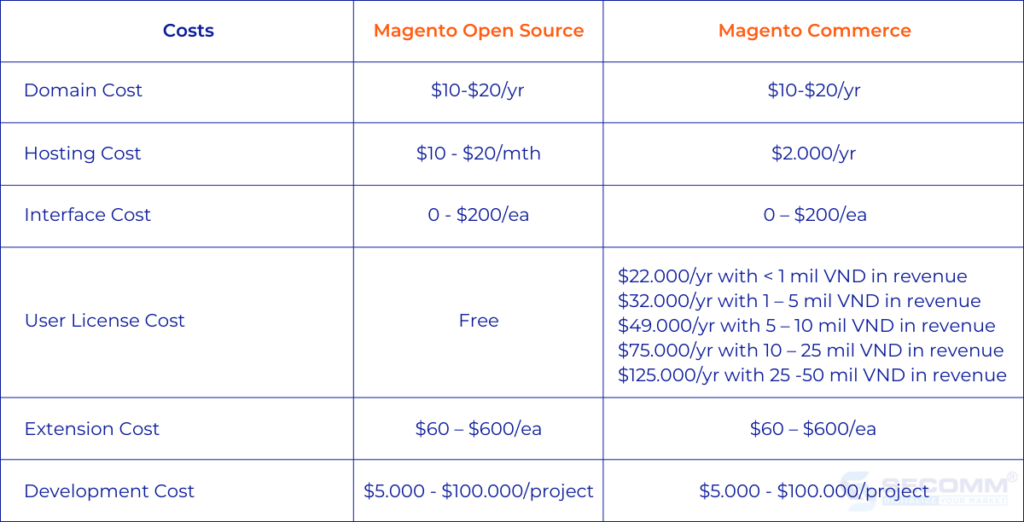
Technical assistance
While Magento Commerce provides global technical support, including cloud service integration, Magento Open Source is not directly supported by the Magento technical team. However, the current Magento Open Source website developers continue to ensure expertise so that the business website is constantly updated and effectively operated.
Should businesses choose the Magento Open Source or Magento Commerce version?
Magento Open Source will be ideal for startups, SMEs (small and medium enterprises), businesses new to eCommerce, and even large corporations that do not yet require Magento Commerce’s advanced functionality system. Because using Magento Open Source is advantageous:
- Spending less money: Eliminate license costs, opt for more affordable hosting, and avoid paying for unnecessary specialized functions.
- Choosing to develop essential business features: Creating specialized functions to address industry and product-specific issues.
- Appropriate for all stages of business growth: Businesses can create basic features and then gradually improve them.
Meanwhile, Magento Commerce will be appropriate for large businesses because:
- Complex functional systems are available: such as Advanced Marketing, Bill of Lading, and Delivery Process Management, to meet global sales needs.
- Dedicated Hosting Service for Websites: Using the same service from Magento developers will ensure that the website works more efficiently.

Choosing the best Magento version will be determined by each company’s long-term eCommerce strategy. However, it is also critical to implement those versions. They must collaborate with professional Magento developers to consult on and implement the best eCommerce solution.
With in-depth experience and developing many complex eCommerce systems on Magento, SECOMM understands the obstacles in choosing a platform and implementing Ecommerce businesses face.
Get in touch with us now for FREE eCommerce development consultancy and solutions
 2
2

 4,862
4,862

 0
0

 1
1
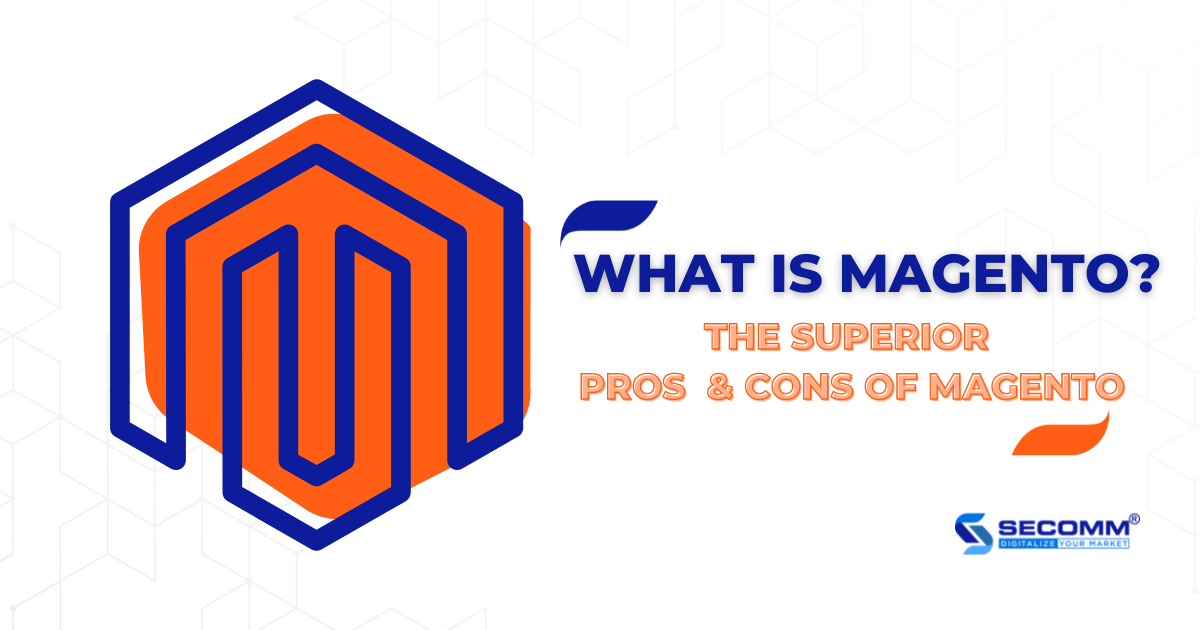
WHAT IS MAGENTO? THE 7 IMPORTANT PROS AND CONS OF MAGENTO
Along with the eCommerce market growth comes an increase in business demand for a separate eCommerce website system to maximize online business.
The platform’s role in developing and operating an effective eCommerce website system is enormous because choosing the right platform will help businesses save time in building a team, saving system development costs, reaching potential customers, boosting sales, and seizing long-term sustainable development opportunities.
Among today’s popular platforms such as Shopify, BigCommerce, WooCommerce, and others, Magento is widely regarded as the best platform for developing eCommerce websites, with over 186,000 websites in use worldwide.
What is Magento?
This is an open-source platform designed specifically for the eCommerce industry. In addition, it is the most challenging source code platform in the PHP programming language. As a result, Magento can handle a company’s specialized needs in a constantly changing and evolving market like eCommerce.
Many major brands and corporations, including HP, Asus, Puma, and Walmart, have used the platform. In addition, some famous brands in Vietnam use Magento websites, including CellphoneS, Vua Nem, Kids Plaza, Mobile Viet, and so on.
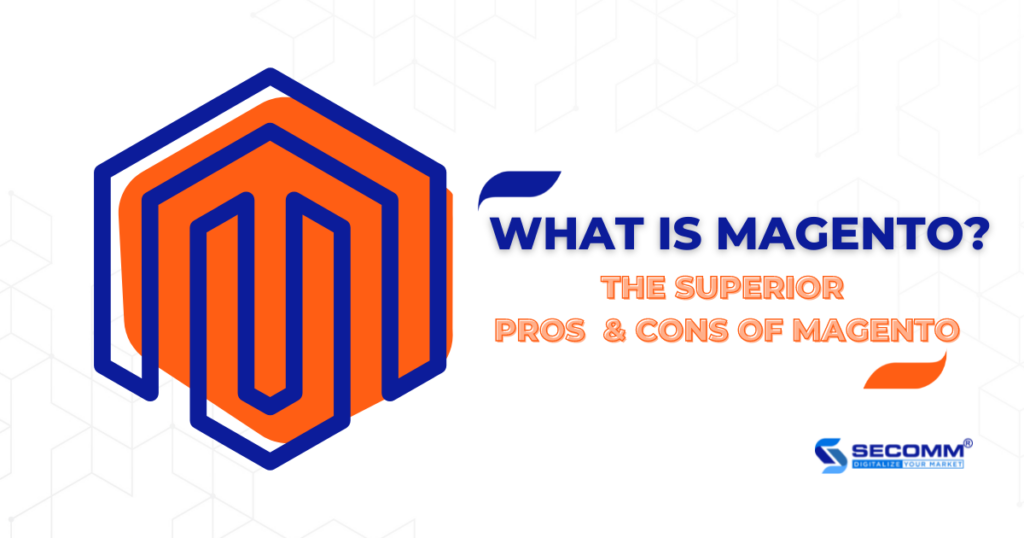
Classification
Magento currently offers two versions: Magento Open Source and Magento Commerce.
Magento Open Source
Magento Open Source was initially called Magento Community Edition, a free version of Magento. This version provides a “framework” to build eCommerce websites flexibly, so it is very popular with many businesses.
Some websites use Magento Open Source in Vietnam, such as Canifa, Kids Plaza, Bach Long Mobile, etc.

Magento Commerce
Magento Commerce was previously known as Magento Enterprise Edition. This version is appropriate for significant businesses that require a website system with complex functions.
In addition, this edition provides an on-premises or a hosted solution as a service (Magento Commerce Cloud), which aids in website performance. The minimum fee for using this version is $24,000 per year.
The brands using Magento Commerce in Vietnam are CGV, Bibo Mart, Rohto, etc.

The Pros
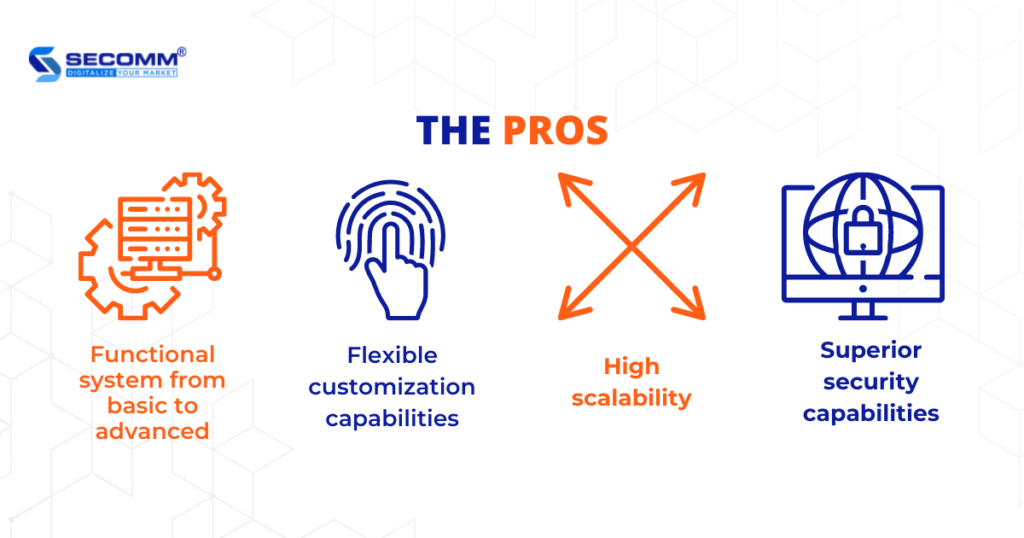
Functional systems from basic to advanced
Magento includes all of the features required for a complete eCommerce website, including category management, content management, sales management, marketing management, and customer management, as well as analysis and reporting.
In addition, Magento owns many extensions with advanced features such as Headless Commerce, PWA (Progressive Web Apps), MSI (Multi-Source Inventory), ElasticSearch, etc to meet all eCommerce needs for businesses.
Furthermore, Magento has a global technical support community comprised of many experienced experts and professional development units to assist with meeting all business requirements.
Flexible customization capabilities
Magento possesses all the advantages of an open-source platform with flexible customization capabilities. Owning and controlling the entire source code, in particular, allows businesses to customize parts of the code in the system, easily update, or even develop new functions based on each business specificity.
High scalability
In addition to customizing, Magento also has very useful website scalability. Magento allows businesses to scale from one website to many websites, one store to many stores, but the management is still on the same system. Besides, Magento supports multi-language and currency conversion, helping businesses expand globally.
Superior security capabilities
Magento’s high security is also an outstanding advantage, with the ability to control the system regularly, propose security solutions, improve security for administrators, and prevent bots or unauthorized malware, among other things. As a result, this platform assists businesses in reducing potential risks associated with the data and transaction processes.
The Cons
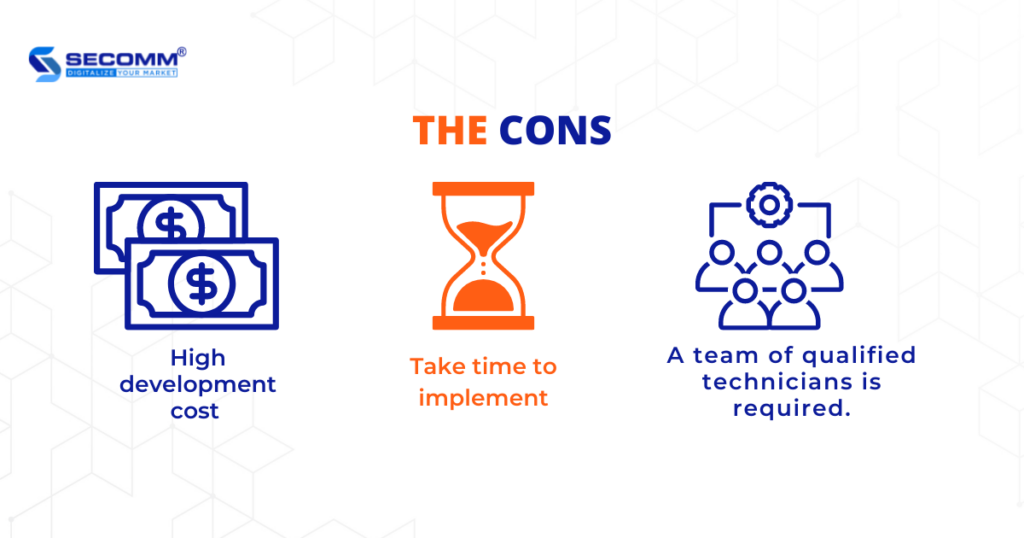
High development cost
The cost of owning a Magento website is high due to its many outstanding benefits, such as the functional system, customizability, scalability, and good security. However, depending on the system’s complexity, a website built on the Magento platform costs between $10.000 and $100.000.
Take time to implement
A comprehensive Magento project requires implementation time ranging from 3 months to 1 year. A complete Magento project requires implementation time ranging from 3 months to 1 year. As a result, it slows down businesses’ digital transformation processes and makes it difficult for them to keep up with competitors’ development rates and market trends.
A team of qualified technicians is required
Businesses require a technical team with high expertise and experience with the Magento platform to build and operate an intensive eCommerce website system customized to the unique characteristics of each product and category.
As a whole, Magento is an eCommerce platform that is appropriate for all types of businesses, including startups, SMEs (small and medium enterprises), and large corporations. However, budget, time, and professional team issues have caused many SMEs businesses to be hesitant to use Magento to develop eCommerce websites. That is why Magento frequently be used in large corporations to build complex eCommerce systems.
Our company – SECOMM, has been partnering with many big enterprises such as An Nam Group (Vietnam), Jasnor (Australia), and Changi Airport Group (Singapore). As a result, we are aware of the challenges and worries firms face while developing an eCommerce website system.
Contact SECOMM now for a free consultation on detailed eCommerce system development solutions!
 2
2

 3,255
3,255

 0
0

 1
1
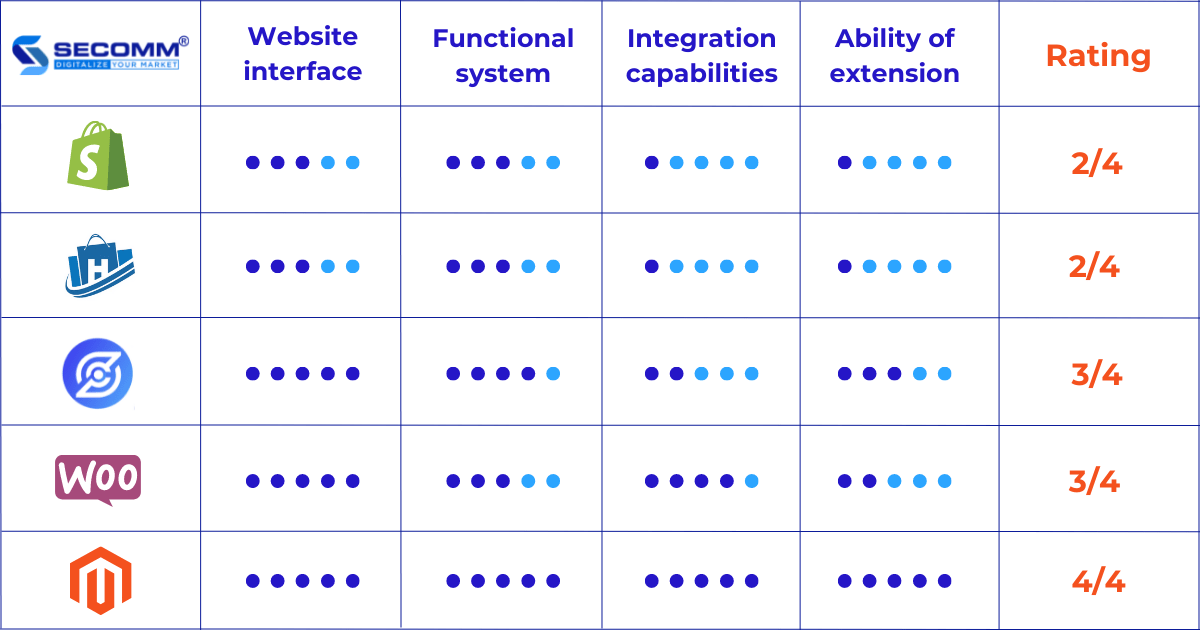
TOP 5 ECOMMERCE PLATFORMS FOR EGROCERY
With the boom in recent years, ecommerce is a potential business form pursued by many businesses, especially egrocery stores. According to Statista, the grocery ecommerce market in the United States is likely to exceed $24 billion by 2023.
Realizing the potential of the egrocery market, several businesses have deployed grocery ecommerce websites early and experienced breakthrough growth, such as Grofers (Blinkit) and BigBasket in India, Bach Hoa Xanh, An Nam Gourmet, Farmer’s Market, WinMart, and Organica in Vietnam.
The common thing that makes the success of the above brands lies in the ecommerce platform. Therefore, to develop and operate an effective ecommerce website, the role of platforms is enormous.
So which ecommerce platforms are suitable for the grocery industry?
Platform selection criteria
User interface and administration interface
For the website interface, in addition to meeting basic needs such as UI/UX standards and showing the brand’s characteristics and the eGrocery industry, businesses also need to focus on the presented product images. Therefore, on the website, everything needs to be synchronized and precise.
The administrator interface (admin) must be easy to use, navigate, control, and manage all data in the system.
Functional system
With eGrocery, the system of ecommerce features needs to be diverse from basic to advanced, solving complex characteristics of the grocery industry such as products with multiple units, weight difference, and price volatility, export-import complex warehouse, and synchronized data throughout the system.
Some functions required in a grocery ecommerce website system such as:
- Primary functions: Meet the most basic needs when operating an ecommerce system, such as order management, checkout, payment, shipping, etc
- Advanced Functions: Functions that enhance the consumer experience and accelerate the shopping process such as order tracking, abandoned cart recovery, similar product recommendations, product search fast products, multi-layered product portfolio, etc
- Specific functions: Functions that help to thoroughly solve the difficulties of implementing specialized grocery ecommerce, meeting the needs of customer segments and businesses such as fast delivery, choice of time delivery point, etc
Integration capabilities
To have a seamless online volatility store system with multiple sales channels, businesses must integrate their ecommerce website with other payment services, shipping services, management software, analysis, report, and distribution systems:
- Payment: Integrate various payment methods from domestic cards to international cards, such as payment gateways (Paypal, Stripe, OnePay), e-wallets (Momo, ZaloPay), etc.
- Shipping: Integrate with international shipping providers like DHL Express, Fedex, Ups, USPS, and popular shipping providers in Vietnam like Fast Delivery, Economy Delivery, Ninja Van, etc. With order tracking applications to help process and operate the delivery processes
- Management software: Easily integrate CRM, ERP, and POS software to get a seamless connection on all supply channels from offline to online
- Analysis and reporting: Integrate analysis and reporting software such as Business Intelligent, Google Analytics, Facebook Pixel, etc.
This integration helps businesses overcome the limitations of the “rice-powered” process, increase the automation of the system, limit business mistakes, and ensure high accuracy and performance.
Ability to extension
To accompany businesses to develop over time, from startups, and SMEs (small and medium enterprises), to large corporations, from B2B, B2C, and D2C business models to B2B2C, commerce electronics platforms must be highly scalable. High scalability helps meet all future business growth needs, such as multi-site, multi-country, and multi-currency, all manageable on “one screen.” Not only that, but highly scalable platforms also support businesses to operate the system stably regardless of the traffic in promotion campaigns.
Evaluate 5 ecommerce platforms for egrocery business based on each criterion
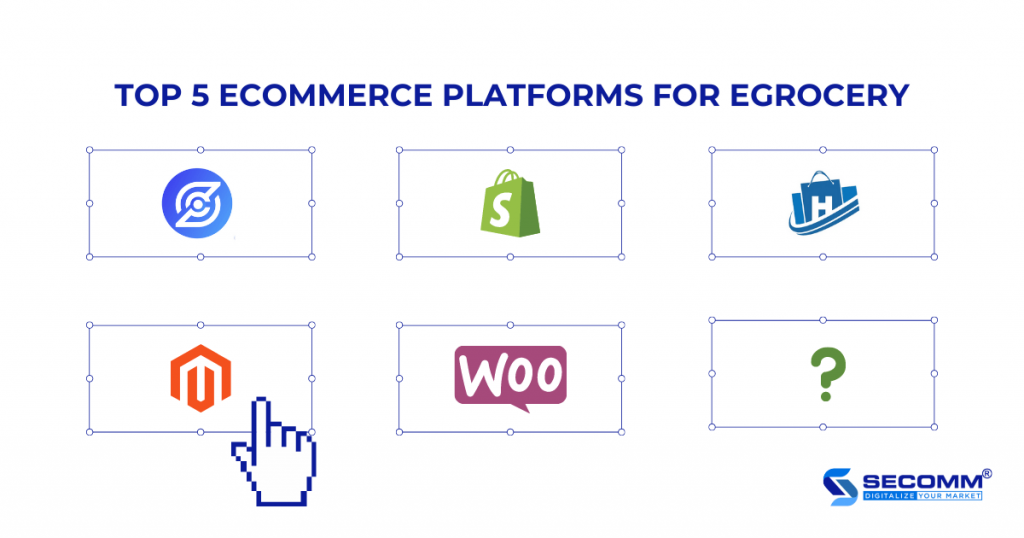
Ziel Commerce
Ziel Commerce is a readymade grocery ecommerce platform with all the features designed to support an online grocery store business.

Website interface
Ziel Commerce provides a repository of themes specifically for the grocery industry, allowing businesses to customize according to their needs, helping to both reflect the characteristics of the industry and position the brand image.
Remarkably, the interface for administrators is also invested by the founders to make it most accessible for businesses to use. But currently, Ziel Commerce is not popular in the Vietnamese market, so there is no Vietnamese version for businesses.
Functional system
As a platform designed specifically for the eGrocery industry, Ziel Commerce can meet all the most specialized needs of businesses, including fundamental to advanced functionality systems and existing industry-specific solutions.
Integration capabilities
Ziel Commerce has a significant drawback in integrating the website system. In addition, this platform only supports add-ons available in its ecosystem, so businesses will not be able to link with the ERP, POS, CRM, BI, etc., systems in use. Therefore, when using Ziel Commerce, companies need to transfer all existing data to the server of this platform.
Ability of extension
Although it does not own the source code, Ziel Commerce is still a highly appreciated platform for its scalability compared to SaaS platforms. Ziel Commerce supports businesses to expand their ecommerce website system from one to many stores/websites, multi-language, multi-currency without many obstacles. However, in the long run, Ziel Commerce cannot support businesses to expand or develop new functions because firms cannot affect the source code; if it affects it, it will cause instability for the commercial website system.
→ Rating: 3/4
Ziel Commerce provides an almost comprehensive online grocery store website building solution for businesses, from website interface and functional system to scalability. However, the implementation cost is relatively high, about $50,000/project in 6 months. Therefore, Ziel Commerce is only popular with retail chains, has high functional demand, and operates mainly abroad. However, when using Ziel Commerce, businesses should consider adding the platform’s integration, limiting instability in the operation when 3rd party systems are not compatible with the platform.
Shopify
Shopify is a SaaS ecommerce platform favored by the international ecommerce business community because of its fast implementation time and reasonable starting cost.
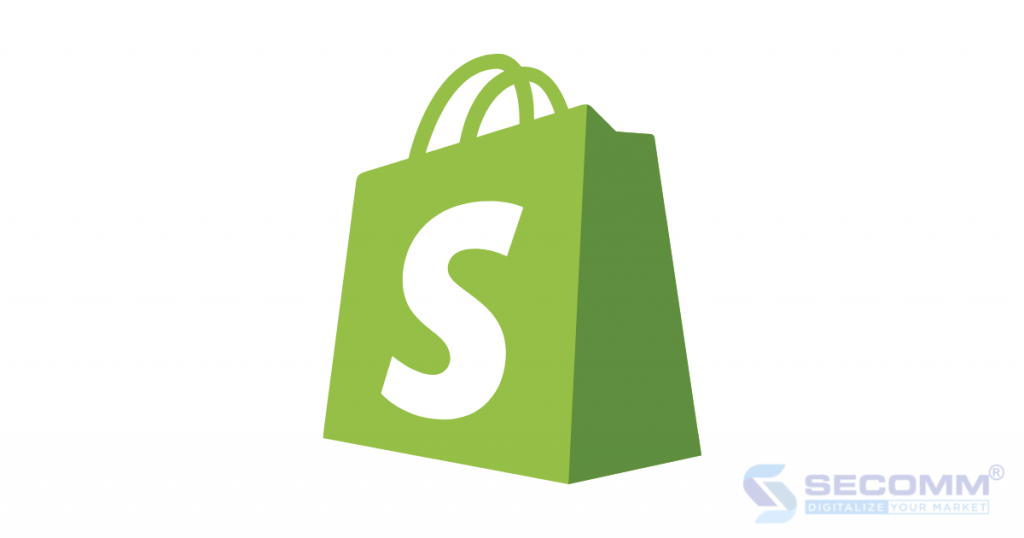
Website interface
Shopify provides a variety of interfaces, including grocery industry and UI/UX standards, but cannot be edited according to the characteristics of the business.
Functional system
Shopify’s functional system is relatively complete, meeting the basic needs of businesses. But to use advanced functions, companies have to pay a certain amount of money every month, leading to an increased cost of using the functional system. In addition, even Shopify can barely provide eGrocery industry-specific resolution functions.
Integration capabilities
Because it is a SaaS platform, businesses cannot affect the source code, and it is not easy to integrate with many 3rd parties. Companies can only integrate utilities provided by Shopify or a platform partner.
Some utilities that companies can integrate with Shopify include:
- Payment: Paypal, Stripe, SagePay, AliPay Global, etc
- Shipping: DHL Express, USPS, UPS, etc
- Administration: Microsoft Dynamic 365 (ERP), Oracle NetSuite (ERP), Acumatica (ERP), etc
- Marketing: Google Tools, MailChimp, Facebook Pixel, etc
Ability of extension
Similar to the ability to integrate, the scalability on Shopify is not high because businesses cannot influence the source code to edit and upgrade the website. Therefore, online grocery businesses can only use Shopify for the first time.
→ Rating: 2/4
Shopify is only suitable for businesses new to the ecommerce market, startups, or SMEs (small and medium enterprises) because of the reasonable development cost and time to deploy an online grocery store business website.
Haravan
Founded in 2014, Haravan is an ecommerce platform based on Shopify. Currently, Haravan is a popular platform in the Vietnamese market with more than 50,000 business people and trusted brands.

Website interface
Haravan has many standard UI/UX interfaces suitable for the grocery industry, including free and paid. At the same time, the interface for administrators supports Vietnamese and is easy to use, so businesses do not face many difficulties when using it.
Functional system
Haravan provides many utilities – functions for online grocery stores in Vietnam.
In addition, similar to Shopify, to use more advanced functions, businesses have to pay a monthly application fee of about 100,000 VND/month/app.
However, businesses can’t find parts that deal with the grocery’s specifics in Haravan’s app store and can’t develop in terms of specific functions. Enterprises can only use the functions included in the package and app store.
Integration capabilities
For integration capabilities, Haravan can integrate with Haravan’s partners such as transportation (Economic Delivery, Fast Delivery, Ahamove, GrabExpress, etc.), payment (Ngan Luong, VNPAY, Napas, PayPal, etc.), etc.).
It is difficult for businesses to integrate for 3rd party utilities outside Haravan’s ecosystem on their ecommerce website.
Ability of extension
As for the extension of the ecommerce website system, Haravan can only support the multi-language – currency but cannot expand from one to many websites/stores. It is challenging to manage all the data on a foundation.
As the business gradually grows and expands, Haravan will no longer be functional enough to maintain an online grocery store business. As a result, companies are forced to switch to more specialized platforms such as Magento, WooCommerce, and OpenCart. But, of course, switching platforms will create many other problems such as costs, time, personnel, etc.
→ Rating: 2/4
Similar to Shopify, Haravan is only suitable for businesses new to the ecommerce market, startups, and SMEs. But Shopify can support online grocery business globally, and Haravan only stops at the Vietnamese market.
Woocommerce
WooCommerce is an open-source platform in the form of a WordPress plugin, allowing businesses to use it completely free.
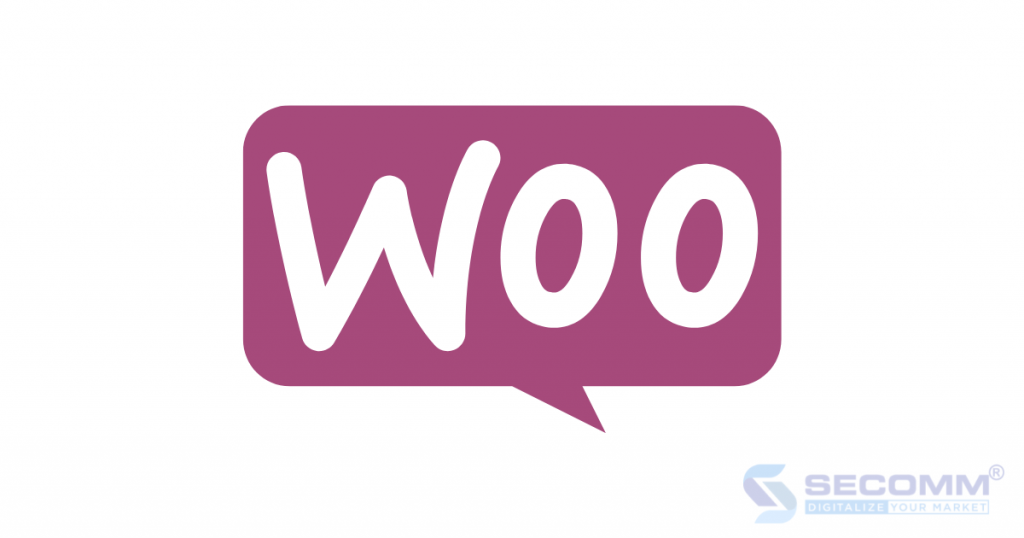
Website interface
WooCommerce and the community provide businesses with various themes designed for the grocery industry. At the same time, this platform also allows influencing the source code to customize according to needs, helping businesses quickly convey brand messages and images.
Since WooCommerce is a WordPress plugin, the admin will continue to manage the website on the WordPress interface itself. This makes it easy for businesses using WordPress to adapt, use, and navigate on the WooCommerce dashboard.
Functional system
WooCommerce supports a variety of features, from basic to advanced. However, this platform has some limitations on features specific to the grocery industry because interfering with developing these functions will easily cause instability for the website system.
Integration capabilities
Thanks to the advantages of the open source platform, WooCommerce has flexible customization capabilities and supports integration with many 3rd party utilities.
In payment, businesses can use amount plugins such as Stripe, PayPal, Apple Pay, and Square to their ecommerce website system with high security and safety. In addition, companies can integrate with many shipping providers such as Fedex, Ups, USPS, and DHL Express. The WooCommerce platform also allows businesses to integrate with management software such as Odoo, Square POS, WP ERP, and Marketing software such as Google Listings, Google Ads, and Facebook Pixel to support businesses in effective business management. More fruitful.
Ability of extension
Contrary to the integration capabilities, the extensibility of WooCommerce is not appreciated. Because the system is easily overloaded with plugin themes, and the number of products does not exceed 2000 SKUs (Stock Keeping Unit). Therefore, businesses wishing to expand their website system need to consider when using this platform in the long run.
→ Rating: 3/4
WooCommerce is the right platform for grocery businesses that use WordPress and are looking to develop an ecommerce system. But when using WooCommerce, companies should consider the limitations of integration, extensibility, and customizability of specific features.
Magento
Magento is a popular open source commerce platform in ecommerce, with nearly 200,000 websites in use. Currently, Magento has 2 versions: Magento Open Source (free) and Magento Commerce (paid).
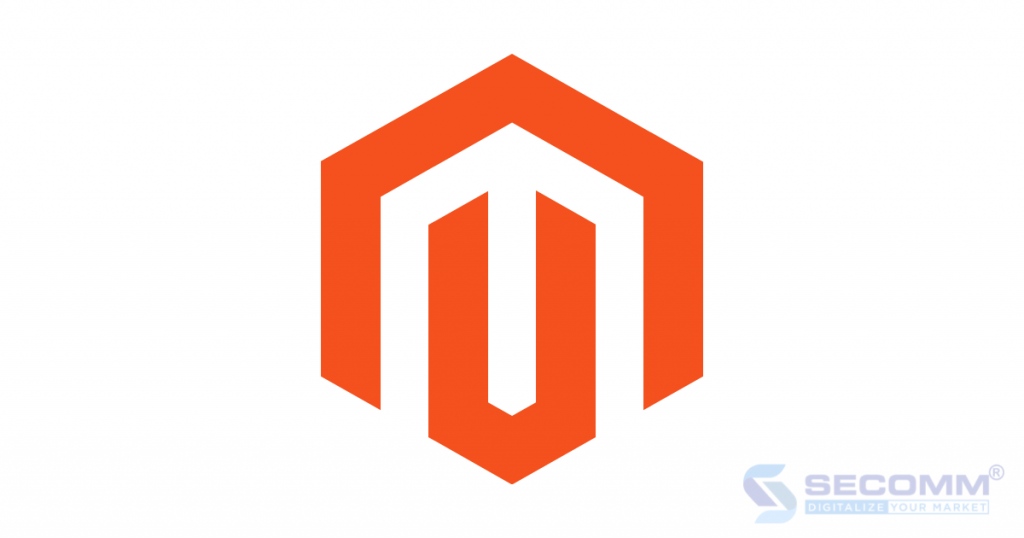
Website interface
Although Magento does not own a rich theme store like other ecommerce platforms, businesses can look to the developer community, market (Envato), or design their own. Having many options when designing the interface helps Magento websites to have their uniqueness, avoid overlapping the interface with many different websites and bring a higher shopping experience.
Previously, the admin interface on Magento 1 was often considered difficult to use and took a long time to adapt. As a result, Magento publishers developed Magento 2 with a more intuitive and easy-to-navigate dashboard to overcome this problem.
Functional system
The Magento platform has a highly diverse system of features from basic and advanced to industry-specific to help grocery businesses quickly build and develop a sustainable system.
A basic functional system, including catalog management, product management, customer management, report analysis, etc., helps meet the basic needs of a convenient online grocery store business.
In particular, Magento also has many advanced functions for ecommerce, such as multi-language support, multi-currency, multi-store, PWA, MSI, ElasticSearch, etc. Shopping happens faster.
Magento does not have built-in features only for the grocery industry regarding specific features. Still, businesses can quickly build a system of particular features such as category classification, quick search, and delivery time selection thanks to flexible customization on open source code.
Integration capabilities
Thanks to the advantages of the open source platform, the Magento website can be easily integrated with any 3rd party utilities, from payment, shipping, and business administration.
Regarding payment, Magento easily connects with today’s popular payment methods such as card payments (domestic cards, VISA, Mastercard), e-wallets (MOMO, Zalopay), and payment gateways (OnePay, VNPay, etc.) PayPal) or COD, which helps to diversify payment methods.
Magento can integrate with shipping providers such as Fast Delivery, Economy Delivery, Viettel Post, and order tracking applications.
Magento can be integrated into back-office management software (ERP, CRM, POS) such as SAP, Salesforce, and Oracle to help operate all resources and processes seamlessly in the enterprise.
In addition, Magento also supports integration with business analysis tools such as Power BI, Tableau, and Looker and analysis and reporting utilities such as Google Analytics, Google Tag Manager, and Facebook Pixels to exploit all data from the system. As a result, Magento plans to improve its business strategy.
Ability of extension
Magento allows businesses to expand from one website to many different websites on the same system to meet the needs of business development. In addition, with the available support for language and currency conversion from Magento, businesses can build a grocery ecommerce system with content suitable for a diverse audience of customers around the globe.
In addition, open source customization enables Magento developers to build functional solutions specific to the grocery industry. This advantage makes Magento expand the system of capabilities according to each business size, from small businesses to large-scale corporations.
→ Rating: 4/4
Because Magento possesses many outstanding advantages, from website interface and functional system to the ability to integrate and expand, Magento is suitable for a variety of grocery business models from B2B, B2C to B2B2C, a multiform of enterprise-scale such as startup, SME, enterprise (large corporation). However, the time to deploy ecommerce on Magento is usually long – from 6 months to 1 year, with high construction costs of about 50,000 – 100,000 USD/project. At the same time, businesses also need to have a professional team or cooperate with experienced units to develop an effective grocery ecommerce system. Therefore, Magento is popularly used in the community of large-scale businesses that need many functions to increase user experience.
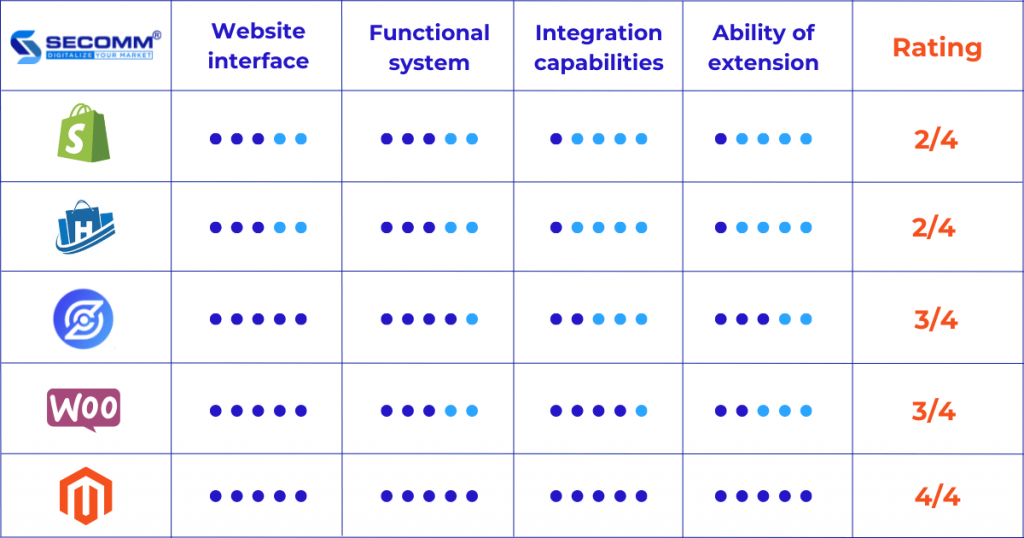
Choosing the right platform is the first and most significant step when building a grocery ecommerce website. Selecting the right ecommerce platform will help businesses save budget and time in building a website while increasing competitive advantage and sustainable growth. On the contrary, choosing the wrong forum will cost businesses a lot of time and budget to deploy and switch platforms. Therefore, companies need to consider the goals and problems in the current model to choose the most suitable platform.
With experience in successfully implementing complex grocery ecommerce systems like An Nam Gourmet, SECOMM understands grocery businesses’ obstacles.
Contact SECOMM now for a free consultation on detailed ecommerce system development solutions!
 2
2

 1,954
1,954

 1
1

 1
1
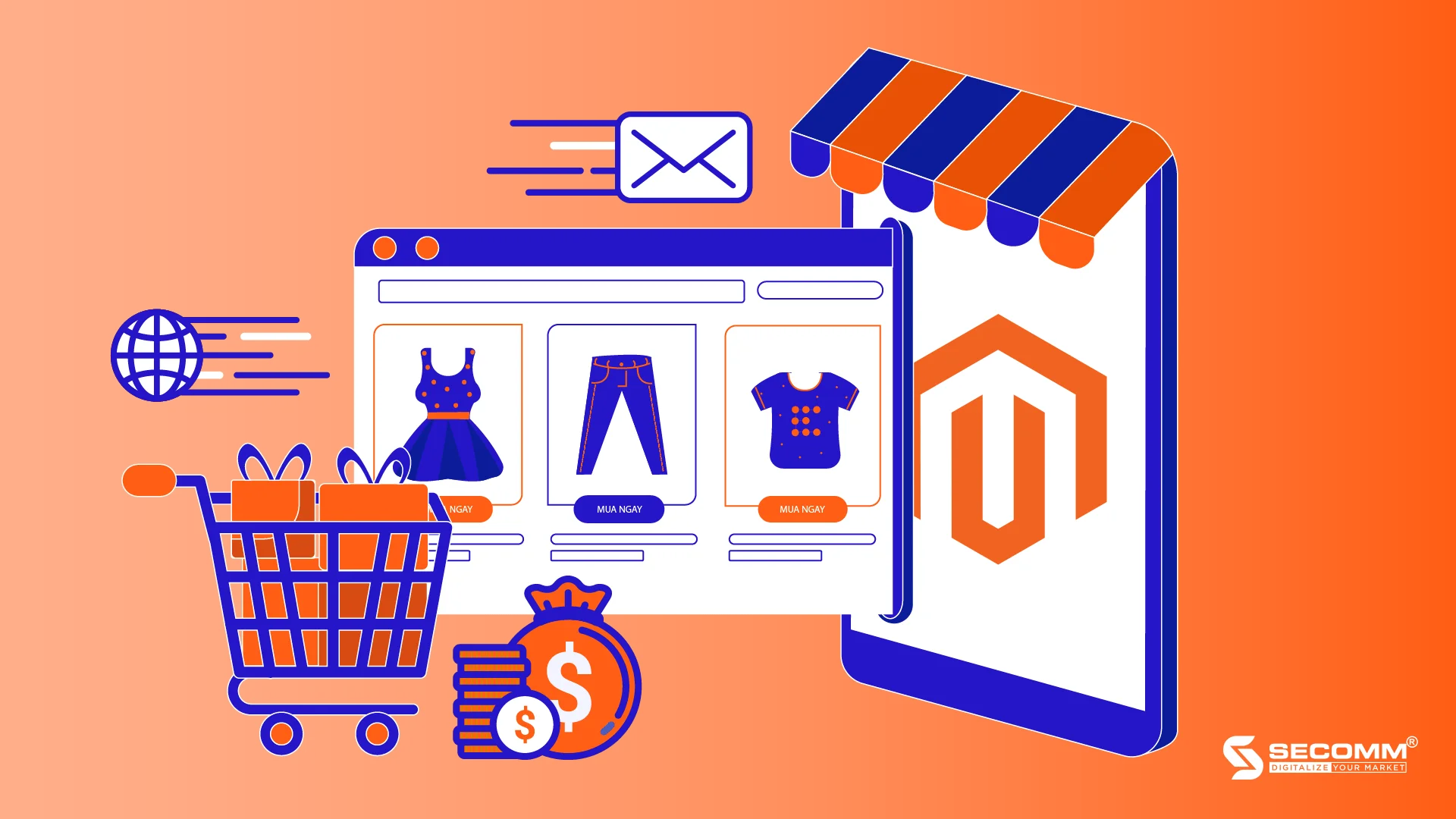
MAGENTO – THE ULTIMATE ECOMMERCE PLATFORM FOR BUSINESS
When deploying an ecommerce website, Magento is the top choice of platform that businesses are aiming for, including global giants like Nike, ASUS, HP, and Burger King, as well as leading Vietnamese enterprises such as Canifa, CellphoneS, Trung Nguyen, and CGV Vietnam.
With outstanding advantages ranging from a diverse ecosystem and flexible customisation capabilities to absolute security, Magento is considered the ‘ultimate boss’ among ecommerce website development platforms today.
So, what are the superior points of Magento?
A ecommerce platform functions from basic to advanced
Magento possesses all the features for a complete ecommerce website:
- Category Management: Control all data and functions related to products, categories, attributes, pricing systems, inventory, images, and videos.
- Content Management: Develop and optimise content for CMS pages (Content Management System), store images, customise themes, and website design.
- Sales Management: Control and operate sales processes, orders, payments, and shipping.
- Marketing Management: Support the building and implementation of marketing programmes with available support tools.
- Customer Management: Manage and collect customer information to enhance the user experience.
- Inventory Management: Continuously meet goods supply for the supply chain with inventory management tools and shipping route navigation.
- Reporting: Exploit data through reporting features on the system to improve and enhance business efficiency.
- Analysis: Support tracking and measuring system performance through integrated tools such as Google Analytics, Facebook Pixels, and Google Tag Manager.
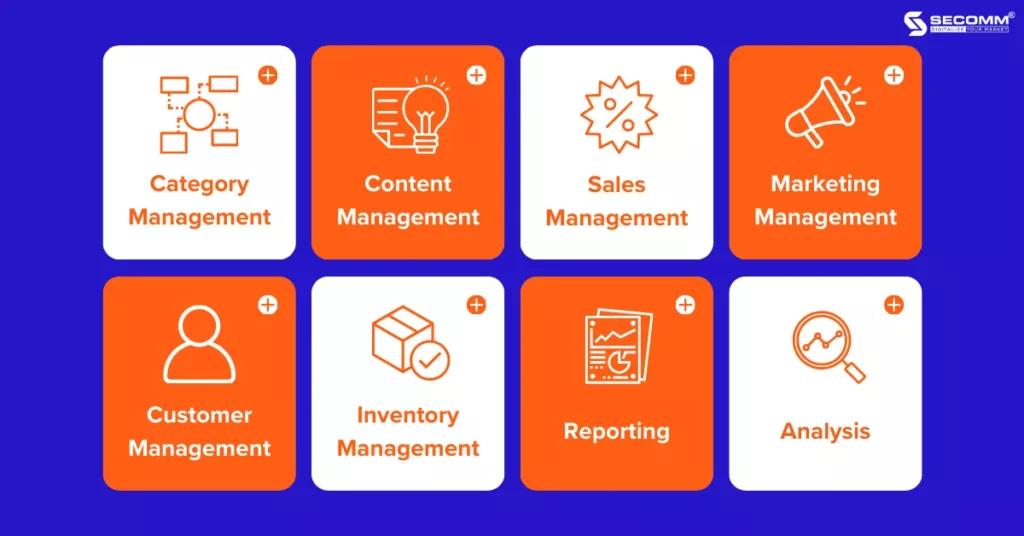
In addition to the basic features of a complete ecommerce website, Magento also owns a diverse system of extensions with many advanced functions in themes, products, marketing, optimal payment solutions, shipping, etc. to meet every operational need and ensure sustainable development of ecommerce for businesses.
When building an ecommerce website, Magento also supports businesses to integrate and link third-party services for efficient ecommerce website operation, such as:
- Payment: Support all forms of payment, from COD, card payments, and e-wallets to online payment gateways, helping businesses diversify the payment experience for customers.
- Shipping: Easily integrate with many shipping units and popular shipping tracking applications to optimise the shipping process for customers.
- Management and operation software: Support the integration of back-office software such as ERP, CRM, POS, etc. to operate human resources more efficiently.
- Business intelligence (BI) analysis tools: Support the integration of business analysis tools such as Power BI, Tableau, and Looker… to improve business strategies for enterprises.
- Omnichannel: Unify all sales channels on the same Magento system to process and control data and seamlessly handle business processes from offline to online.
Furthermore, Magento also has a global technical support community, including many rich experts and professional developers to meet all the requirements of businesses.
High customisation and scalability
The Magento ecommerce website platform possesses all the advantages of open-source software with flexible customisation capabilities to operate the ecommerce website more effectively.
- Customisation: Owning and controlling the entire source code makes it easy for businesses to customise code sections in the system, enabling them to build innovative and improved solutions according to the specific business characteristics of each enterprise.
- Scalability: Magento allows businesses to expand from one website or store to many different websites or stores on the same system. Besides, Magento supports language and currency conversion, helping businesses expand their market to many countries.
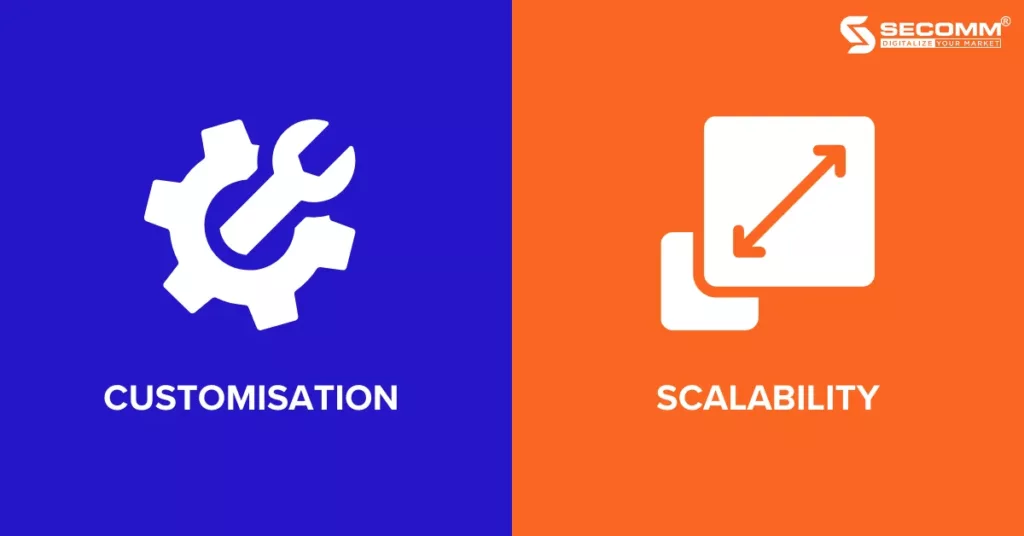
High security
High security is also a superior advantage of Magento compared to other ecommerce website platforms, helping businesses minimise potential risks from data systems and transaction processes on the system.
Some outstanding points of Magento’s security features include:
- Regularly control the system, propose security solutions, and improve website performance.
- Enhanced security for administrators.
- Advanced security for user accounts.
- Ability to block unauthorised bots and codes.

With the advantages of having all ecommerce website functions, from basic to advanced, high customisation capabilities, and high security, Magento is the top choice for businesses when deploying an ecommerce website system. However, issues related to costs, time, and the requirement for a highly specialised technical team make it challenging for many businesses to implement an ecommerce website system with Magento.
Contact SECOMM now for FREE CONSULTATION SUPPORT!
 2
2

 2,499
2,499

 0
0

 1
1
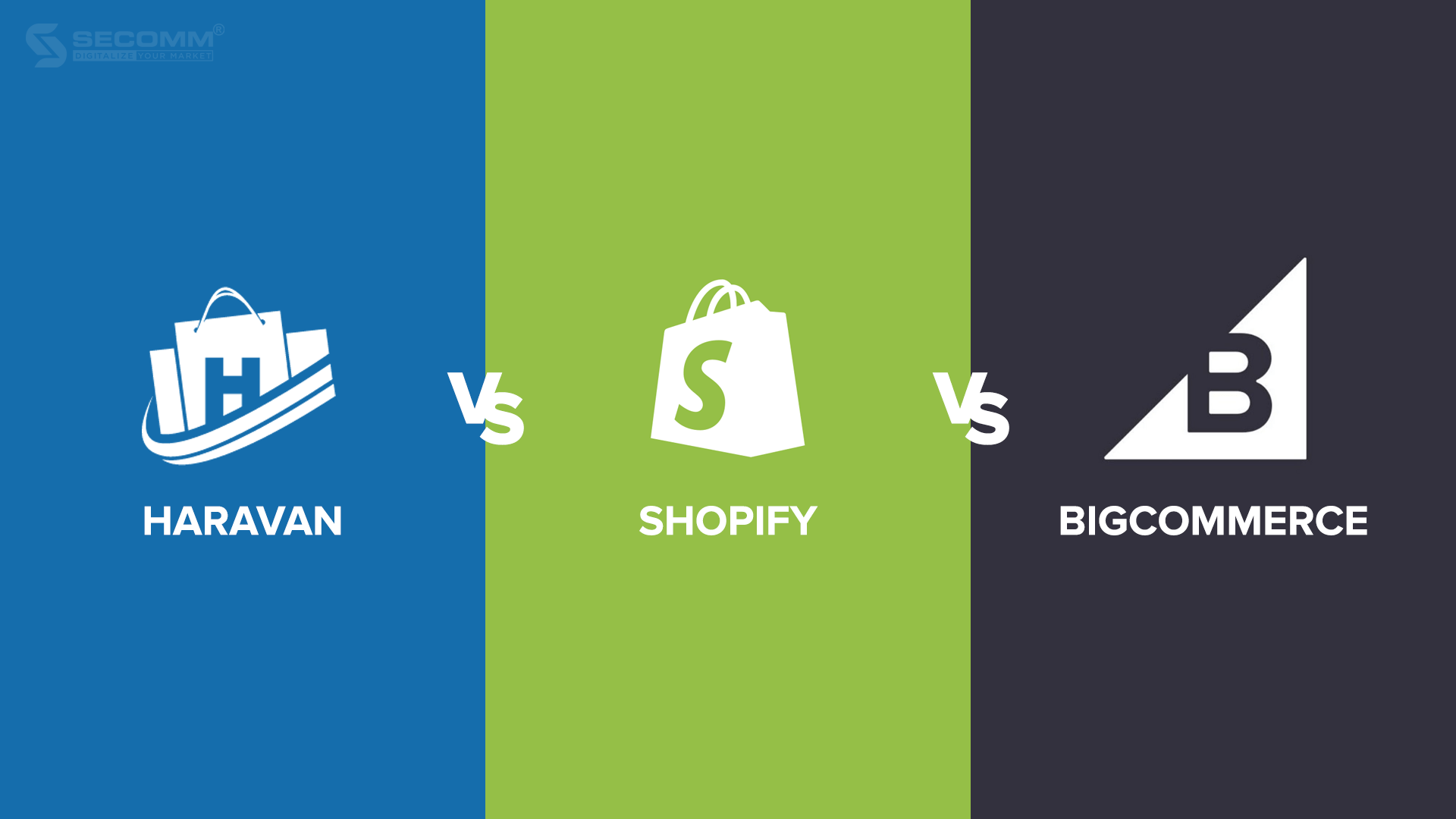
TOP 3 SAAS ECOMMERCE PLATFORMS: HARAVAN, SHOPIFY, AND BIG COMMERCE
Many firms have selected SaaS eCommerce platforms to create e-commerce enterprises for brands because of their essential qualities, which can rapidly install eCommerce at a low cost.
Haravan
In Vietnam, Haravan is the most popular eCommerce platform that allows multi-channel sales. This platform was officially launched in 2014, aims to assist companies in developing professional e-commerce websites at an affordable cost.
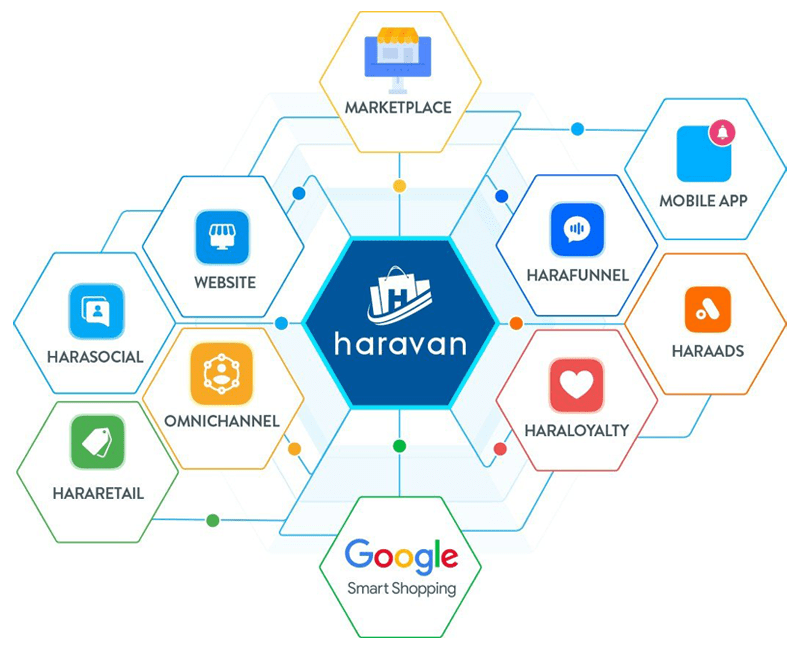
Themes
Haravan provides many UI/UX themes so that firms may select a design that suits the brand’s image. At the same time, many organizations regard the admin interface to be easy to use. However, companies must pay additional fees to raise the number of admin accounts.
Features
Haravan’s essential features, on the other hand, are just enough for businesses to run their web operations successfully but not ideal sufficient for long-term development. In addition, because Haravan is a SaaS platform, organizations find it difficult to customize or expand functionality outside of its ecosystem.
Deployment time
Haravan’s drag-and-drop manipulation allows companies to create an eCommerce website with all the critical functionality for business online in around 30 minutes.
Deployment costs
Businesses must pay a monthly charge ranging from 200,000 VND to 3,000,000 VND based on their demands:
- Standard (200,000 VND/month): Appropriate for independent sellers
- Pro (600,000 VND/month): For organizations who wish to implement Omnichannel
- Grow (1,500,000 VND/month): For firms need automating processes to take care of and resell current customers
- Scale (3,000,000 VND/month): Help establish loyal customers
Haravan is now gaining popularity in the Vietnamese eCommerce business, particularly in the B2C model or low-involvement product business, due to its ability to deploy with affordable charges swiftly. Vinamilk, Juno, and L’Oréal are some companies that use Haravan.
Shopify
Shopify is a software-as-a-service platform for online retailers and point-of-sale systems. Shopify is popular among the eCommerce community due to its simplicity, quick development timelines, and low setup expenses.

Themes
Shopify provides many attractive themes that are device-agnostic and ideal for a broad array of industries. Shopify’s admin dashboard is simple to use, and it offers a Vietnamese version for Vietnamese firms. Like Haravan, firms must upgrade their service packs to expand the number of admin accounts.
Features
Deployment time
Depending on the system’s complexity, each business will need some time to get used to Shopify. Still, in general, it will not take long for companies to establish a website, taking between 1 and 2 days on average.
Deployment costs
Shopify has created a variety of packs for companies to choose from:
- Basic Shopify ($29/month): Suitable for new businesses with small sales.
- Shopify ($79/month): Appropriate for growing online enterprises
- Advanced Shopify ($299/month): Ideal for firms that need to expand and want advanced reporting capabilities.
Shopify also creates different service bundles to meet a range of organizations:
- Shopify Lite ($9/month): Ideal for businesses to integrate sales buttons and payment services into an existing website or blog.
- Shopify Plus ($2000/month): Offer a sophisticated eCommerce solution for large enterprises that need to process high-volume orders.
Shopify is constantly developing and enhancing its offerings to meet a wide range of customer requests rapidly and effectively, making it perfect for B2C enterprises. However, the monthly cost is a significant impediment because firms must pay significantly more to use extra functions. Sony Vietnam, Vsmart, and DHC Vietnam are some Vietnamese companies that use Shopify.
BigCommerce
BigCommerce is a SaaS platform that launched in 2009 and has made a significant impact on the eCommerce developer community. Despite being founded later than other platforms, BigCommerce does not fall behind in terms of a functional system, theme store, and so all.

Themes
BigCommerce provides a wide range of visually appealing themes and adapts to customer behavior, including 12 free versions and over 160 professional ones. BigCommerce’s admin dashboard is easy to use, and it supports businesses in rapidly setting up eCommerce websites. However, since BigCommerce does not offer a Vietnamese version, firms must hire and train English-qualified employees to manage the site.
Features
BigCommerce’ packages are jam-packed with features and add-ons to help businesses achieve solid internet business. However, BigCommerce’s capacity to customize and expand functionalities remains limited, restricting firms from adapting to their needs to deal with industry-specific difficulties.
Deployment time
Thanks to its drag-and-drop page builder feature, the time it takes to establish a website on BigCommerce is shortish. BigCommerce construction process takes about 1-2 days on average.
Deployment costs
BigCommerce now supports three package options and one on-demand solution:
- Standard: $29.95/month for businesses with more than $50,000 in revenue
- Plus: $79.95/month for enterprises with more than $180,000 in revenue
- Pro: $299.95/month for companies with more than $400.000 in revenue
- Enterprise: For firms with high sales volumes, costs will be calculated depending on the brand’s online sales
Moreover, BigCommerce will charge you additional fees based on your online sales.
Overall, BigCommerce is not inferior to Haravan or Shopify in every way; nevertheless, the central issue right now is that this platform does not support Vietnamese enterprises.
Which SaaS eCommerce platform is best for your company?
Inheriting the advantages of a SaaS eCommerce platform, all three platforms are easy to use, with various themes and functions for quick construction at a reasonable cost.
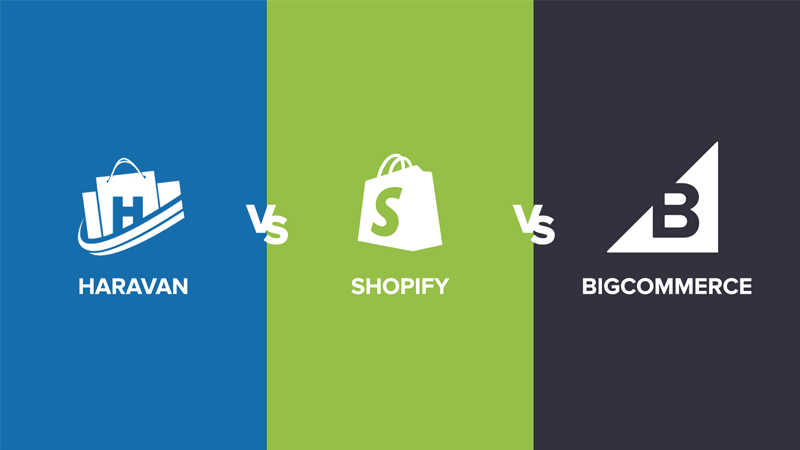
Businesses that solely conduct business in Vietnam may choose to use Haravan to take advantage of cost-competitive benefits and functionalities tailored to suit Vietnamese shopping habits. Shopify and BigCommerce are options to explore if you want to develop your business worldwide. Simultaneously, Shopify is ranked higher for providing great 24/7 live chat support, which will aid companies in addressing difficulties as quickly as possible. As a consequence, Shopify will be ideal for large-scale and high-volume enterprises. BigCommerce, on the other hand, compresses functionality into more affordable solutions and is not restricted to the number of administrators like Shopify, making it suitable for small or medium-sized businesses.
However, using SaaS eCommerce platforms like Haravan, Shopify, and BigCommerce in the long term would result in the following deficiencies:
- Duplicate design ideas: Using the given interface will easily be similar to other websites, making it hard to show the brand’s distinctive qualities.
- Difficult to customize functionality: Because these platforms are not as flexible as Open Source eCommerce platforms, firms may only select from existing options and customize to the extent permitted. In the future, it will be essential to change to build advanced and specialized functions based on the features of products and industries to meet the demands of customers and the expansion of companies through time. Switching to an Open Source eCommerce platform such as Magento, OpenCart, WooCommerce, etc will take a significant amount of time and money.
- A lot of fees: Because of the monthly charge, the longer you use it, the more expensive it is to use the website. Furthermore, Shopify and BigCommerce impose extra fees based on online revenue.
- Do not own the source code: If the contract with these platforms is canceled, the company will no longer utilize the source code of the website and will have to rebuild it from scratch on the new platform. Switching platforms is not only time-consuming and expensive, but it may also result in data loss or misalignment.
SECOMM has significant experience developing complicated eCommerce websites in different countries, and we know the challenges that businesses face when selecting and implementing an e-commerce platform.
Contact SECOMM for a free consultation on eCommerce website development!
 2
2

 4,498
4,498

 0
0

 1
1
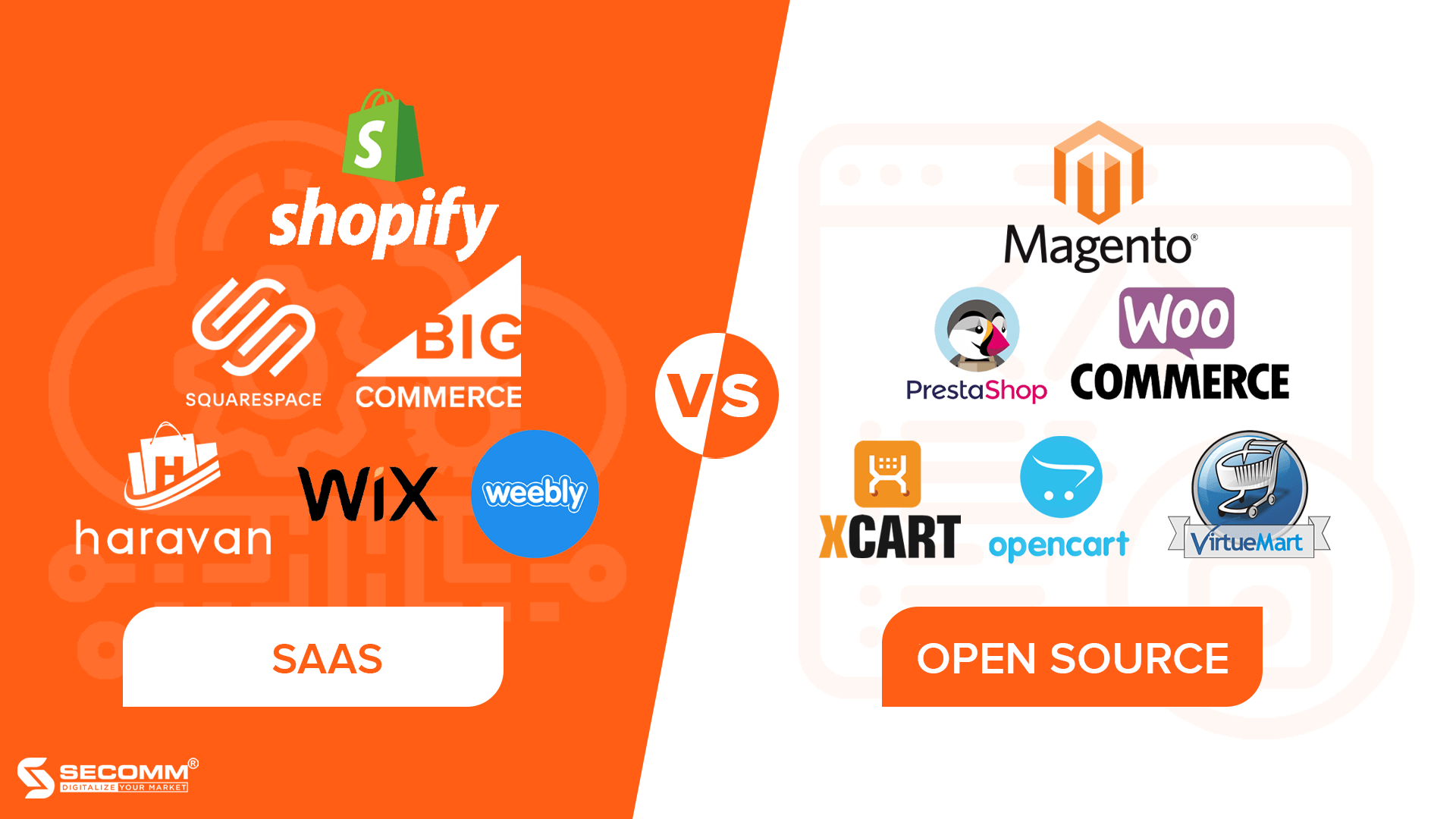
SAAS ECOMMERCE PLATFORMS VS OPEN SOURCE ECOMMERCE PLATFORMS
SaaS eCommerce Platform
A SaaS eCommerce Platform is a service delivery paradigm for developing a software-based website system. Data is kept on the provider’s server system under this approach, and that platform is in charge of dealing with technical concerns for the business.
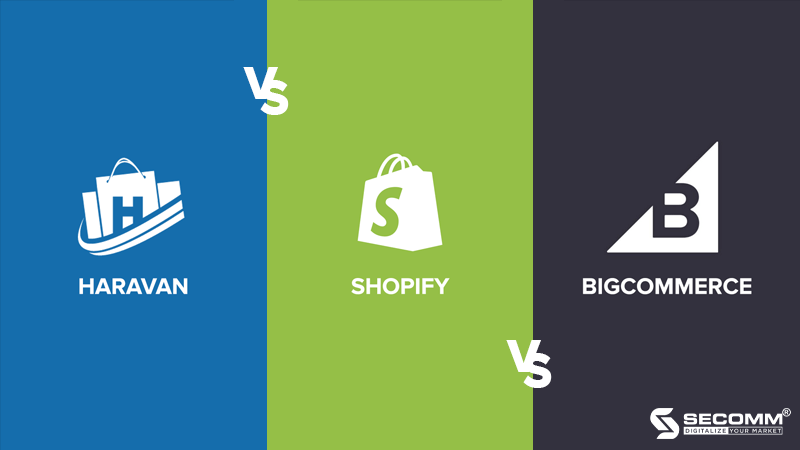
Advantages of SaaS eCommerce Platform
Available eCommerce system
The provider pre-designs the SaaS platform for the full system, from hosting, interface, and features to technological infrastructure maintenance. As a result, organizations can quickly create and manage a website system without worrying about technological concerns.
Furthermore, the platform developer offers firms 24/7 assistance through live chat, desk help, or a hotline while the platform is in operation.
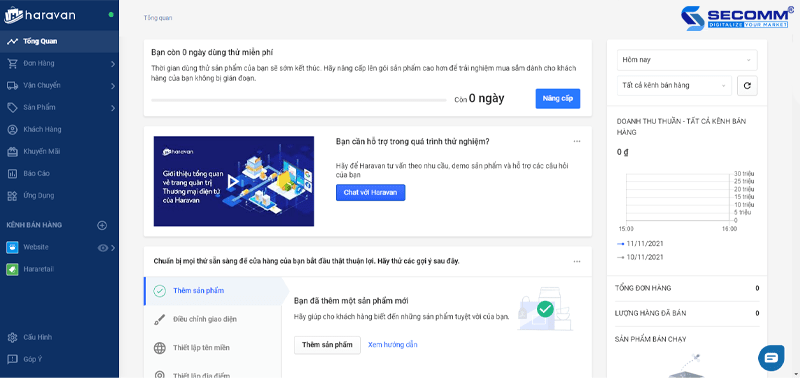
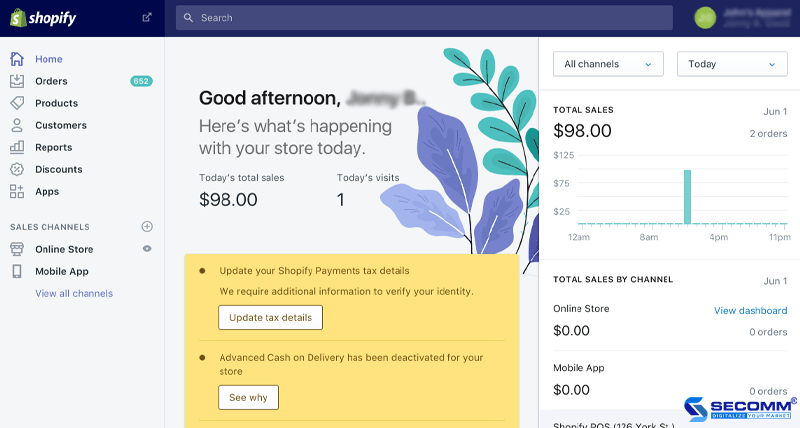
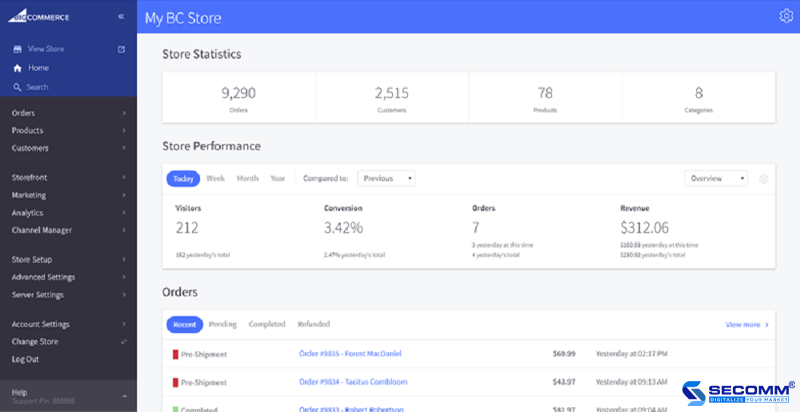
Various interfaces and functionalities
The SaaS eCommerce Platform includes a multitude of functionality and appealing UX/UI interfaces, making it suitable for a variety of businesses.
Furthermore, these platforms include a wide range of essential eCommerce functions, including product administration, order management, customer management, marketing, business analysis, and reporting to let firms quickly develop an e-commerce website. Moreover, extensions such as Omni-channel, Affiliate Marketing, E-Payment, E-Logistic, and so on are constantly added to these platforms to strengthen the e-commerce system.
Quick implementation
The time it takes to establish a website on a SaaS eCommerce Platform is quite fast, ranging from 1 to 7 days on average, depending on the website’s setup.
Affordable investment budget
The initial building cost is pretty cheap because firms would pay monthly or yearly use fees (subscription-based) to establish a website using SaaS eCommerce Platforms, such as:
- Haravan:
- Standard (200,000 VND/month): Appropriate for independent sellers
- Pro (600,000 VND/month): For organizations who wish to implement Omnichannel
- Grow (1,500,000 VND/month): For firms need automating processes to take care of and resell current customers
- Scale (3,000,000 VND/month): Help establish loyal customers
- Shopify:
- Basic Shopify ($29/month): Suitable for new businesses with small sales.
- Shopify ($79/month): Appropriate for growing online enterprises
- Advanced Shopify ($299/month): Ideal for firms that need to expand and want advanced reporting capabilities.
- BigCommerce:
- Standard: $29.95/month for businesses with more than $50,000 in revenue
- Plus: $79.95/month for enterprises with more than $180,000 in revenue
- Pro: $299.95/month for companies with more than $400.000 in revenue
- Enterprise: For firms with high sales volumes, costs will be calculated depending on the brand’s online sales
Aside from the monthly/yearly licensing charge, businesses must pay extra expenditures such as interface fees, new features, expanding the number of backend users, and POS (Point of Sale) to grow the eCommerce system.
Disadvantages of SaaS eCommerce Platform
Having no control over the source code and data
Because the enterprise’s whole website system is housed on the provider’s server, ownership and control of the website source code will belong to that platform, not the firm. Businesses who transfer platforms can no longer utilize the previous site source code and must rebuild from scratch on the new platform. Moreover, data loss or misalignment is usually unavoidable.
The enterprise’s data, like the source code, is likewise kept on the provider’s server, thus ownership and control over the data remains constrained. There are many difficulties for not owning and controlling data, such as linking data between departments, customizing users, and so on.
Poor scalability and flexibility
Because the website system depends on the SaaS platform, customization and expansion are currently limited. When it comes to upgrading existing features, developing new functions for the company’s development, in line with the particular requirements of the product and industry, and optimizing the user experience, SaaS platforms are frequently unable to adapt. As a result, switching platforms after a period of usage is unavoidable, and of course, this change will take significant time and money for the company.
Usage costs increase over time
Because you must pay monthly or yearly license fees, the longer you use the higher the overall cost of use. Furthermore, the SaaS eCommerce Platform charges on the revenue online sales.
For example, various Shopify apps, such as DCart (Create Discount Codes on Cart), OctaneAI (Similar Product Suggestions), Ali Reviews (Product Reviews), and others, would charge a monthly fee, average $10 /month/features. The more applications that are installed, the more the monthly or yearly expenses will be.
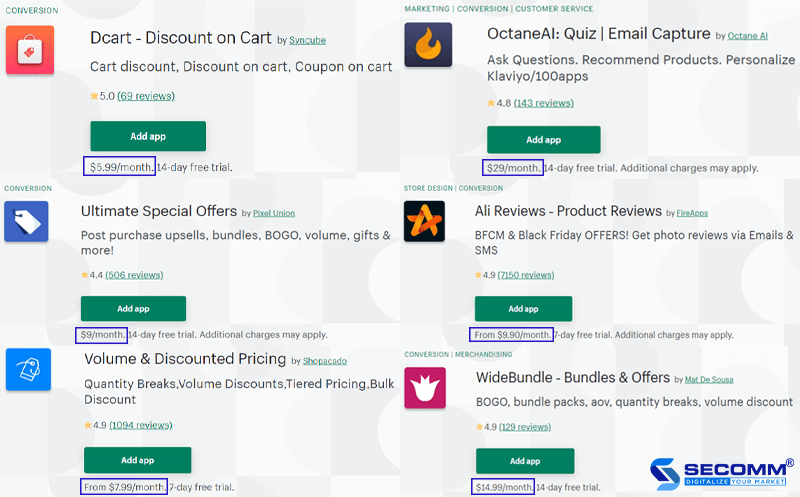
Businesses can use the SaaS platform if they wish to enter the e-commerce industry rapidly, have minimal need for customization, and do not need to enhance the system. As a result, SaaS systems are frequently selected by startups, SMEs (small and medium enterprises), and businesses just getting started in the e-commerce industry.
Open Source eCommerce Platform
Open Source is software whose source code is publicly available and freely used by anyone.
Because the data and source code will be housed on a separate server system, Open Source eCommerce Platforms have the opposite aspects of SaaS platforms. Businesses that use open source platforms must collaborate with professional website developers or build a highly specialized in-house team for the website system to achieve maximum efficiency.
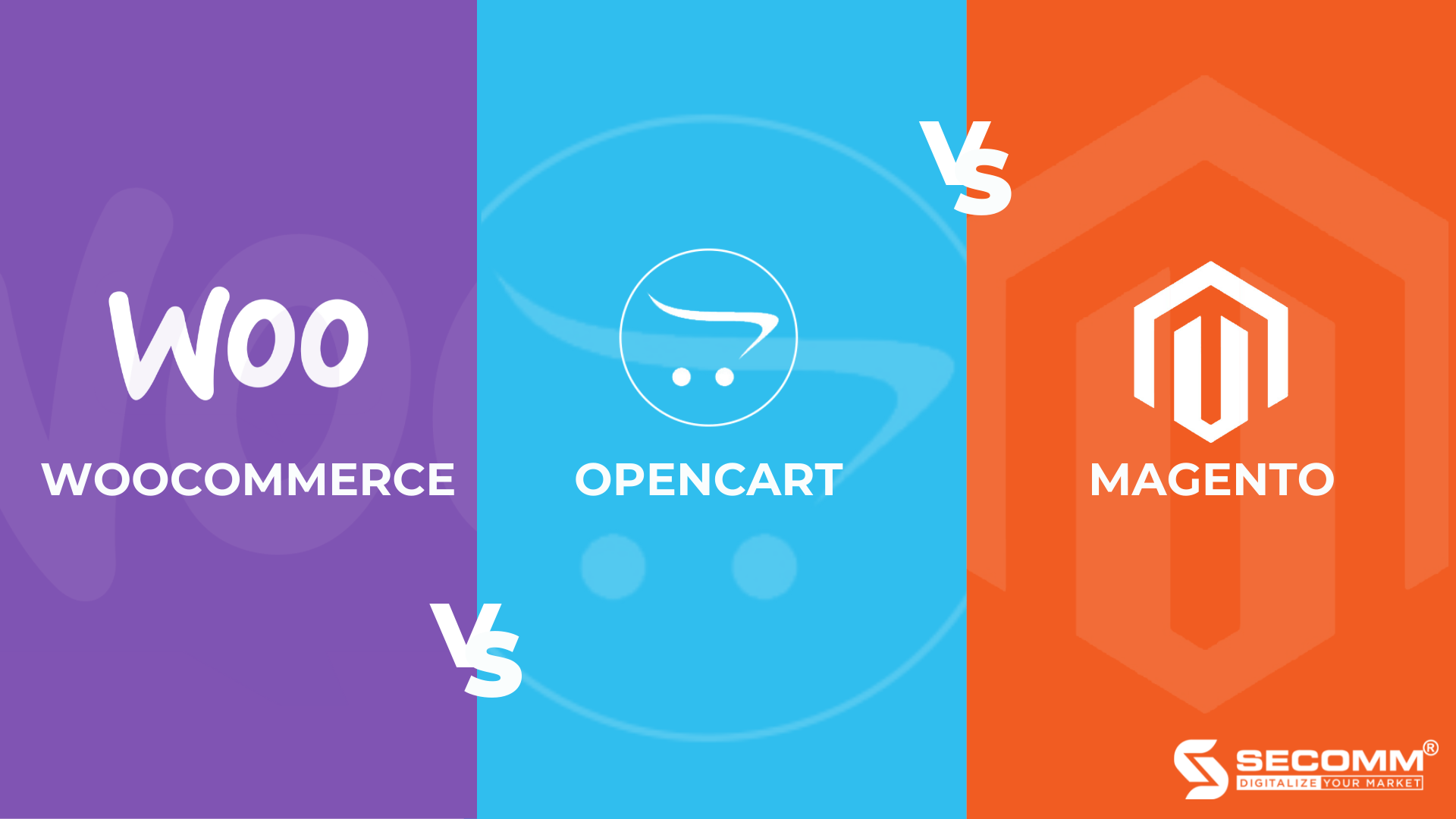
Advantages of Open Source eCommerce Platform
Control the data and own the source code.
Businesses have complete ownership and control over the source code and data on the system due to the characteristic of being housed on a separate server system. As a consequence, while deploying an eCommerce website, companies only need to pay development expenses in order to utilize the source code, rather than monthly/yearly license fees just like SaaS platforms. At this point, you could reuse the previous source code if you change developers or platforms. Furthermore, security is improved, reducing hacker attacks, server failures, and technical faults from staff and consumers.
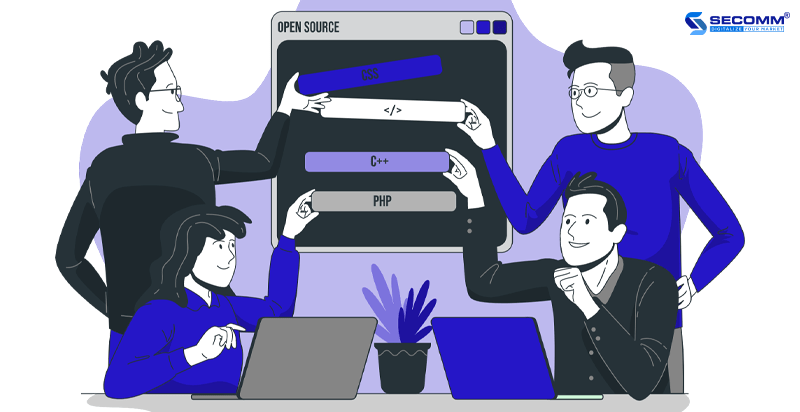
Customize the interface to meet your requirements.
Businesses have more choices in developing their website’s interface to boost brand image and maximize revenue since they use Open Source eCommerce Platforms.
Currently, there are three methods for designing interfaces:
- Use pre-existing themes: Like SaaS platforms, organizations can select and use pre-existing themes from the market, development community, or cooperation unit. This method will help businesses save the most money since a standard UX/UI theme costs between $50 and $200 on average.
- Customize the interface based on an existing theme: Similar to the preceding method, but instead of purchasing and using the same theme, firms may design their own traits by rewriting the website’s code at the front-end. Since then, organizations have cut expenses while also expressing their own distinct characteristics.
- Create your own user interface: To effectively position the brand on the website, the interface should be created individually. This is typically more expensive than utilizing a theme, but it addresses the most particular and specific requirements of the company.
Full of features and add-ons
In terms of website system features, Open Source eCommerce Platforms are quite superior to SaaS platforms. Not only have basic functions, but Open Source eCommerce Platforms also have many advanced features such as quick search, similar product suggestions, abandoned cart notifications, real-time products, and so on.
In addition, the Open Source eCommerce Platforms also has many add-ons that are improved, provided, and shared by the developer community.
Great flexibility
Because organizations control their own source code, they can simply update the functional system, build new features, or expand the system to suit business demands and meet consumer needs. At the same time, the open-source code’s flexibility allows businesses to easily link with third-party utilities in order to run the system.
Disadvantages of Open Source eCommerce Platform
Require a professional team or experienced developer
It is hard to build “tailor-made” systems for each firm with a system of various e-commerce features ranging from basic to complex, therefore systems developed on open source e-commerce platforms frequently have high accuracy. As a result, in order to build and function efficiently, a specialized team or development organization must have strong knowledge and several years of experience.
Prolonged setup time
Deployment times for open source e-commerce platforms are frequently lengthier than those for SaaS platforms. Depending on the complexity of the functional system, the average amount of time for the IT team to build a website varies from 3 months to 1 year.
Expensive development
Using an open-source platform is basically free, but having a full e-commerce system from website to mobile app needs a significant commitment of your own labor. The in-house IT team will design interfaces and functions. As a result, the initial cost of developing an e-commerce website using an open-source platform is pretty expensive, an average of $10,000 per project.
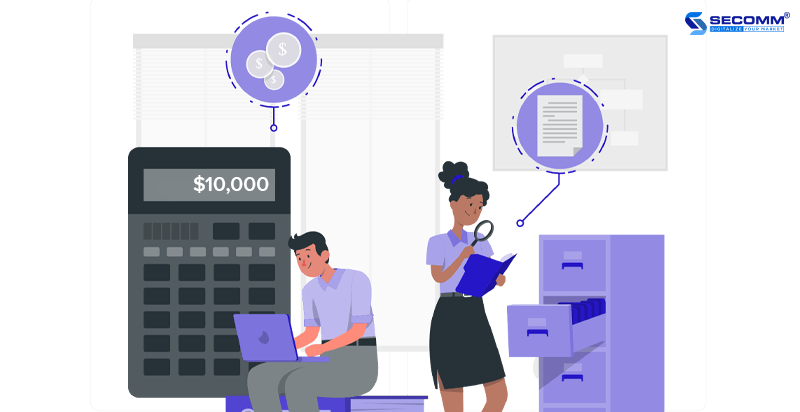
The Open Source eCommerce Platform is suited for all sorts of enterprises due to its numerous features. However, budget and implementation time restrictions have kept many small and medium-sized businesses from utilizing it. Large firms frequently engage in these platforms to construct specialized and specialized eCommerce systems.
In general, the decision of which eCommerce platform to select will be determined by each firm’s business plan, budget, and time of eCommerce development.
 2
2

 4,171
4,171

 0
0

 1
1
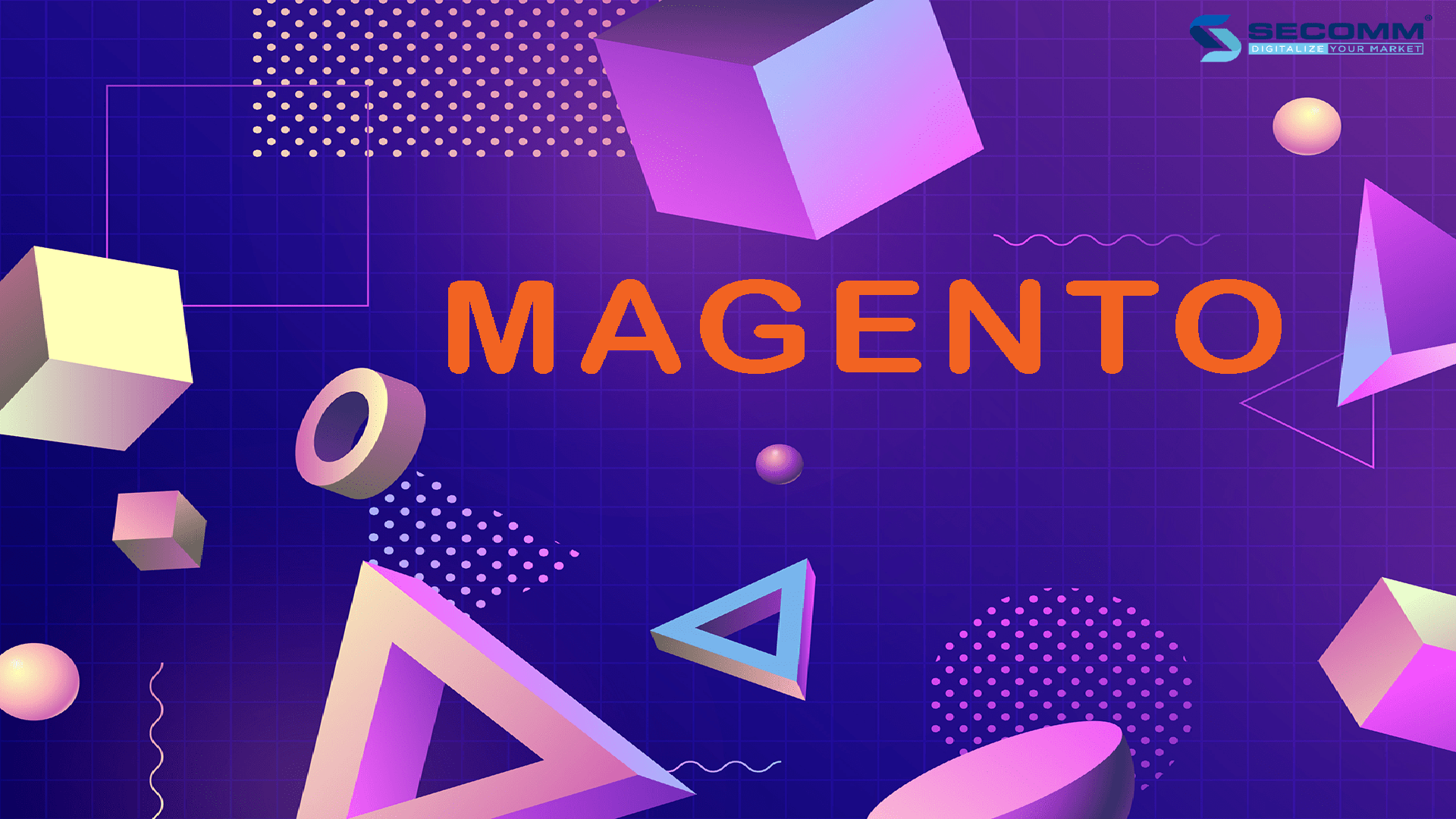
A LOOK BACK ON THE MAGENTO TIMELINE
1. Highlight functions of Magento that reign the ecommerce Market
A huge range of Magento functions not only conquers the interest of the web developer community but also reigns the world as one of the leading ecommerce platforms. Talking about its various highlight power, the ecommerce market is probably the place to get benefits from this platform.
PWA Studio of Magento (Progressive Web App)
With the amazing benefits of PWA, Magento developers cannot afford to miss this special opportunity. Then, Magento PWA Studio was born as an interface solution for ecommerce websites based on the Magento platform. With fast page load time, optimal performance, Magento PWA Studio has provided the best user experience, making ecommerce web pages more reliable and consistent across devices.
Great scalability
One of the salient advantages of Magento is the ability to add more extensions depending on specific user needs flexibly. That highlight makes Magento very suitable for different online businesses with various commerce activities. With this feature, website developers can integrate most extensions, including free or paid versions, to customize Magento with the best performance.
SEO maximization
One of the important functions of the open-source platform is to integrate features supporting SEO maximization. Magento is considered to be a platform that implements SEO tools completely from product catalogs to independent products.
2. Recollecting the Magento timeline
Let’s take a look at the timeline of Magento from the very first launching in 2007 to the new upgraded versions during 2011 – 2018.
Magento timeline: 2007 – 2010
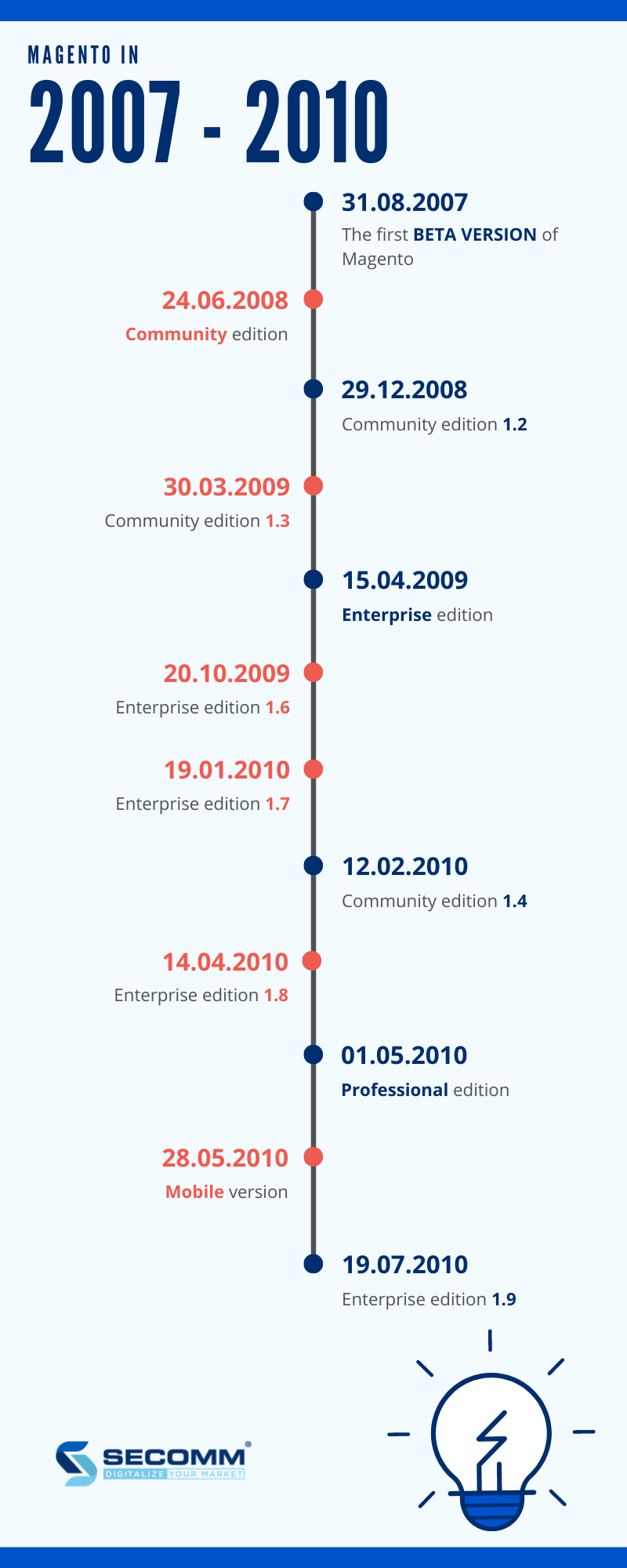
2011 – 2015
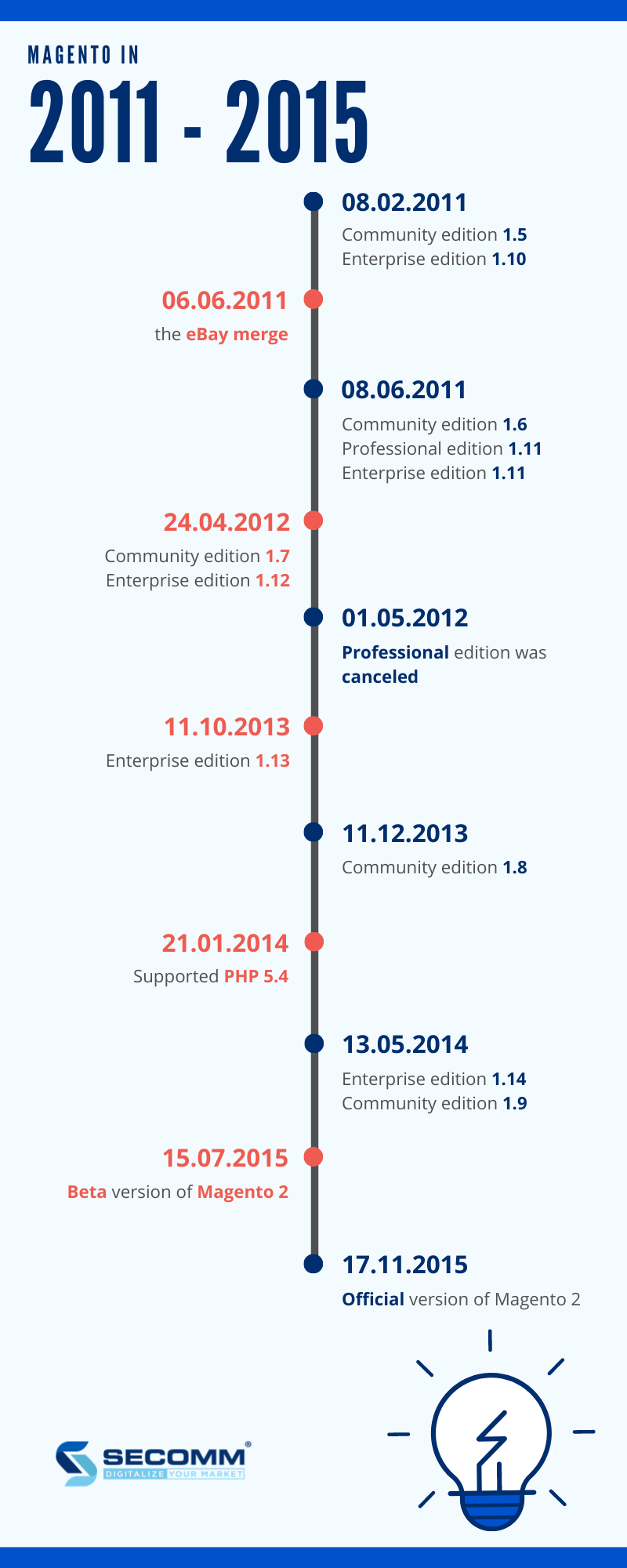
2016 – 2018
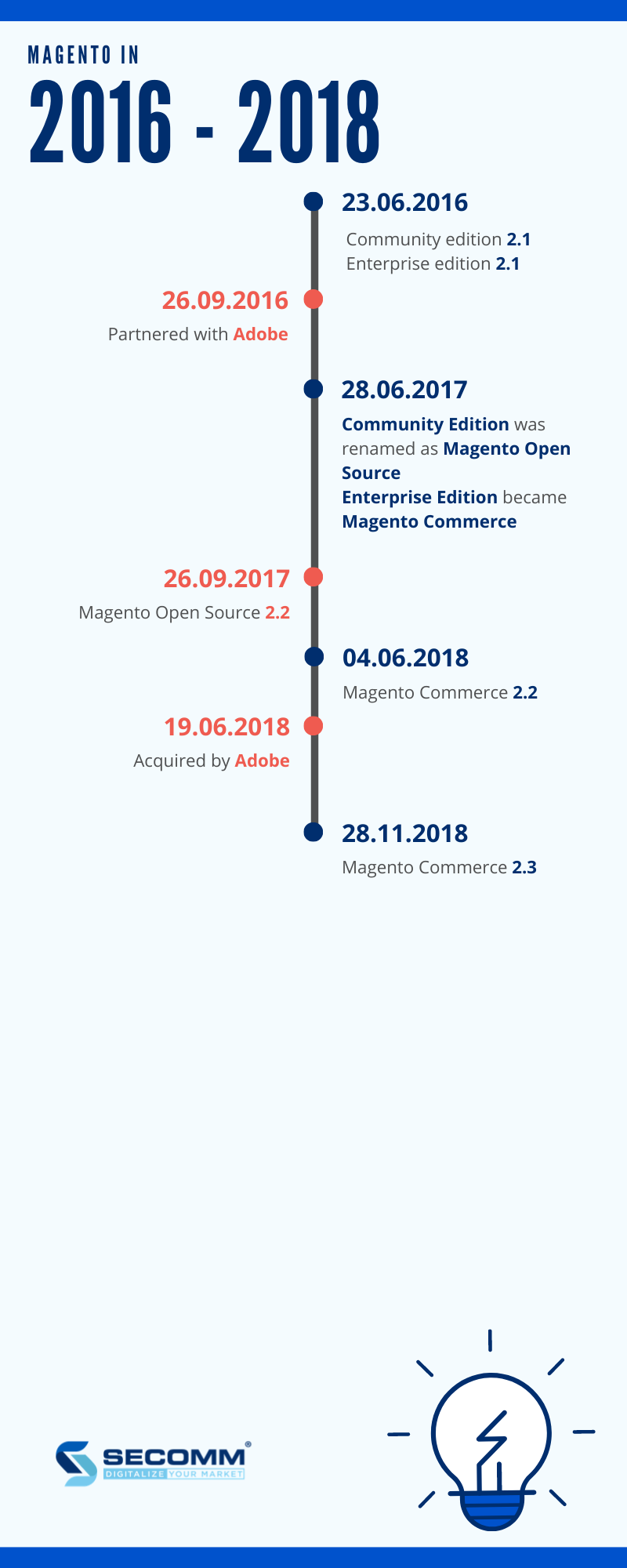
3. Facts about the Magento platform
Still, the platform is constantly being improved to meet the Magento user community’s diverse needs around the world. Truly, Magento has brought a lot of convenience and breakthroughs to the ecommerce website development industry. Below are magnificent facts about Magento you may not know.
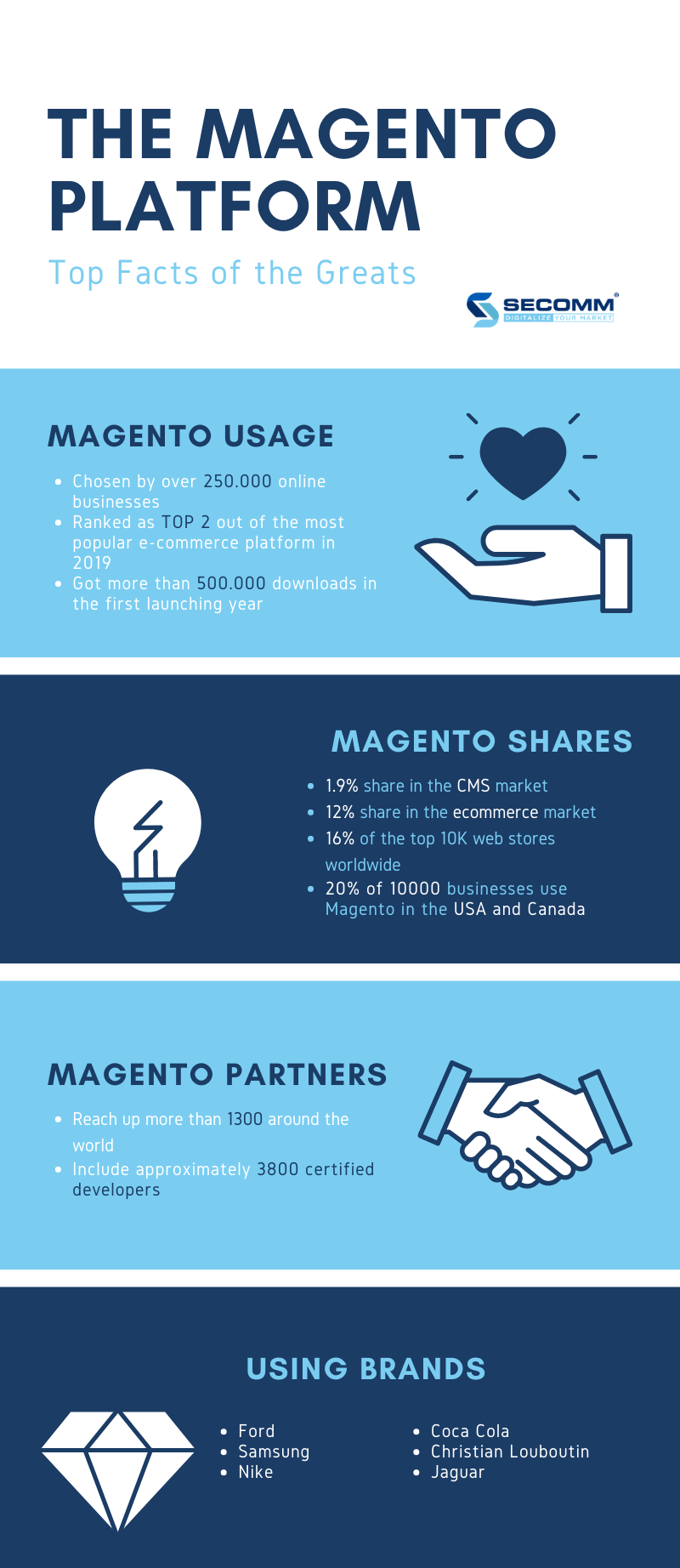
With 8-year-experience in Magento, our SECOMM team has used Magento effectively to create solutions for partners/businesses. Magento timeline includes a huge amount of needs for the user community: beautiful and diverse themes, UI/UX design, security, effective cost, and so on. Especially in Vietnam, Magento is exactly the perfect tool to help ecommerce businesses control most of the features for online stores.
 2
2

 2,594
2,594

 10
10

 1
1



